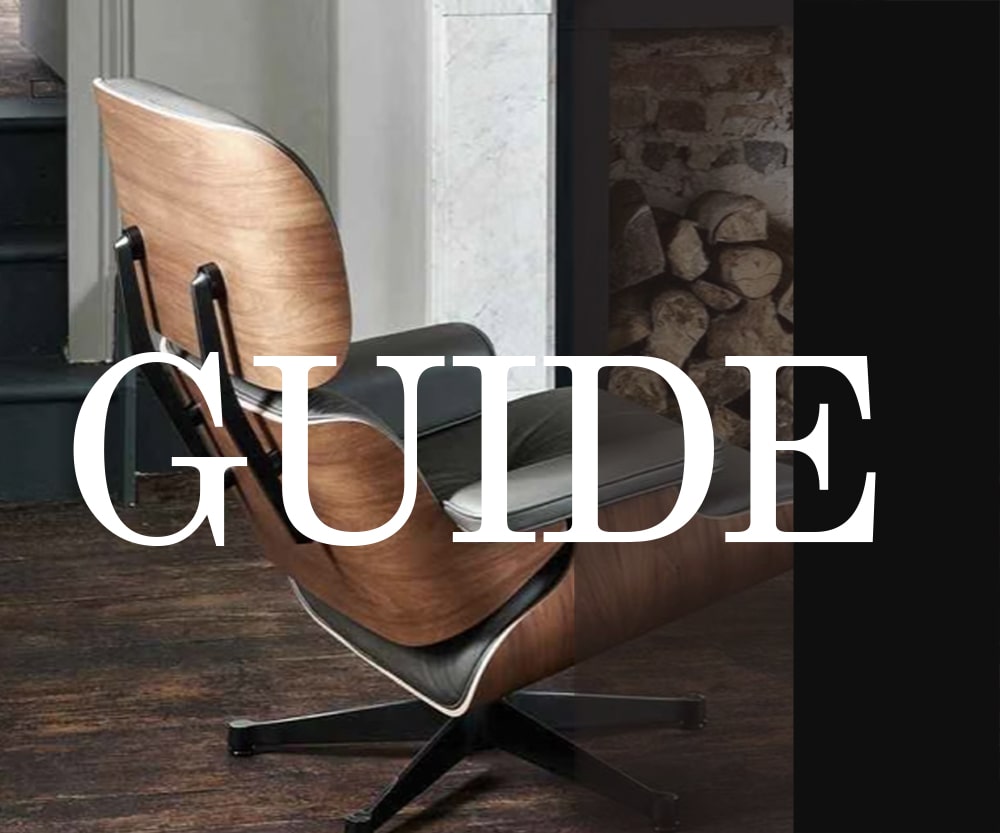
Find the style that feels like you
Choosing an interior style can be confusing — Scandinavian, Modern Classic, Japandi, Loft… so many names, and each hides a world of atmosphere and emotion.
This guide is not about strict definitions. It’s about helping you recognise what resonates with you — the colours you feel comfortable with, the textures you’re drawn to, the mood you want to live in every day.
Browse through our examples to see how different styles express personality, comfort and function. You don’t have to choose one forever — your home can mix influences and evolve over time. And when you’re ready, we’ll help you turn that vision into a real, living space.

Find the style that feels like you
Choosing an interior style can be confusing — Scandinavian, Modern Classic, Japandi, Loft… so many names, and each hides a world of atmosphere and emotion.
This guide is not about strict definitions. It’s about helping you recognise what resonates with you — the colours you feel comfortable with, the textures you’re drawn to, the mood you want to live in every day.
Browse through our examples to see how different styles express personality, comfort and function. You don’t have to choose one forever — your home can mix influences and evolve over time. And when you’re ready, we’ll help you turn that vision into a real, living space.
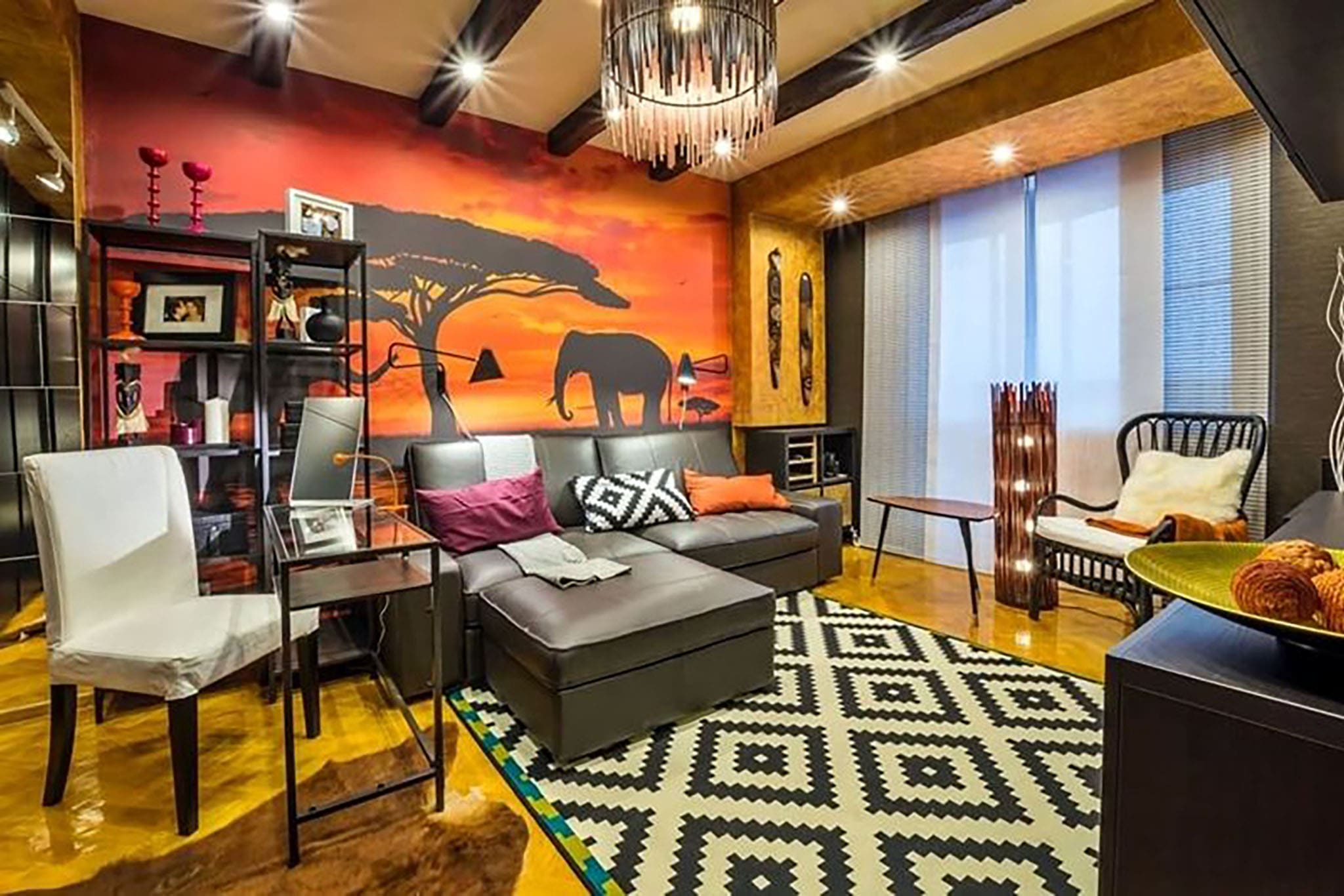
African - wild and uninhibited
The desired impression is achieved with rough plaster, ebonite, scarlet, red paint, jungle and savannah shades.
The furniture is low, with a hint of artisanal, primitive design. A fireplace, decorated as a hearth, is appropriate, as well as torch lights.
To enhance the effect, fabrics with Nigerian and Congolese ornaments, leopard and zebra prints, terracotta figurines of totem animals and wooden masks are used.
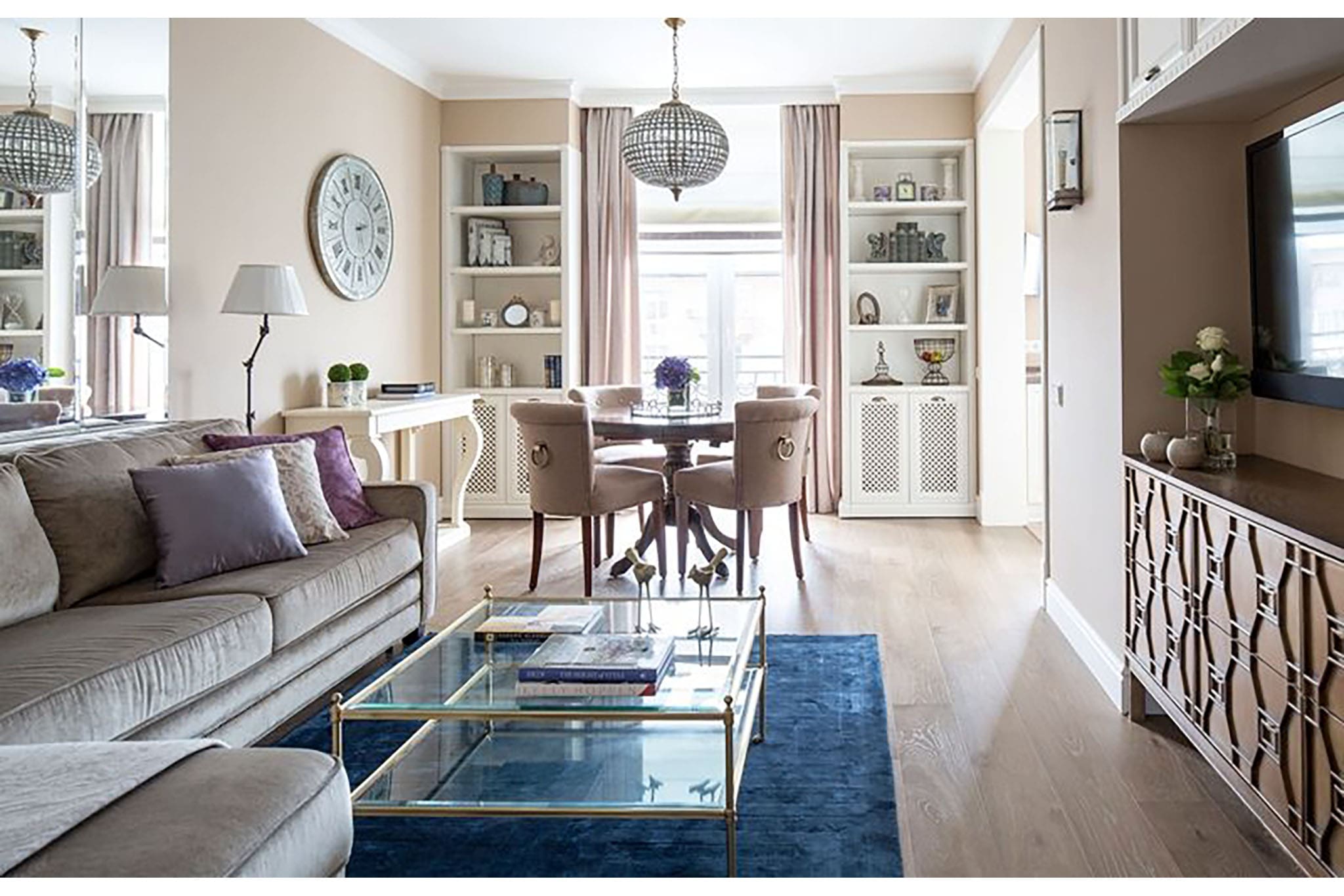
American - durable and family friendly
Its characteristic features are: no hall, kitchen combined with the living room, wooden pilasters, cartouches, rosettes on the furniture fronts.
The materials are both traditional and plastic, imitating luxury.
The colors refer to the room: variations of brown, pistachio, olive, soft blue.
A must-have in the living room is a sofa, spacious armchairs and an elegant chandelier. The kitchen is island style, usually with a breakfast bar.
American interiors are liberal and flexible. True riches and antiques are combined with penny heirlooms; the characteristic elements are family photos and sports trophies.

Ampire - haughty and pretentious
Its peculiarity is painted ceilings with medallions, luxurious furniture set along the walls, huge mirrors, the presence of military, heraldic, triumphal attributes: shields, coats of arms, laurel wreaths.
The material basis of the "imperial" style is precious wood, polished stone, bronze, tapestries and expensive fabrics.
Gold, sapphire, ruby, amethyst and other "jewelry" colors dominate.
When it comes to furniture, choose soft objects with carved backs and shapely legs, oval and round tables, monolithic cabinets with pilasters, bure with floral ornaments.
Floor mirrors, goblets with curved necks, cylindrical pedestals and glasses, and elegant musical instruments are iconic pieces.
Central lighting is provided by chandeliers, side lamps in the form of large candelabras.
Battle paintings and antique statues complete the decor.
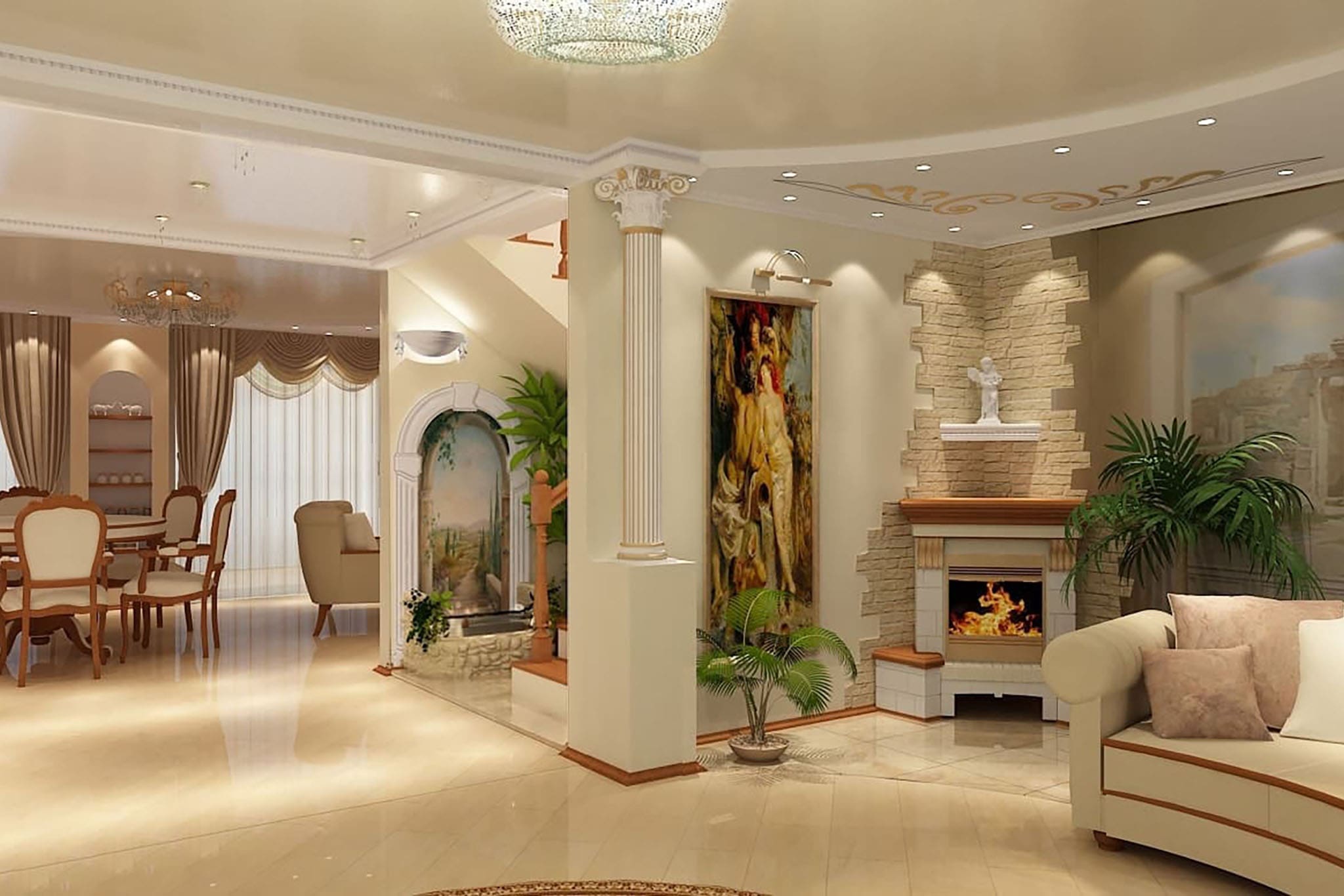
Antique - on a large scale and on a grand scale
Features: columns, niches, arches, carvings, frescoes, moldings, drapery, a fireplace with a rectangular portal.
The materials are polished stone, shiny tiles, smooth wood.
The palette is dominated by shades of clay, sea, pebbles and sand. Waves, shells and Greek meanders are used as decorations.
The equipment includes chests of drawers and tables with footstools, benches and benches.
The central chandelier is large but not bulky, with exquisite plafonds. A lot of side lamps, creating a vintage atmosphere.
The decor is scattered on the walls, ceiling and furniture. There are paintings, bas-reliefs and mosaics, fragments in the form of atlantes and caryatids.
The interior is detailed with scaled-down copies of antique statues, amphorae and ceramic bowls.

Art Deco - chic and bohemian
Its special features were bold geometry, massive forms, an abundance of facets, as well as references to geography, archeology and industrialization.
Typical resources of this style include polished wood with a refined texture, glass, steel, aluminum and chrome.
Iconic works - stained glass windows, mirrors, bent consoles, half-round chests of drawers, screens with brass inlays, floor lamps, gilded and silvered details.
The colors are a combination of black and gold, black and white, grey, beige and burgundy.
The décor is detailed and exotic: table lamps, "wild" hides, knick-knacks made of decorative stones, chests made of crocodile skin, miniature replicas of historical buildings and artifacts.
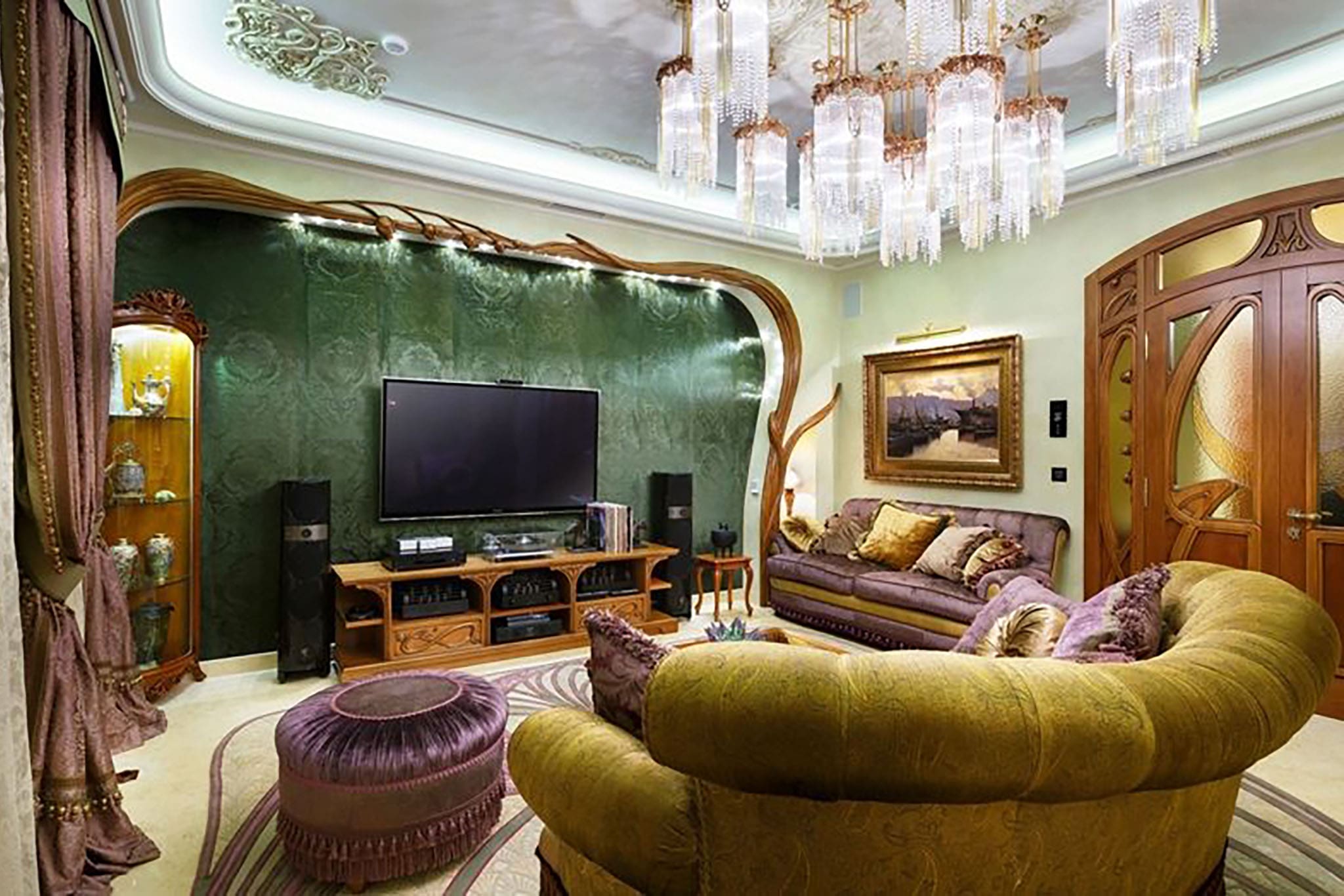
Art Nouveau - pampered and dreamy
In different countries, Art Nouveau was called in different ways, for example: in Germany Jugendstil, in France Fiendesieck, in the Czech Republic and Austria - Sotsesion, in Russia - Art Nouveau.
Peculiarities: the refusal of right angles, accurate verticals and horizontals, imitation of plant forms, ornate patterns.
The decoration includes bent wood, plaster plastic, wallpaper with frequent floral prints.
The furniture has whimsical outlines; Typical of the furnishings are sofas with fluid, "feminine" forms, Viennese chairs, shelves, shapely cupboards.
The palette is softened, smoky: dusty pink, tobacco shades, matte pearls.
Accessories and decorations include a mother-of-pearl chandelier, table settings painted with vines and dragonflies, figures of dancers and athletes, peacock feathers.

Avant-garde - dynamic and rebellious
Style features: advanced and mass-produced materials, one-piece finishes, color and texture contrasts, no halftones.
The avant-garde always breaks with patterns, so instead of walls and doors, it builds arches and catwalks, zoning the space with large objects.
The furniture consists of pull-out tables, wardrobes and poufs of an original shape.
Iconic pieces such as the Diamond Chair, Panton Chair and ZigZag chair also highlight the style.
The palette consists of a base tone and blocks of radical red, yellow, plum and ultramarine.
Lamps and LED strips are used to create compositions and installations.
Accessories and decorations include surreal or abstract art and large glass vases.

Baroque - theatrical and pompous
Features that delight with opulence, passion, forms and capitals, columns, intricate patterns.
The materials are expensive and exclusive: stone slabs, stained wood, tapestries, silk-screen printing, embossed velvet and monograms. Stucco and paintings decorating the ceiling "flow" onto the walls. The floors are parquet or marble.
There are no trivial objects in Baroque, each work is a piece of art. Scroll mirrors everywhere, sofas with wavy backrests, carved, inlaid tables, armchairs on animal legs, chests of drawers with "gold" fittings.
The colors combine chocolate and pink, velvet blue, white, green, shades of Marsala and gilding.
A chandelier with lots of crystal trinkets and gilded sconces light up the atmosphere. The windows are covered with heavy double hem curtains.
Cupids, psyche, floor vases, statuettes of heroes in tense dramatic poses, porcelain jugs, reproductions of Caravaggio, Bruegel and Rubens complete the picture.
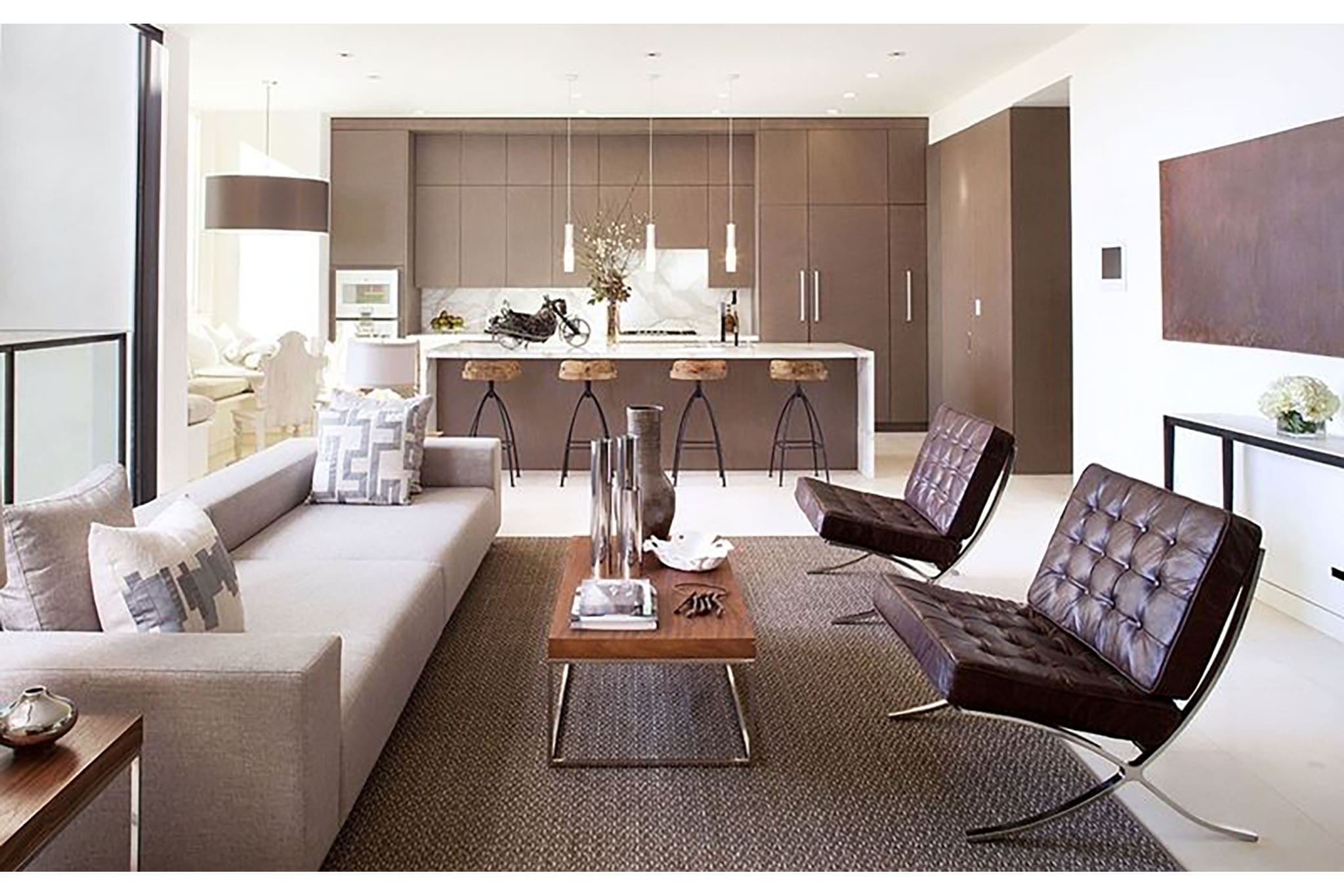
Bauhaus – simplified and ergonomic
Features: geometricism and rhythm, minimalism, budget availability, rationality.
Materials: glass, metal, softened with wood and leather.
Bright, square, rectangular, round furniture. This style is characterized by transformer tables, modular cabinets and aluminum shelves. Iconic pieces include the Barcelona chair, the Brno chair and Josef Pohl's wardrobe.
The palette is rich, with bright accents; there are few textiles, and accessories are cleverly placed lamps and appliances.
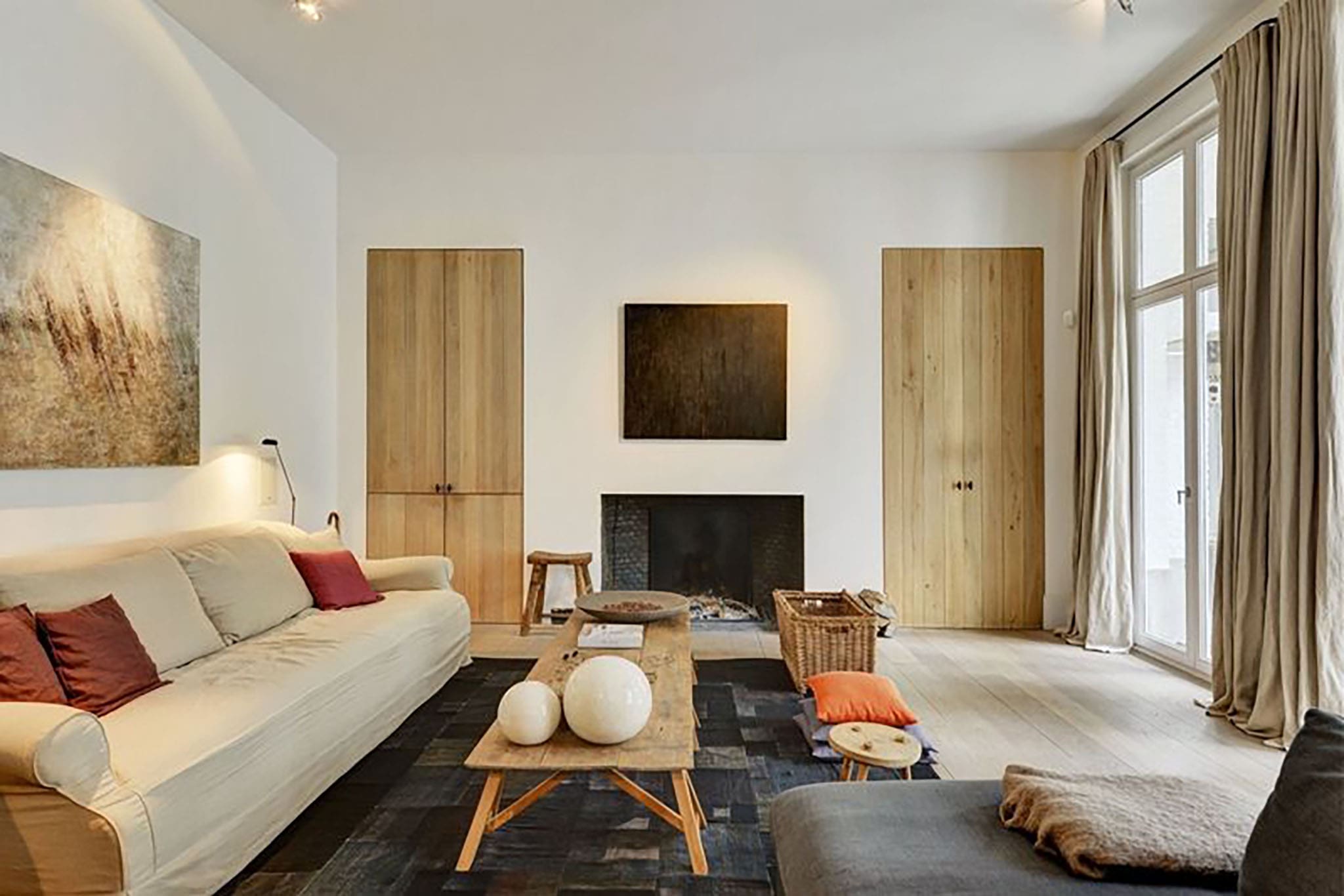
Belgian – economical and spiritual
Its special features are moderation, predilection for natural materials and textures, harmony between retro and contemporary elements and the universality of fabrics.
Sustainable materials, wood and its modifications, plaster, glass, stone.
Preferred colors are beige, white, sand, smoke, blue.
Sofas and chairs with covers, patinated chests of drawers and wicker armchairs indicate this style.
Accessories include a Flemish chandelier, wrought iron lamps, baskets, layered linen tablecloths.
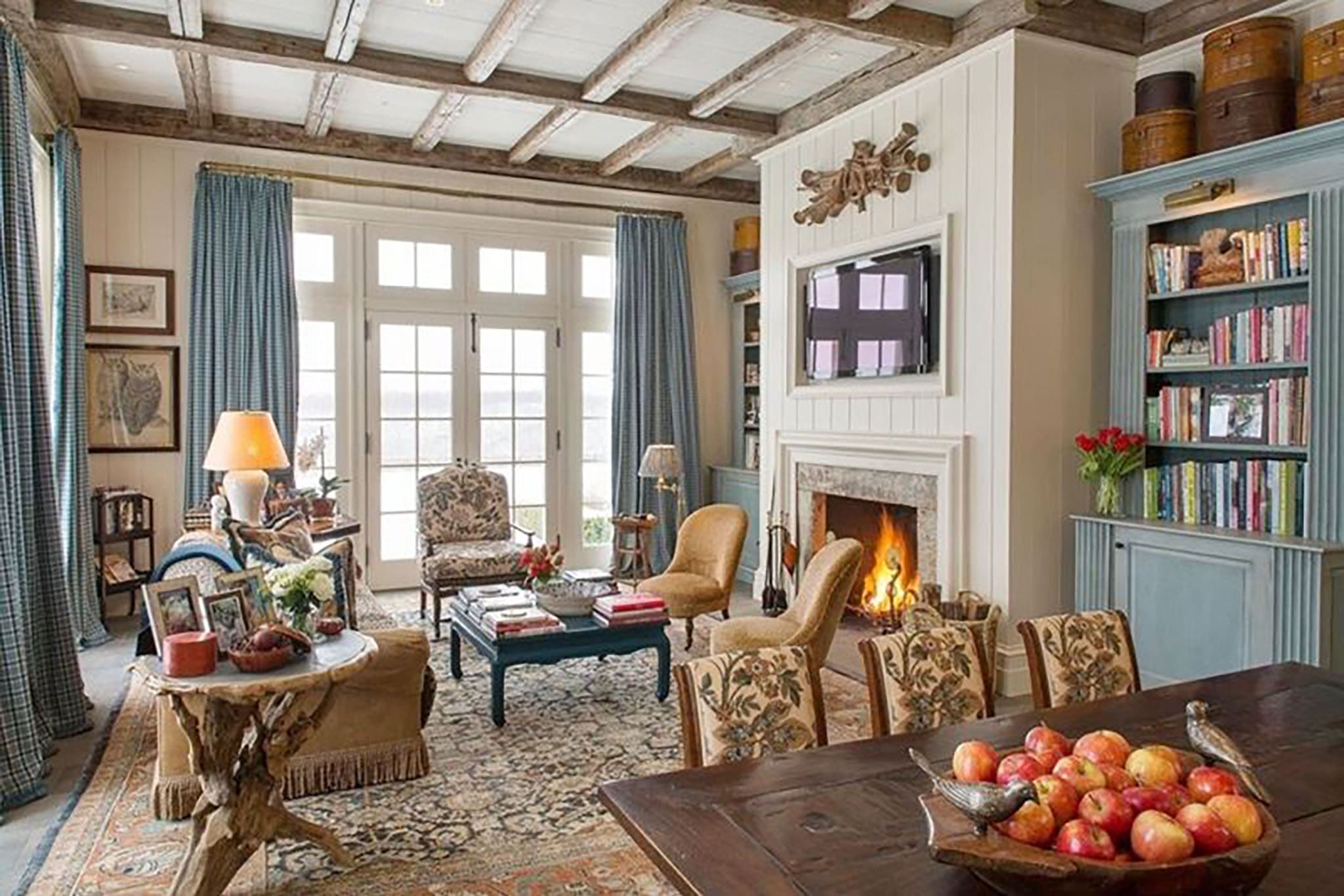
Biedermeier - modest and sentimental
Characteristic features: classic composition (furniture along the walls), perfect proportions, integrity of the surroundings, intimate atmosphere.
The materials are simple: boards, plaster, striped wallpaper.
The furniture is of high quality, with impeccable craftsmanship. Sliding tables, writing cabinets, chests of drawers and stools that transform into stairs dominate.
The color range is homely warm without being bloated, the textiles are uncomplicated and practical.
The decoration consists of embroidered napkins, piggy banks and figures of pastorals.
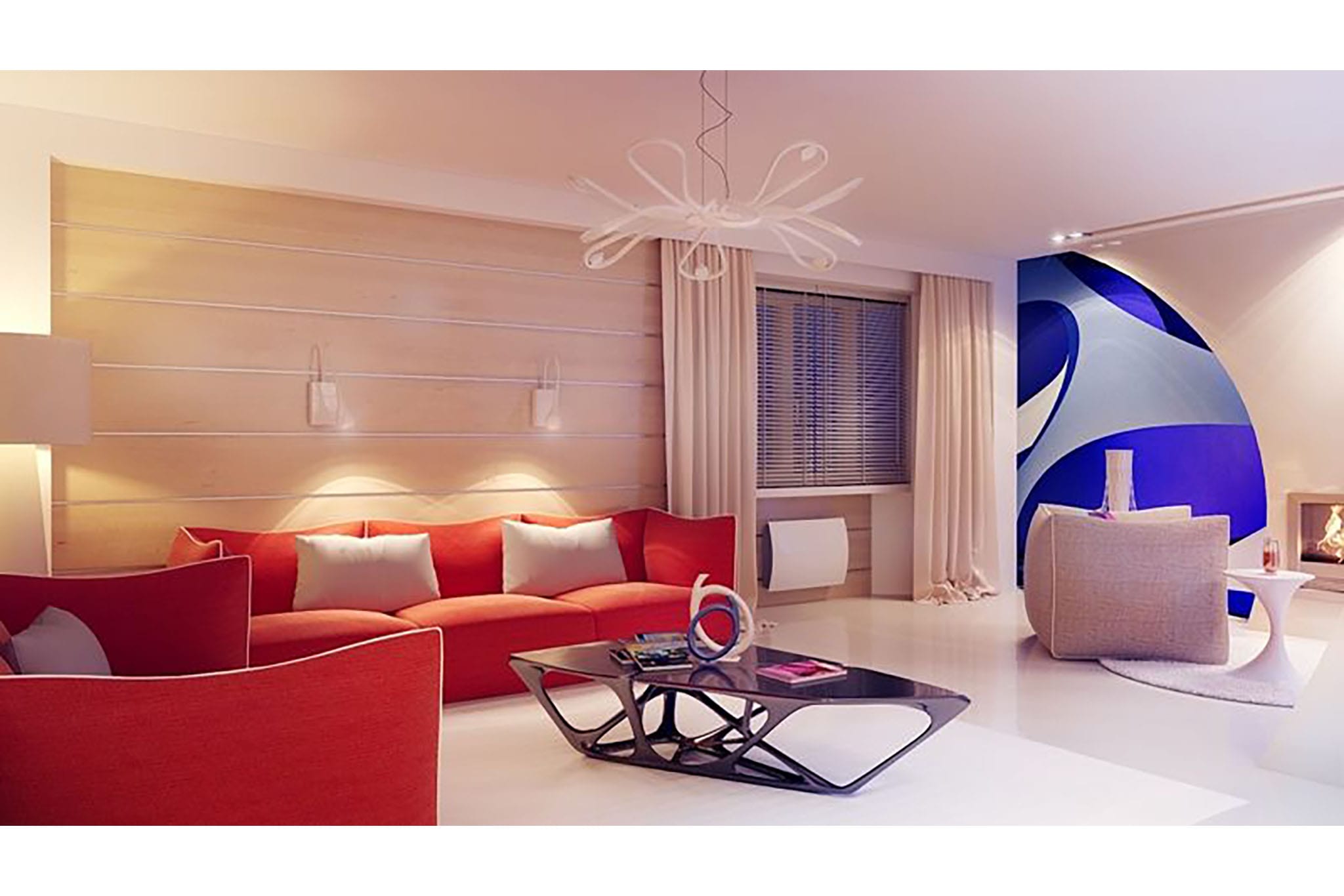
Bionics - free and ecological
Characteristic features are curved and arched lines, mirror textures, symbiosis of natural and synthetic raw materials.
Materials - smooth wood, flexible stone, smart glass, eco-leather.
The colors are pure, imitating trunks, sky and leaves.
The layout is loose, partitions and furniture have a honeycomb structure, pores, roots, bubbles. The lighting fixtures are creative, many built-in and hidden.
The decor is lush greenery, panels of stabilized moss and "live" plant walls.
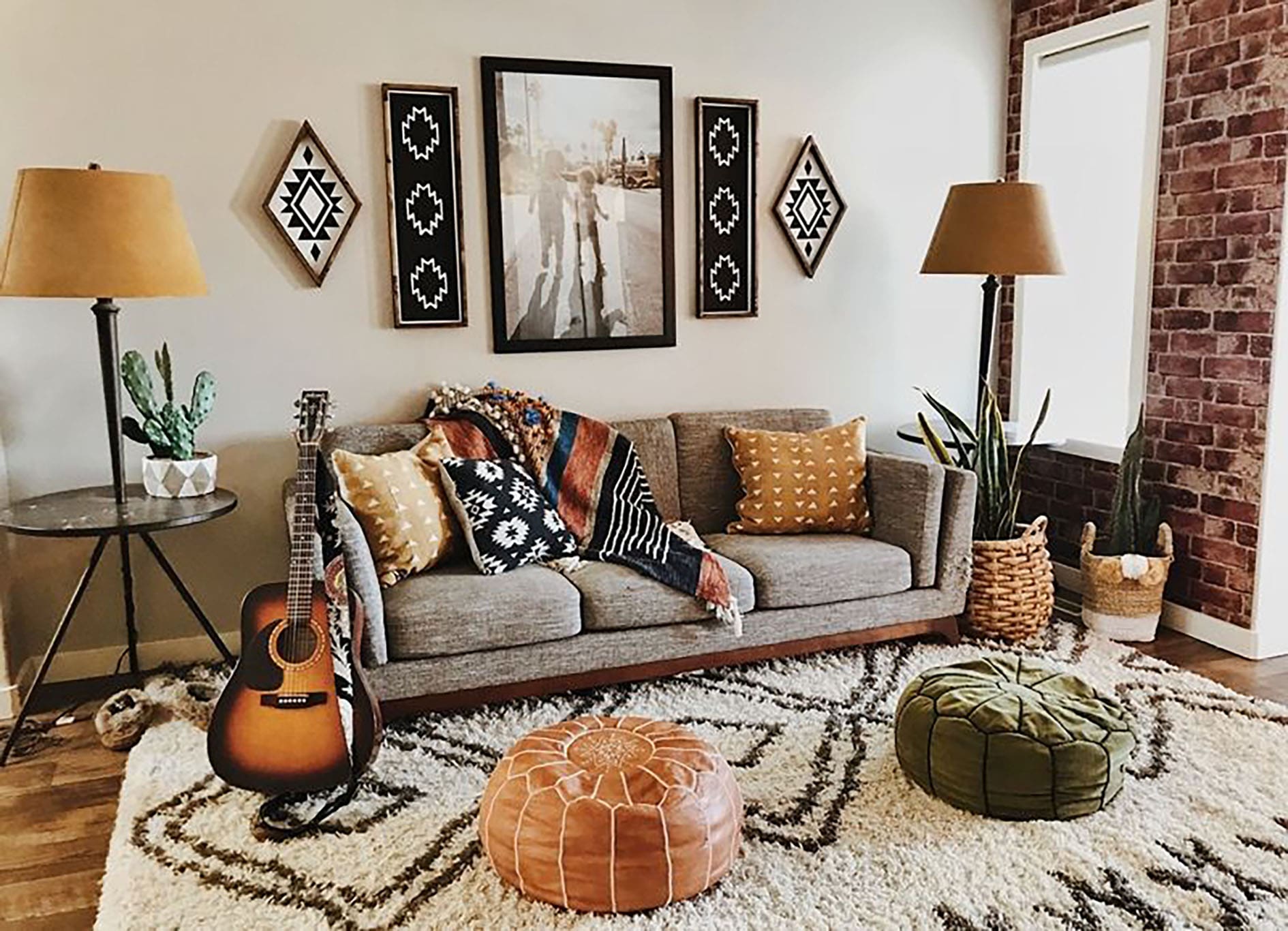
Boho - charismatic and colorful
It does not adhere to strict rules, allowing for a combination of different elements, colours and textures. This style evolved from British street fashion with the addition of bright gypsy outfits, carefree hippie motifs and retro spontaneity.
The gypsy interior style is characterized by butterfly colors and lots of textiles. It is laden with colorful cushions, quilted bedspreads, burpa rugs and multi-layered fabrics. Decoupage and patchwork crafts, paintings by "unrecognized geniuses", candlesticks and vintage postcards are characteristic details.

Brutalism - raw and real
Characteristic features are monumentality, texture, durability, indifference to color and nuance.
Brutalism brings to the fore the beauty of raw materials - exposed masonry, rough plaster, shiny glass, bare metal.
The furniture is large, uncluttered, on fundamental supports. Its color is equal to the finish: brown, gray, dull white.
The fittings are elementary in execution, the decor is almost non-existent.

Bungalow - unpretentious and simple
Features of the project include unconventional finishes, exposed beams on the ceiling, exposed masonry and uncluttered details.
Materials include locally sourced wood, veneer, wallpaper and tiles.
The furniture is American, natural colors: shades of wood, stone and earth.
When choosing accessories, handcrafted and handmade items such as planters, macrames, baskets and candle holders are preferred.

Casual - casual and cozy
Features: creative approach to organizing space, personality, mix of styles, visual ease, connection between vintage items and items bought in the nearest supermarket.
Simple, geometric furnishings, easy to use. Materials, colors and accessories to choose according to your taste.

Chalet - trustworthy and secluded
Features: stability, solidity, rustic finish, logs or slats under the conical ceiling, fireplace, inelegant decor.
Wild stone, smoked wood, brick and stucco are the standard range of chalet materials.
The palette combines shades of wood and stone.
The furniture is wooden, on solid and short legs. All you need are armchairs or a short sofa by the fireplace, simple shelves, a simple rustic dining table with chairs and a futon bed.
Chandeliers made of wrought iron and chains, woolen carpets, sheepskin coats, antlers and hunting trophies add charm.
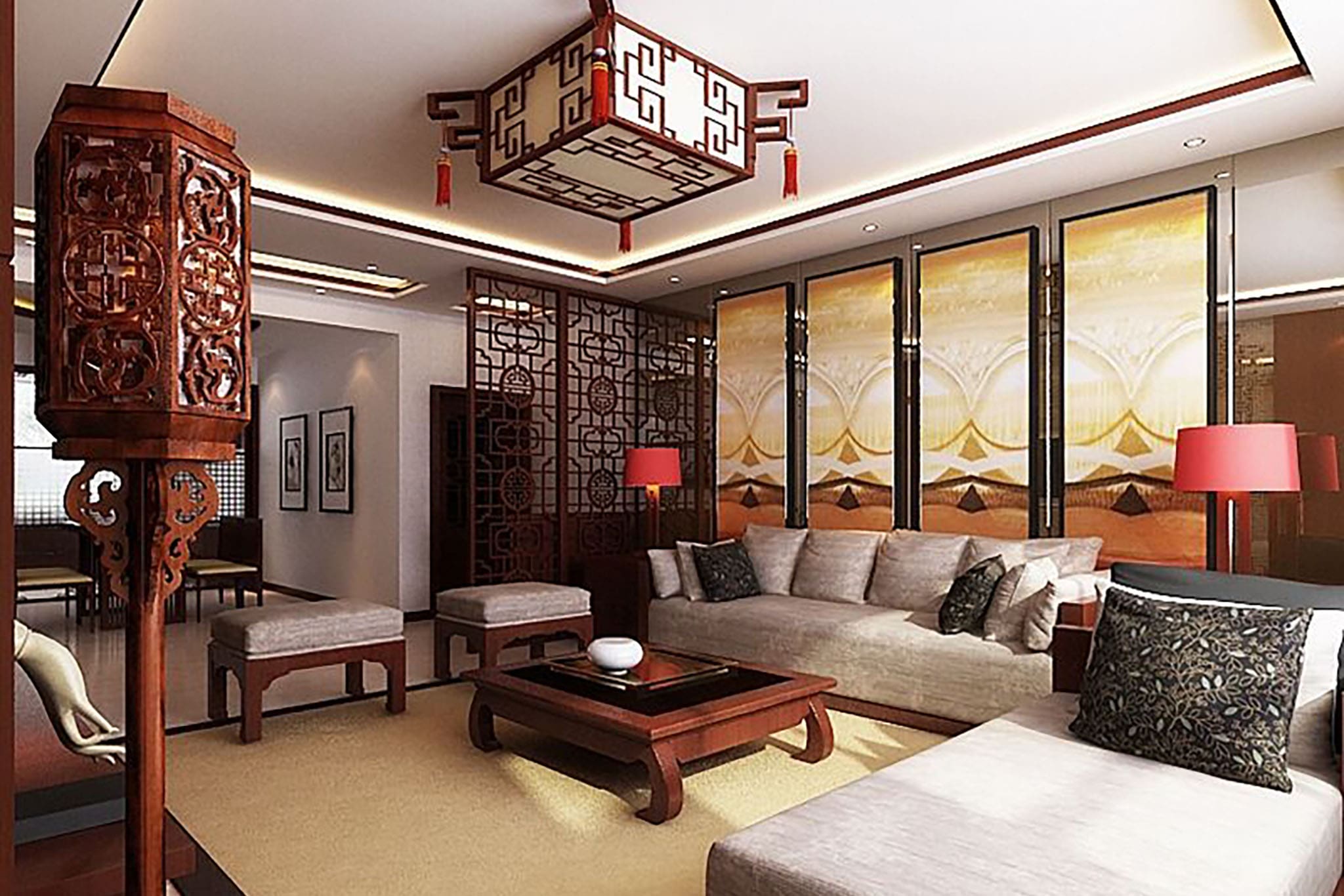
Chinese - concentrated and deep
Features: feng shui, softened angles and lines, national colors, lacquered furniture, screens and bars on the windows.
Materials include stone, plywood, bamboo, rattan, silk, paper and ceramics.
In the first positions, in addition to black, there are shades of fire, vermilion and blue ink.
The furniture consists of low, carved and varnished tables, chiffoniers, shelves and deckchairs.
With accessories and decor, it's important not to overdo it. Choose from reed mats, porcelain, paper lanterns, Sichuan opera masks, dragon figurines, examples of calligraphy, and traditional Chinese landscape art.
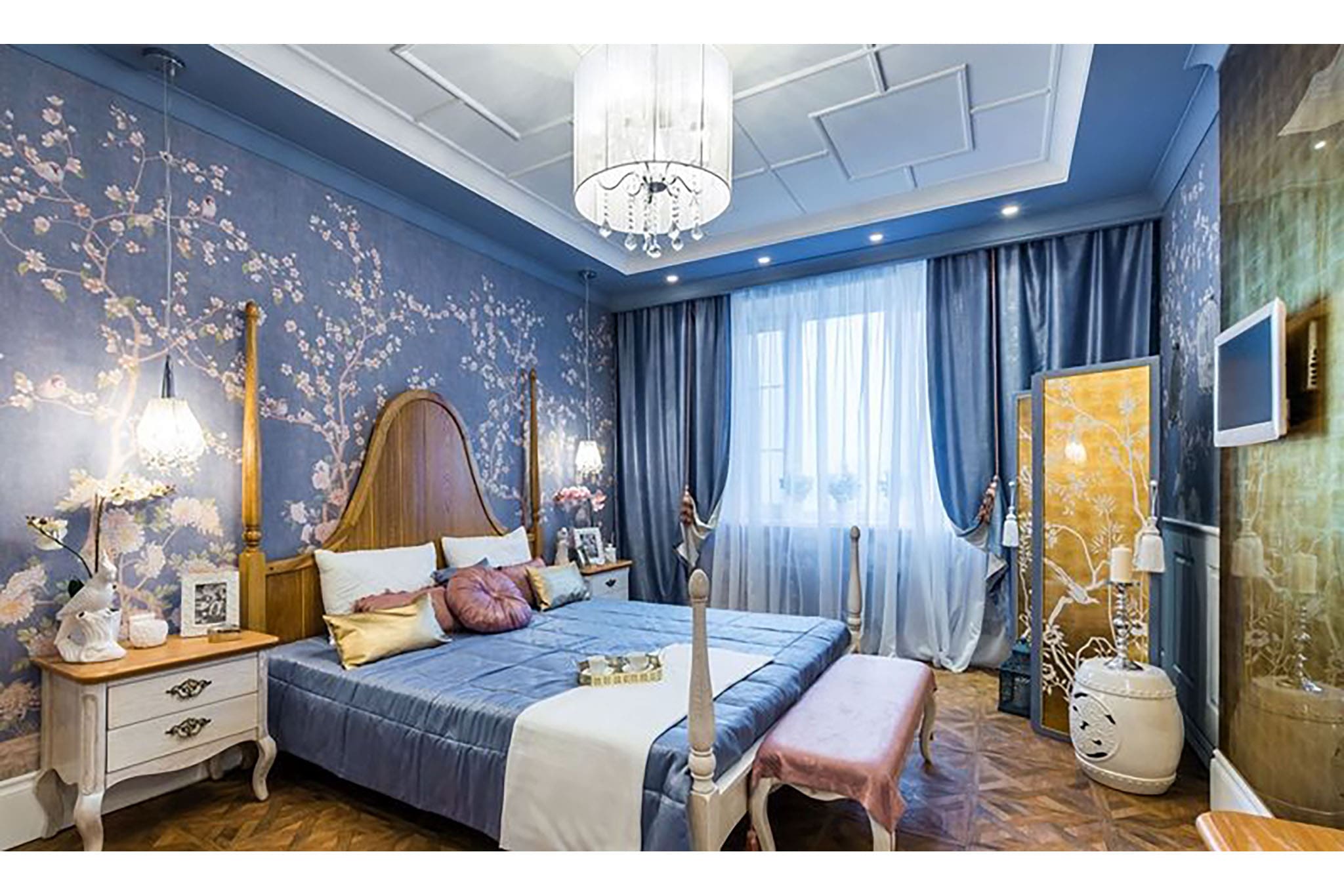
Chinoiserie - intricate and illusory
Features: exotic, elegant, pastoral, pseudo-historical.
It should be remembered that there was no efficient connection between the continents, so the craftsmen introducing the "chinoiseries" into the interiors had to speculate and imagine. So chinoiserie is not China, but its representation, fantasy.
Even today, he turns to this genre, introducing it to classic and modern interiors. Wallpaper decorated with pine branches, bamboo, cranes and dragons, a silk screen, a white carved box and a pair of pseudo-Chinese vases would be enough.
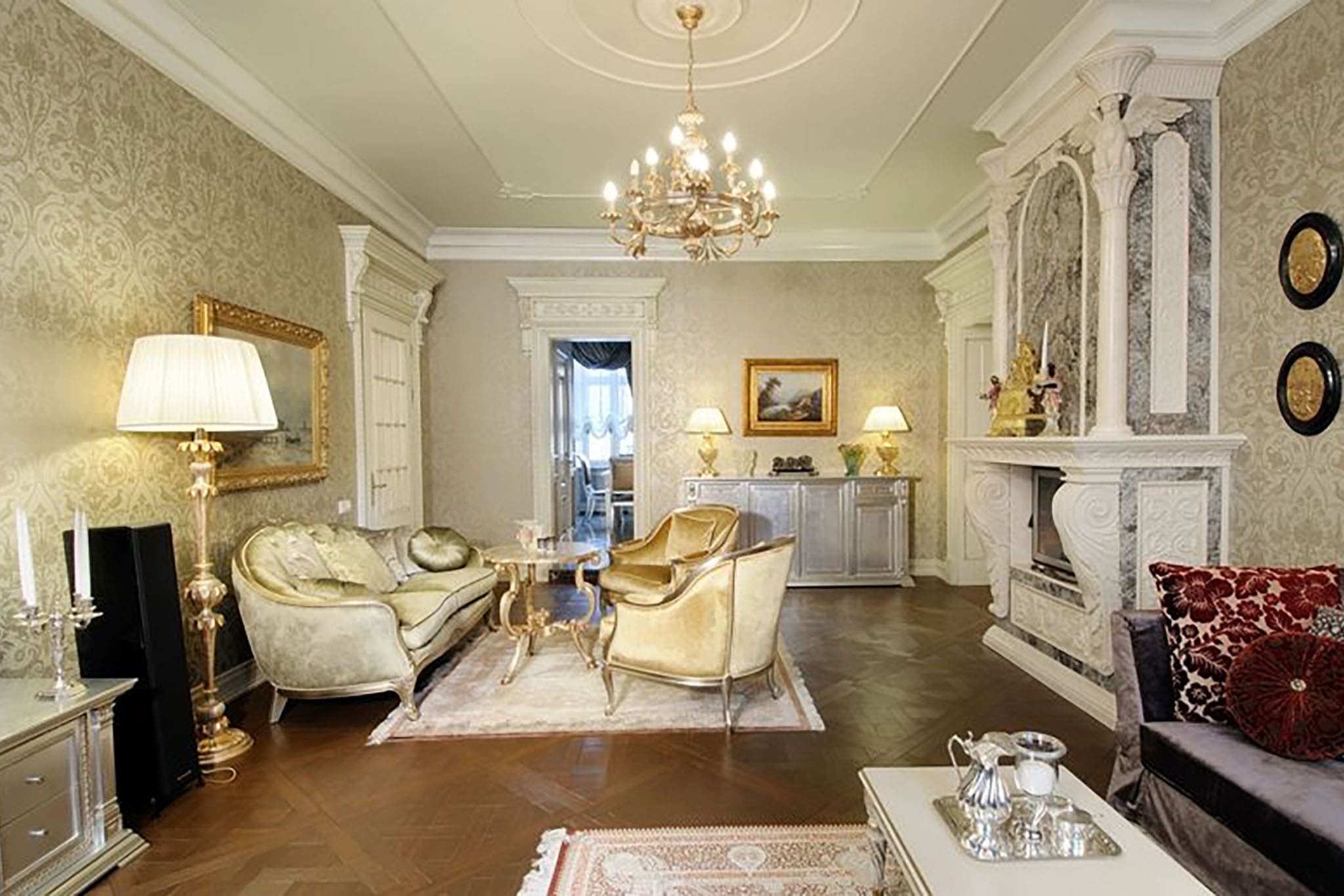
Classic - elegant and correct
They are characterized by undoubted geometry, composition, a sense of proportion and a calm, balanced palette.
The materials are natural and solid, with a predominance of wood and stone.
The furniture is arranged symmetrically and proportionally around a central point, which can be a table, sofa or fireplace. Armchairs and floor lamps are arranged in pairs.
The lighting scenario is detailed, with a chandelier, sconces and local lamps.
Bright colors dominate - white, blue, sand, which are varied with subdued burgundy, green or blue.
Accessories and decor are carefully selected, in moderation: paintings, antique clocks, vases with flowers.
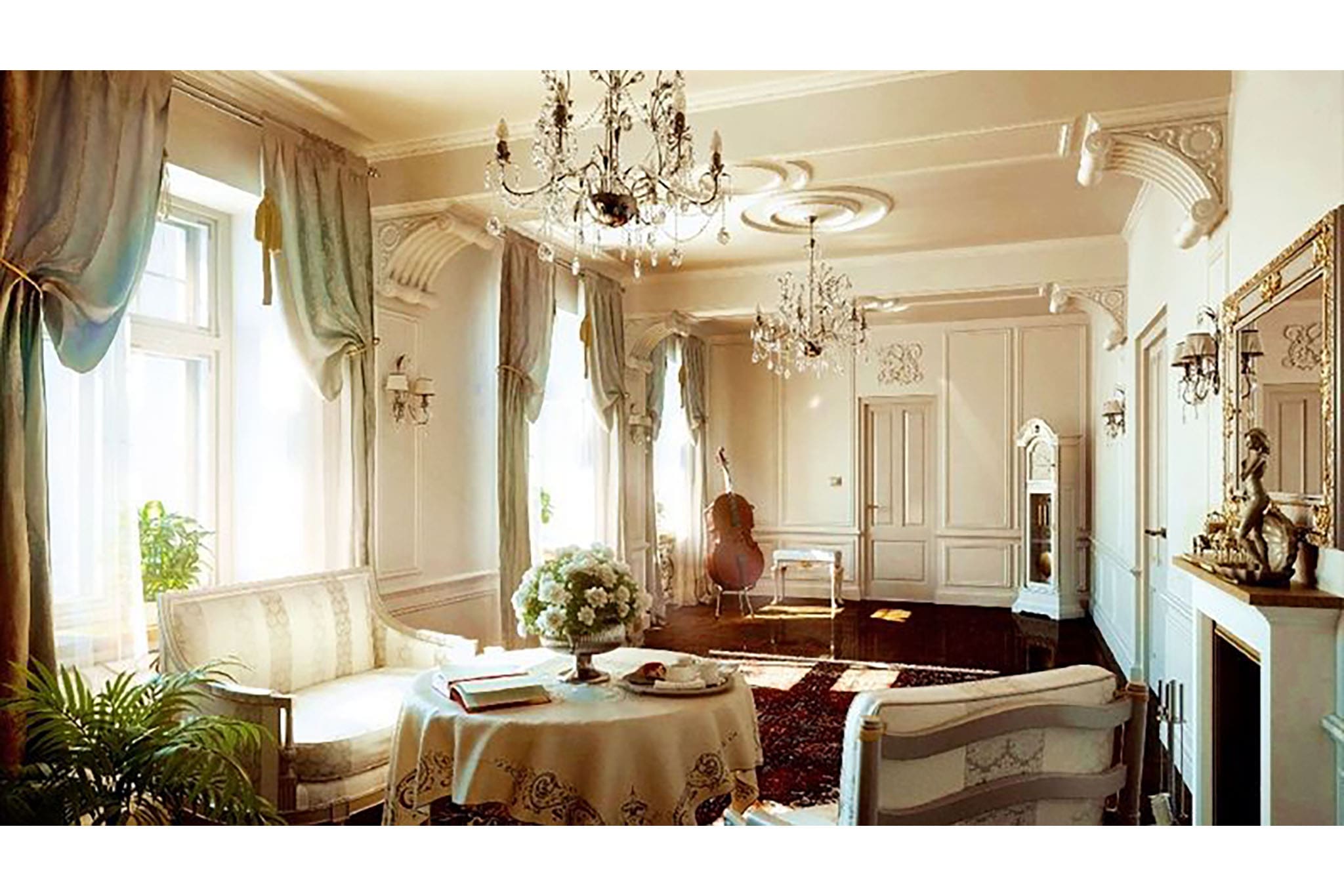
Classicism - exemplary and logical
Features: return to ancient heritage, order, transparency, rationality.
Materials: natural stone, precious and rare wood, expensive thick fabrics.
The furniture is mainly mahogany, with soft and flowing lines, marked by planes, inlays, medallions, bronze and porcelain inlays.
Cult items - chests of drawers, bureaux, bureaux, shapely dressing tables, sofas with slight curves, telescopes.
Delicate colors - violet, pistachio, lapis lazuli, vanilla - add mood and "air".
Illumination was entrusted to a volumetric chandelier of crystal or transparent glass, sconces.
Accessories and decorations include taffeta, brocade or jacquard draperies, floor vases, mother-of-pearl inlays and antique style carvings.
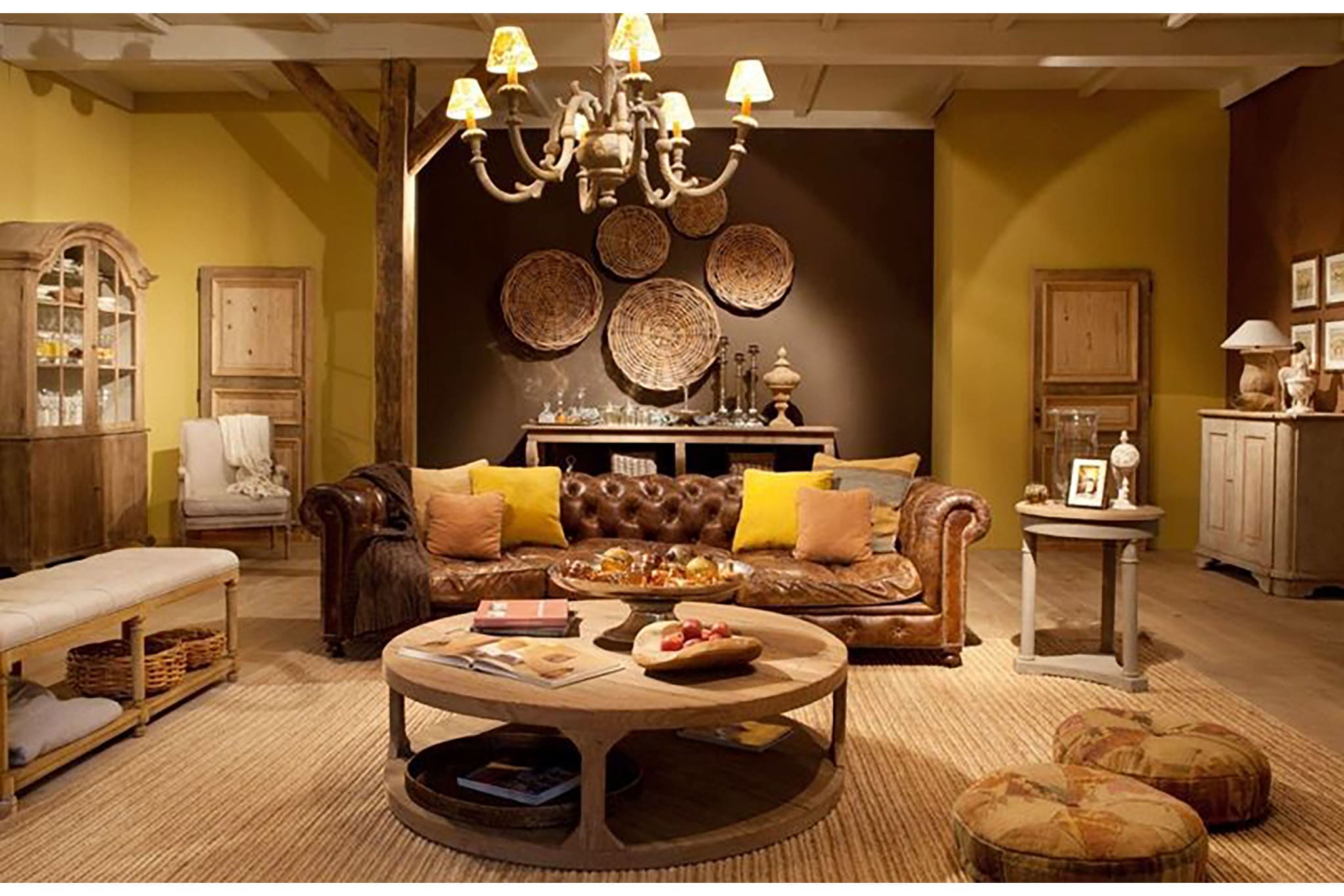
Colonial - comfortable and versatile
Features: natural raw materials and classics in the base, local ethnocolorism, Indian, African, Asian nuances.
The furniture and accessories are a mix of strictly European pieces with local chests, wicker chairs, crockery and decorations.

Conservatism - stable and solid
Characteristics: materials, techniques and things up to date.
The walls, ceiling and floor are durable, with plaster, wood paneling and parquet flooring.
The furniture is classic, inherited or exactly as used in the past.
The lighting, accessories and decor are also old-fashioned: a chandelier with glass corners, table and floor lamps, mirrors, a wool carpet, paintings and portraits of ancestors.
The range is cozy and fuzzy: shades of brown, white and gray.
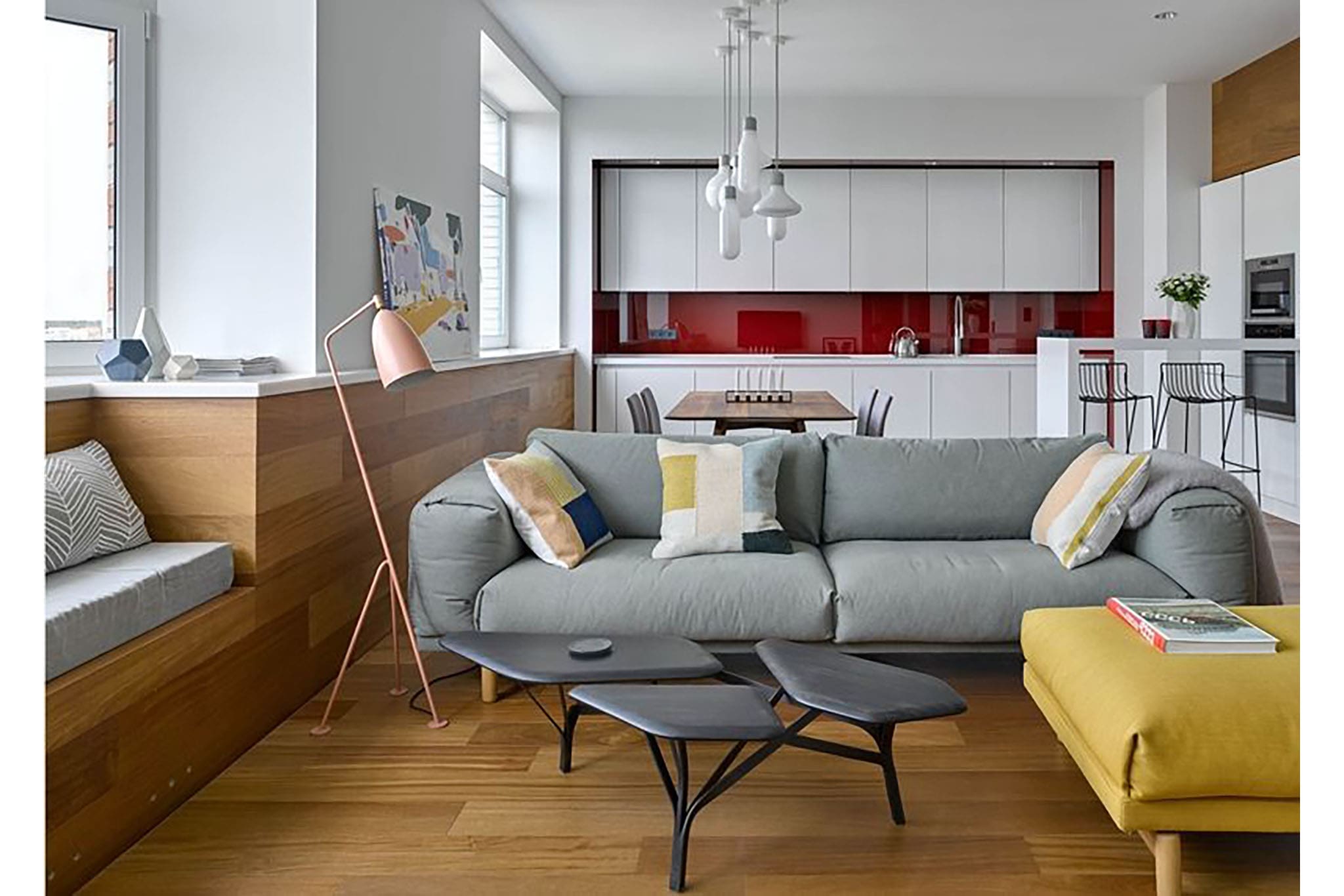
Constructivism – proletarian and simple
Features: monolithic, strict lines, rectangular forms, utilitarianism, color and decorative deficit.
The materials are industrial, mass-produced and very durable.
Furniture with essentials: chair, extendable table with mirrored doors, wardrobe, bed, shelf.
Gray, white, brown, blue and green are the primary colors.
Possible additions are spotlights as a chandelier, a wall clock, a poster, flowers in a bottle instead of a vase.

Contemporary - Discreet and sensible
Its special features are: practicality, budget, compromise between old and new.
Available finishing materials and lighting fixtures, popular at a given time.
Furniture: wall cabinets, sofa or tahta, living room set, kitchen cabinet.
Very discreet and relaxing colors.
Accessories and decor - carpet, reproductions, one or two vases, photos, greenery.

Country - artless and authentic
In the 70s, rural design gained international recognition and was divided into national trends: English, Russian, Scandinavian, French country.
Features: closeness to nature, rustic roughness, nice cute look.
The materials are natural, typical of the area.
The furniture is solid, usually not new, with a history: a welcoming dining table, "grandfather's" rocking chairs, cozy couches.
A lot of fabrics: curtains, tablecloths, pillows, table runners from inexpensive materials.
Wood and white, as well as pastel shades come to the fore.
The decor is unpretentious but diverse: wrought iron, embroidery, baskets, oil lamps, a cowboy hat on the wall or a wagon wheel.
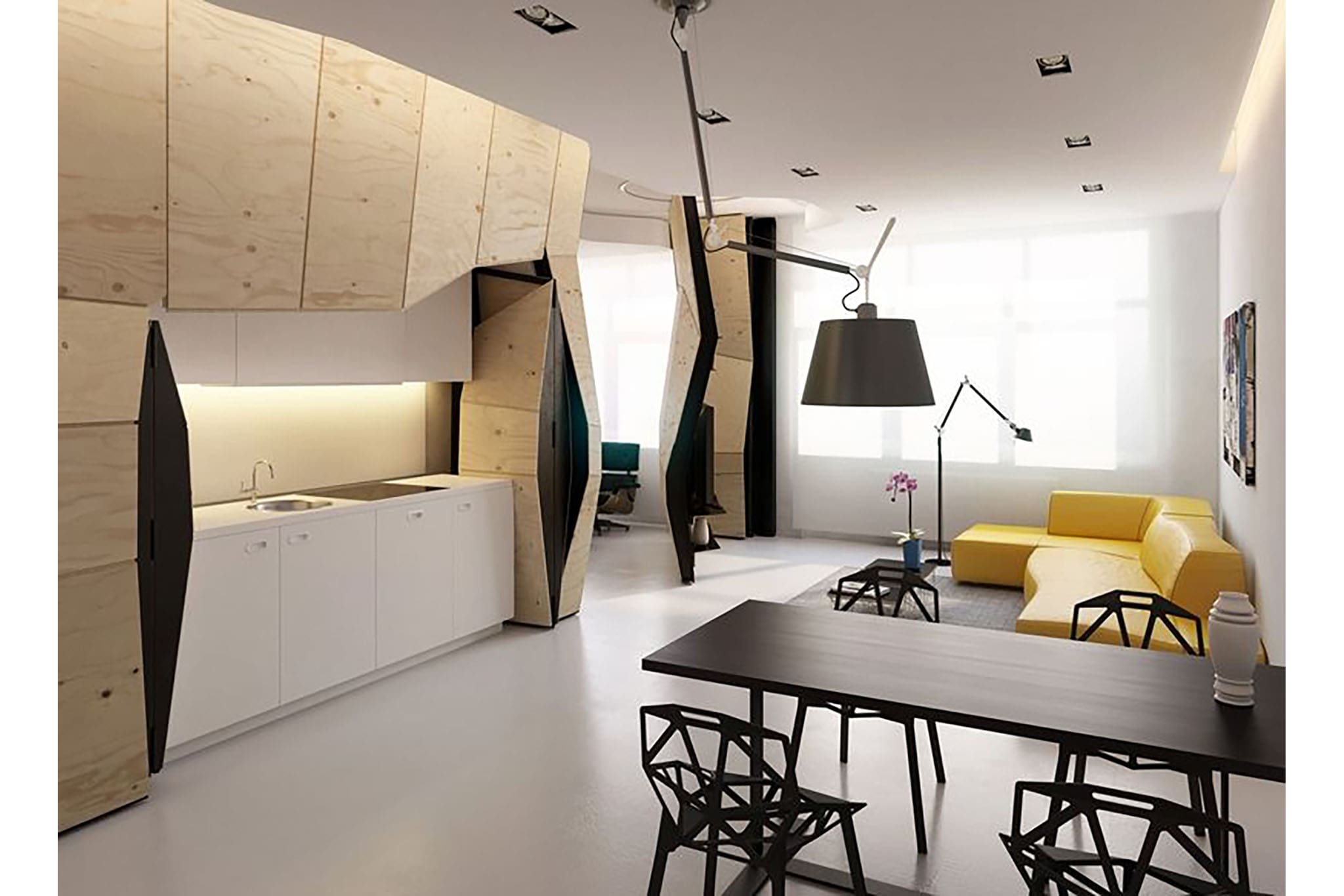
Deconstructivism - assertiveness and sharpness
Features: contradiction of form and content, distorted space, asymmetry, minimalism.
Materials - concrete, plaster, tempered glass, metals, artificial stone.
The palette is impersonal: shades of gray, white and brown.
The furniture consists of formally separate elements; sofas, tables and pouffes of unusual, polygonal shapes. The space is "broken" through arches, rhombic, "bent" openings and niches. Chandeliers are being replaced with projectors and LED strips.
The decor is laconic: unconventional lighting fixtures, paintings and sculptures from current genres.
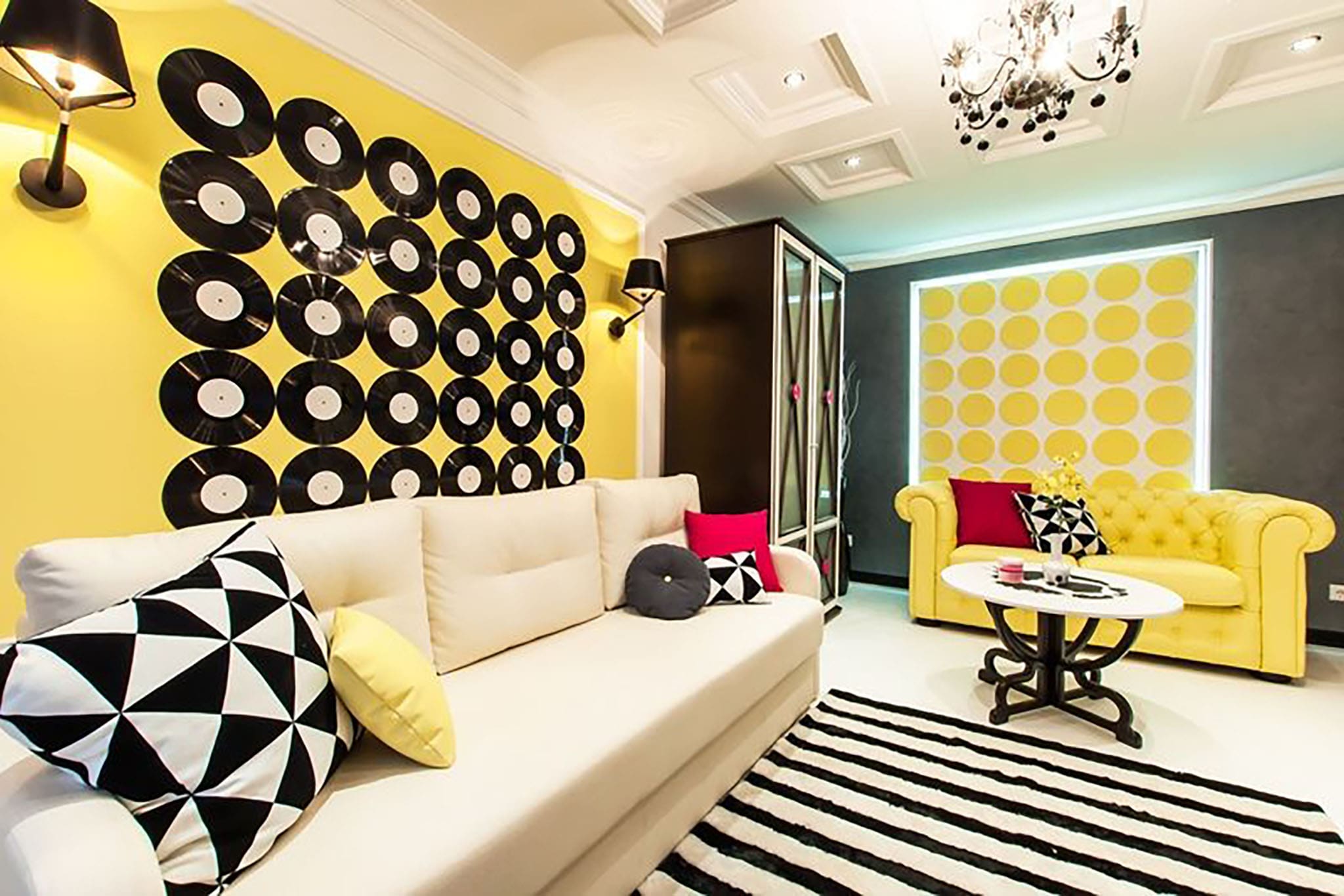
Disco - energetic and upbeat
It is characterized by flickering colors, neon lights, shimmering fabrics.
Furniture - sofas, armchairs, trellises made of polished wood on elongated legs.
The palette is based on black or white, agitated by bright, acidic spots.
The decor consists of portraits of iconic pop singers, mirror balls, gramophone records and zodiac signs.

Dutch - provincial and sincere
Features: natural raw materials, warm colors, vaulted ceilings, a cozy and homely atmosphere.
The main materials are red brick, dark wood and stone plaster.
The furniture is rustic but with curved legs. Iconic items include a china cabinet and a white Dutch oven.
Expressiveness and detail are achieved thanks to live plants, ceramics, hand-made embroidery, patchwork rugs and knitted braids.
Colors include walnut, cream, beige, blue, ocher and avocado shades.
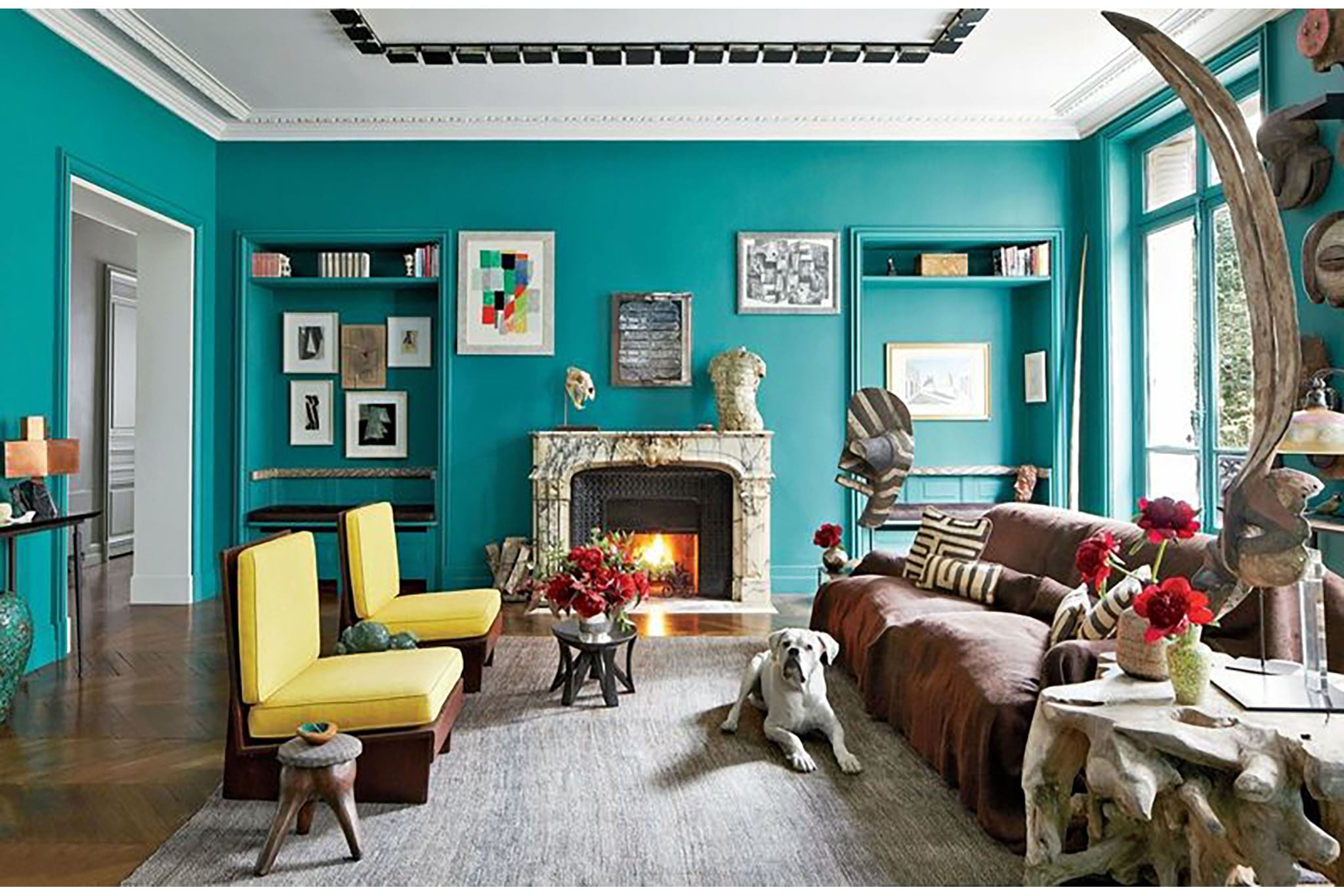
Eclectic - confusing and bold
The peculiarity of eclecticism is primarily historicism, a mixture of eras. And its difference from fusion is that eclecticism groups objects not subjectively and accidentally, but on the basis of similarity. For example, by color, material, texture.
The raw materials can be anything, but the ceilings and walls must be neutral, because this is the frame, the background for further experiments with objects and colors.
The furniture belongs to different styles, but they harmonize with each other in shades or textures of upholstery. The decor also follows this principle: accessories and details are similar in some ways, but completely different.
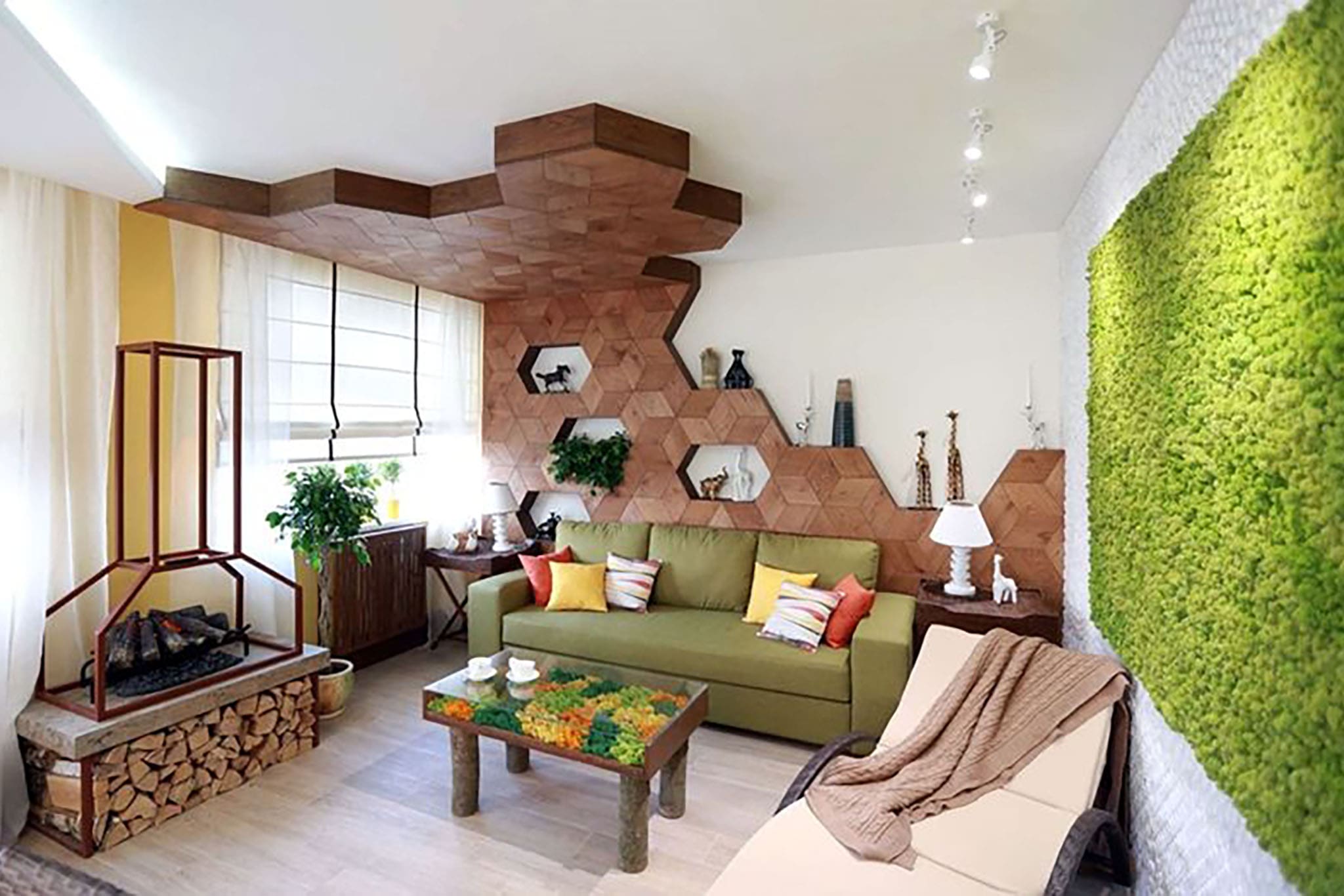
Ecological - calm and versatile
Features: natural raw materials, respect for the fauna, which is expressed in the absence of real leather and fur, "live" decor.
This style features wood, stone, baked clay, linen, cotton fabrics, vines and burlap.
The equipment refers to Scandinavian; the furniture is solid and wicker, with an emphasis on natural textures.
The luminaires are discreet because great importance is attached to daylight. It pours in through large windows that are covered with blinds or light, natural fabrics.
The palette is dominated by white, beige and green.
Accessories and decor include green lawn mats, driftwood hangers, decorative fountains, bamboo curtains, succulent panels and florariums.
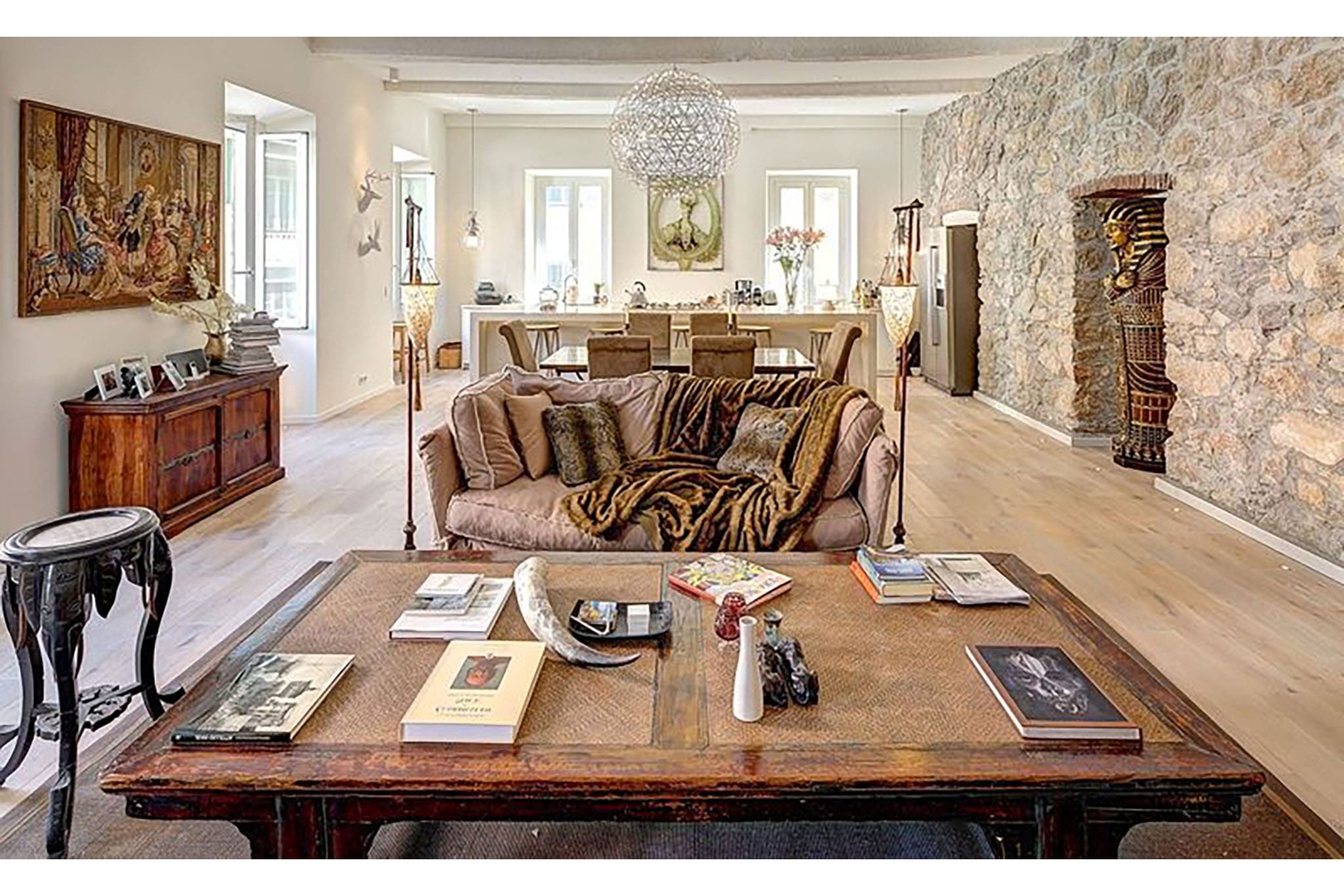
Egyptian - mysterious and symbolic
Features, resources and accessories:
ceramic tiles, majolica, frescoes;
white, red, brown, red, blue, turquoise;
Hieroglyphic prints, "animal" fabrics;
Ebony elements;
lamps in the nature of flashlights;
figurines of cats, scarabs and sphinxes;
palm trees in tubs.

English - respectable and refined
Characteristic features are conservatism, dignity, precious wood, fireplace, dense furnishings.
Gamma is muted: coffee, dull red, moss green, some white. The prints are stripes, tartan plaid, paisley, thick floral patterns.
The style is lavish and there is a lot of furniture. Iconic elements - a Chesterfield sofa, a secretary, a mantel chair, a bookcase, a tea table, a sideboard, a wall/floor clock set in wood.
A chandelier with a bronze or brass frame illuminates the interior.
Silver, bronze and porcelain as well as traditional paintings complete the atmosphere. And also curiosities from the "colony": Moorish chest, Indian hookah, coral from the tropics.

Ethnic - native and authentic
Ethnic interiors include, for example, oriental, Indian, Chinese or Mexican styles.
Articles about design also feature Spanish, Portuguese, French, Norwegian, Irish, Hawaiian, Indonesian, Latin American, Russian (à la russe) interiors and the style of the Polish or Russian countryside. It makes no sense to enumerate them: there are as many ethnic groups as there are styles!
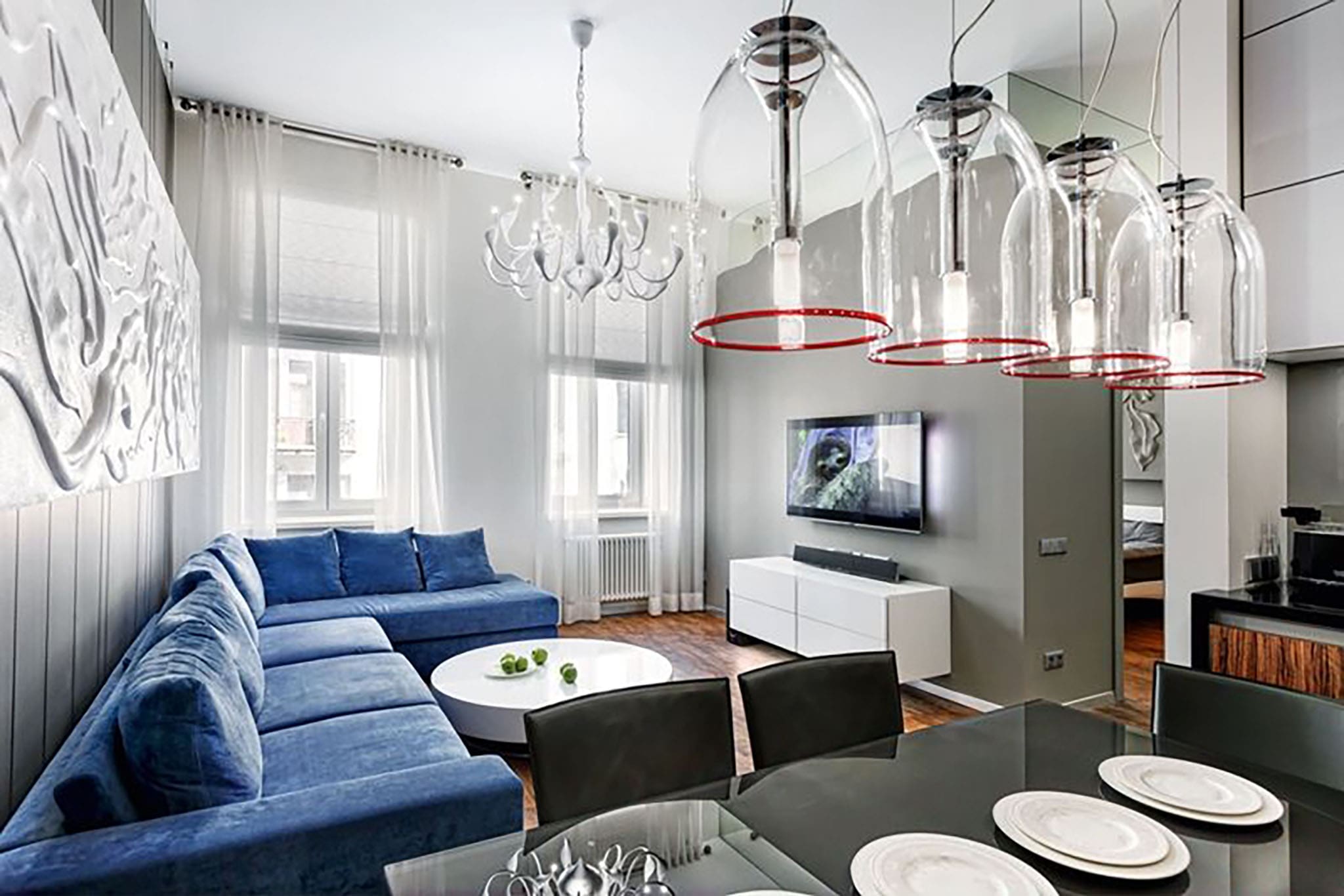
Functionalism – utilitarian and logical
Characteristics: strict compliance of the construction and appearance of the object with its intended use, simplicity, wholeness, minimum of partitions and internal doors, reluctance to ornamentation.
The materials are industrial, in the spirit of socialist realism: concrete and reinforced concrete, brick, large-format wooden panels, glass.
The palette is indifferent: shades of gray, white and dull yellow.
The furniture is elegant, ergonomic and removable. Iconic elements are transforming armchairs, bookcases and tables on wheels.
The decor will be LED lamps, posters adding color, large potted plants.

Fusion - paradoxical and relaxed
Its peculiarities are extraordinary, the collaboration of cultures and epochs, attempts to reduce to one denominator oriental harmony and European pragmatism.
Materials of all kinds.
The furnishings are mixed, taking into account both tradition and fashion. That is, an old-fashioned chest of drawers or a creaking rocking chair can be placed next to an ultra-modern glass table. All you need is a desire and… a sense of proportion.
The palette is endless, with accessories and décor to choose from, from retro pieces to ethnic heirlooms.

Futurism - cosmic and utopian
Features: lines, forms, colors and techniques conveying movement and speed; abstraction, cosmism.
The materials are new, with smooth, polished, glassy textures. There are various composites, plastic masses, fiberglass.
The doors look like spaceship hatches, the windows look like portholes.
The furniture is modular, with floating, curved lines. Cult objects - "astronaut chairs", capsule beds, shelves flowing one into another, displays, monitors.
The offer includes grey, white, blue, violet, blue with neon, fluorescent glow.
Accessories and decorations include bathyscaphe lamps, LED strips, photos of lunar landscapes, models of Mars rovers.

George I style, primitive and syncretic
Under George I, who barely knew English, there was an aesthetic revolution: German, Dutch "quotes" appeared in interiors amidst the formation of the Rococo style.
Style features: a mixture of classicism and rococo, mouldings, wooden friezes and cornices, carved shutters, frames and ornaments on the walls.
Characteristic materials include mahogany, lacquer, marble, terracotta, velvet, damask and furniture tapestry.
The furniture consists of full furniture sets. Cult pieces include chests of drawers, Chippendale and Hepplewhite cabinet chairs and Sheraton armchairs.
The colors are dull, phlegmatic: brown, pea, beige, taupe.
Acceptable accessories include not only paintings, mirrors and chandelier-style lamps, but also glass lanterns, Chinese porcelain and fans.
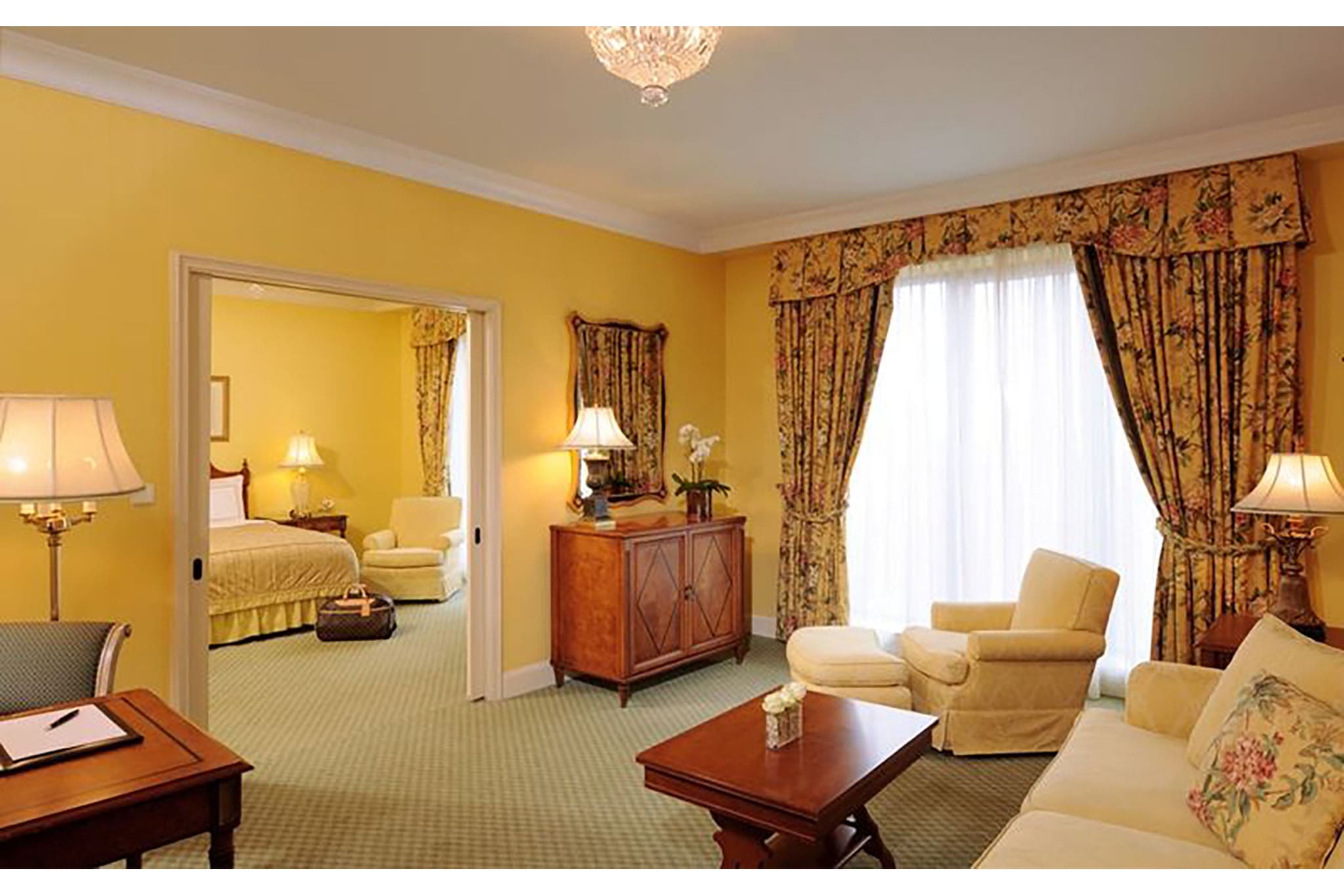
German - meticulous and neat
Features: less walls, more space, expressiveness, the antithesis of light walls and dark floors, podiums, soft lines.
The interior has a lot of wood (including beams on the ceiling), smooth plaster and wallpaper were used.
Compared to Biedermeier, there is less furniture, it is simpler in appearance, lighter and more practical. The focus was on functionality, with a sense of minimalism. The furniture is based on long sofas, armchairs with semicircular backrests, compact tables and bedside tables.
The palette is based on colors and shades of white, chocolate, terracotta, walnut, brown, gray and vanilla.
Accessories include small lamps, wall clocks, potted plants, landscapes and portraits in a restrained palette.
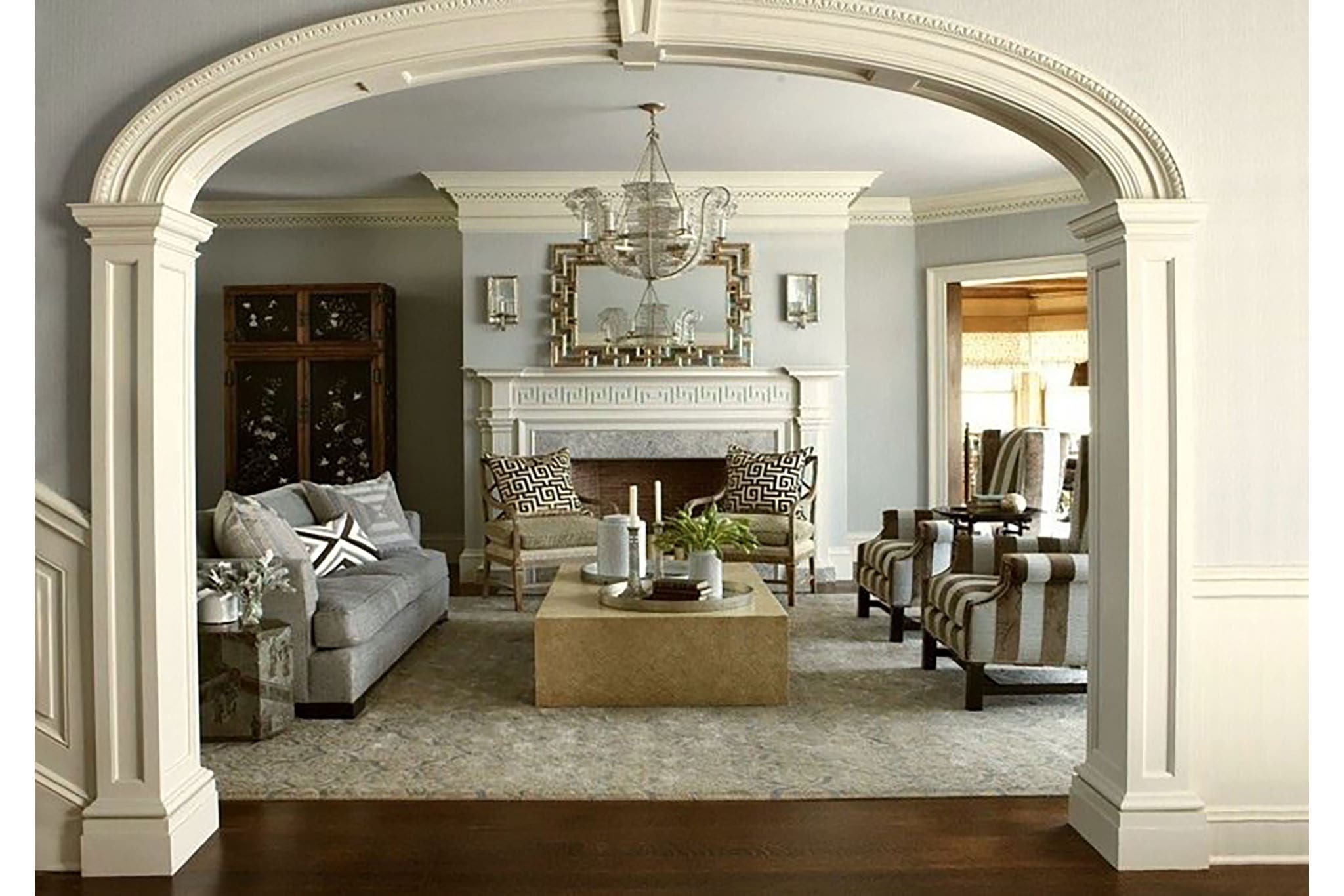
Greek – dignified and fiery
Features: symmetry, pseudo-columns, decorative arches, baguettes, pilasters, mythological and Olympic motifs, mosaics.
Materials: plaster, whitewash, boards with a ceramic mat.
The furniture is light, with smooth contours, with fragments of wrought iron. We recommend low sofas that look like boats, pouffes and side tables decorated with antique capitals, benches without backrests.
The palette is clear and radiant: white, pearl, blue, terracotta, gold.
Accessories: lamps, figurines of naiads and centaurs, jugs with narrow, tall necks, busts of Greek philosophers.
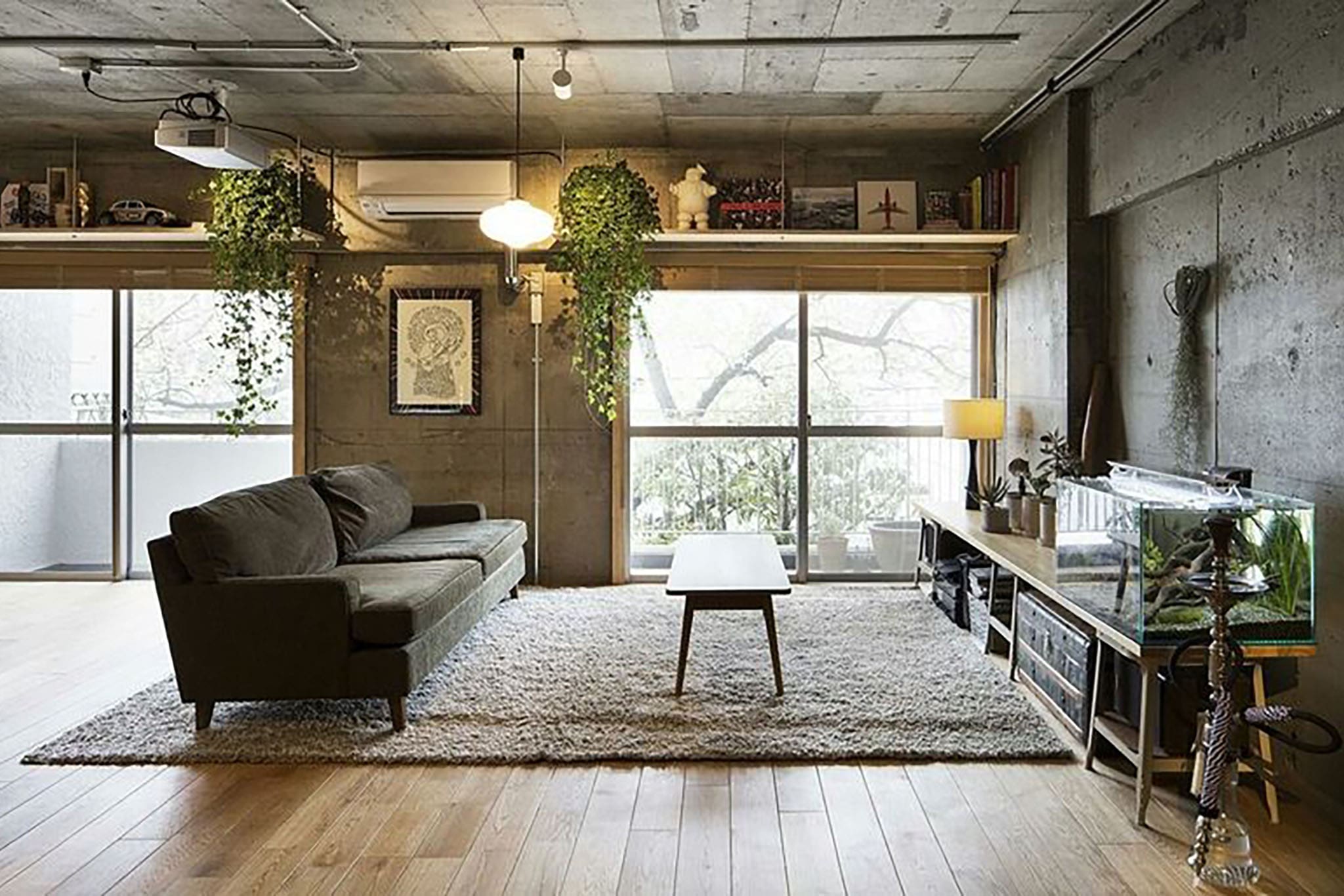
Grunge - flashy and messy
Grunge features include walls stripped down to brick or hastily painted, beamed ceilings, and minimally hewn stone or boardwalk floors.
The furniture is vintage or standard, light and practical with real worn or artificially aged elements.
The palette is natural and continues the colors of plaster, stone and bleached wood.
The decorations are books, cozy rugs and photos.
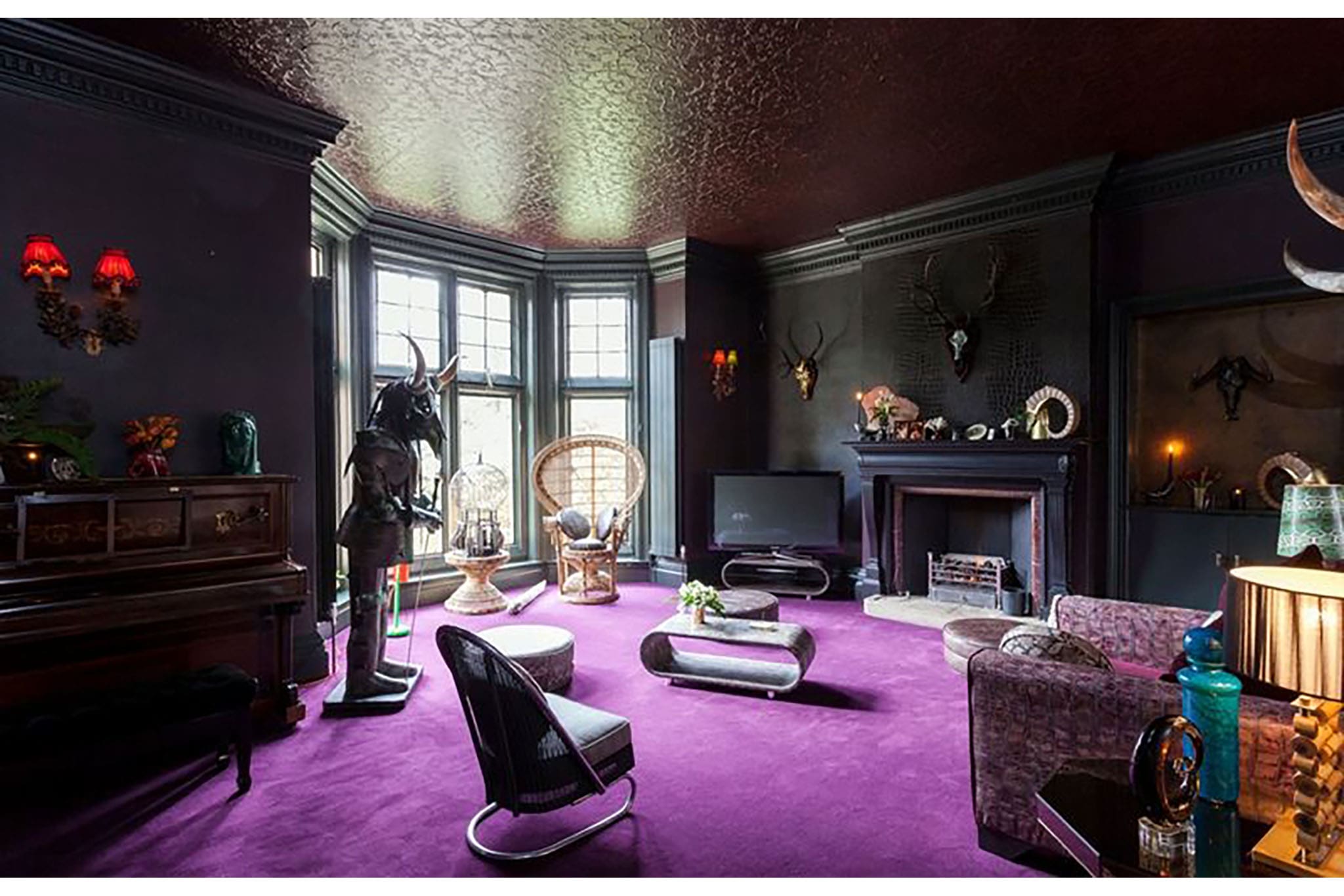
Gothic - solemn and monumental
Features: lancet arches, stained glass windows, moody palette, a hint of mysticism and religiosity.
Materials: stone, heavy wood, colored glass, leather and fur, velvet.
Spartan furnishings: chests, massive benches, high sideboards, armchairs with empty backrests and the same armrests, beds with posts and canopies, carved chests of drawers with lots of "secret" drawers, chests upholstered in leather.
The colors are dark, even a little intimidating: shades of stained wood, black, blood red and dull yellow. The light is blurred, its sources hidden behind stained glass.
Accessories include bronze and brass chandeliers, wooden madonnas, crucifixes, goblets and vessels that evoke the experiments of alchemists.
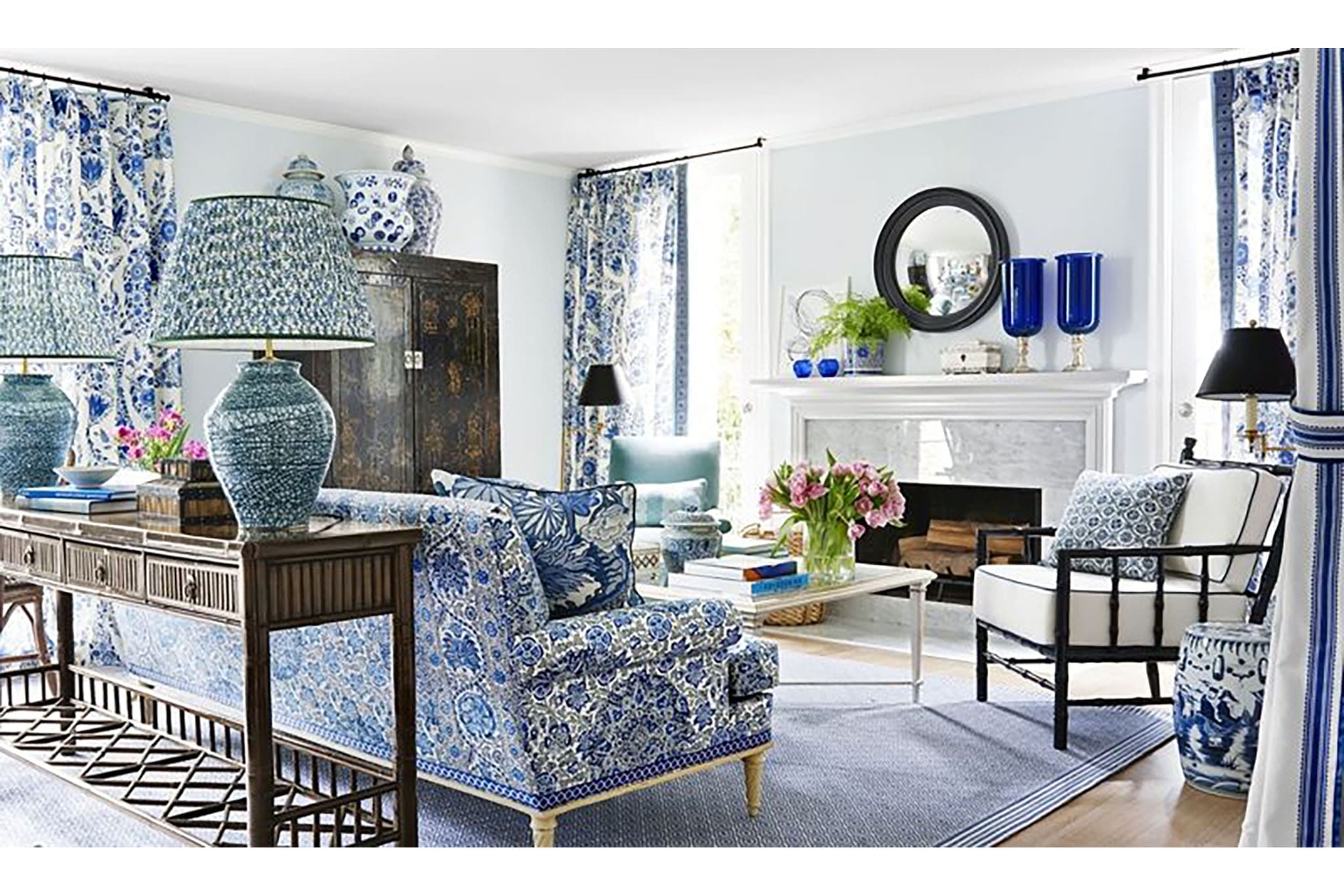
Gzhel - naive and friendly
Features: predominance of snow-white, cobalt and cornflower blue colors.
Materials include light wood, ceramic tiles, tiles, linen and chintz. The textures are high-gloss, reminiscent of clay vessels.
The abundance of blue and white tableware, which is a symbol of style, is diluted with wrought-iron candlesticks, embroidered towels and great-grandmother's utensils - spinners, grills and cast iron irons.
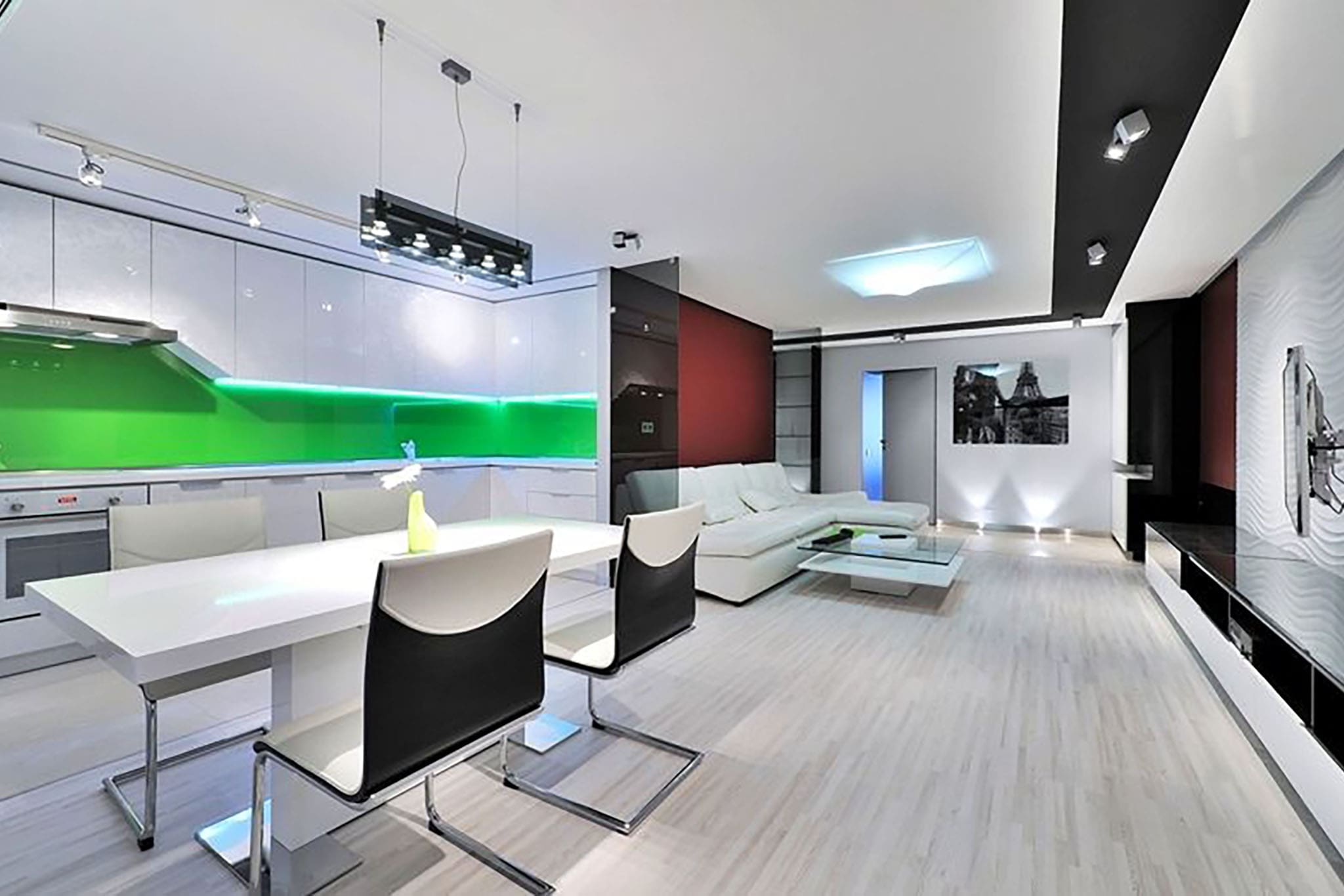
High-tech - progressive and technocratic
Features: high-tech expansion, simple dynamic lines, emotional parsimony.
High-tech “celebrates” the beauty of man-made materials and innovation, so the finishes include polished concrete, tempered glass, plastics and metals, as well as dark wood treated to absolute smoothness.
The furniture is light, easy and quick to lift, fold and move. Notable examples include pull-out takhta wall, swivel office chair and wardrobes.
Devices are more numerous than any other objects, "embedded" in the walls and furniture, constituting a unity with them.
The space is filled with smoky colors, white, blue, purple with light inserts.
Accessories and decor include multi-level lighting on tripods and holders, installations, abstract sculptures made of glass and metal, living greenery in containers, an aquarium, several pillows in thick covers.

Hippy - liberated and iridescent
Features: unpredictable colors and textures, ethnic motifs, hippie symbols.
In addition to basic, inexpensive and common materials, a lot of textiles appear in hippie interiors. In this sense, this style is similar to boho and lounge, also intended to create a creative, eye-catching and relaxing environment at the same time.
The furniture is low, carpeted; there are lots of cushions on the floor and meditation mats.
Colorful fabrics, Indian patterns and rainbow-painted canvases provide the right palette.
Accessories and decor include lamps projecting sketches of birds or fish onto the walls and ceiling, books, objects typical of the 60s and 70s, Buddha and Shiva figurines, and amulets.
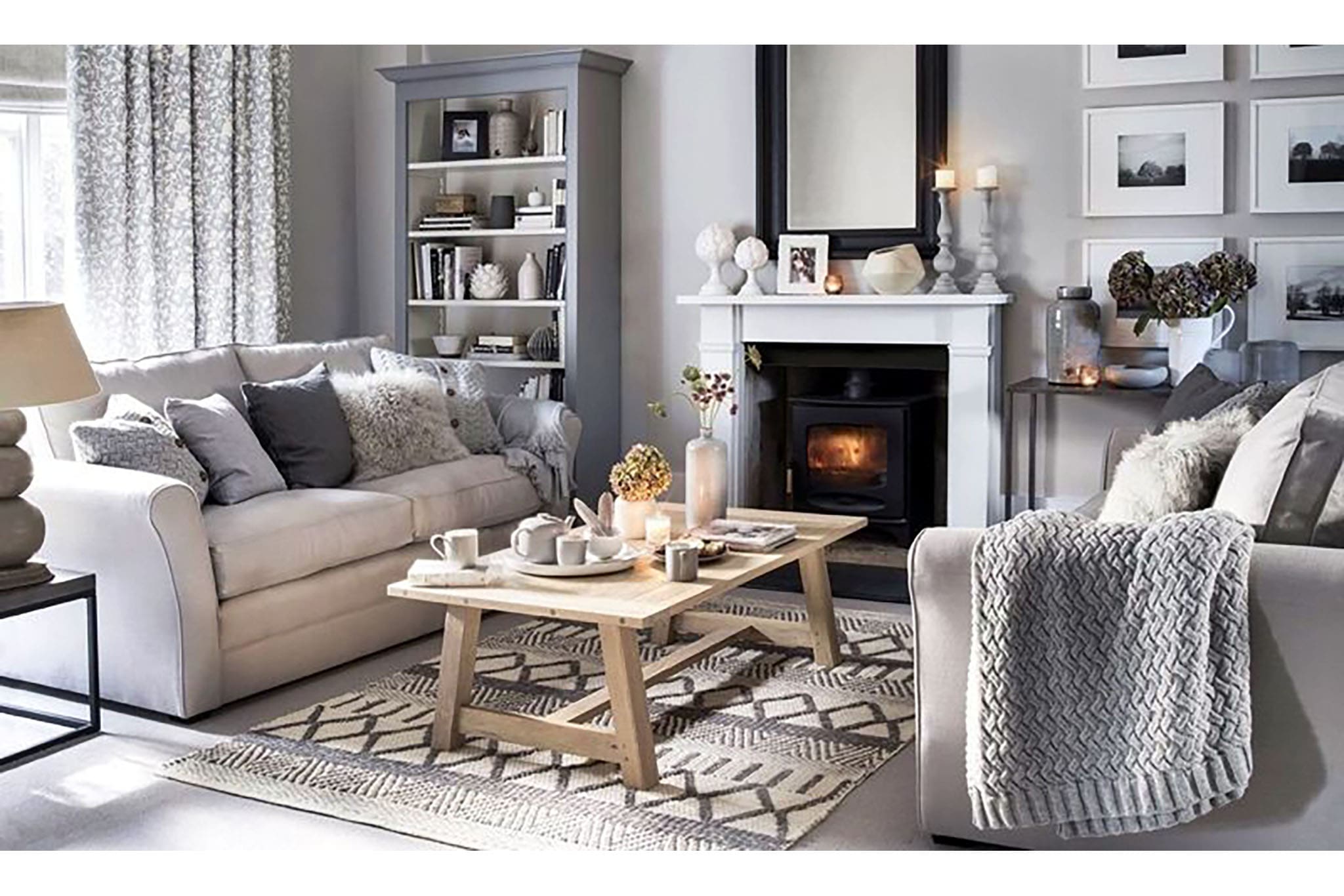
Hygge - peace and warmth
The term gained international popularity thanks to sociologist Mike Viking, head of the Happiness Research Institute in Copenhagen and author of books on hygge.
Characteristics. In today's vocabulary, the word means "creating a calm and cozy environment that promotes well-being".
Materials and furniture are not so important. Although the traditional Scandinavian style is the mainstay of the hygge style, it can harmonize with any modern interior that is not burdened with unnecessary items.
It's about family souvenirs with a positive halo, family photos, braids, pillows, fur skins, clay, wicker and straw handicrafts. Also remember about candles that should be lit daily.

Indian - lively and hot
The characteristic features are decorative arches, shutters, a combination of yogic equality with a riot of colors and a variety of patterns.
In terms of materials, the Indian home is full of carved wood and fabrics, mainly silk and cotton.
The furniture consists of low, hand-made tables, half-round sofas, chests of drawers, armchairs, benches and stools with wicker seats. They are decorated with marquetry, lacquer, wrought iron and Bombay mosaic.
The colors are "mature" and life-affirming: navy blue, pumpkin, lemon and violet.
The room is padded with pillows and bolsters, like a gypsy tent.
The leitmotifs are lanterns made of colored glass, mandalas on the ceiling and walls, papier-mâché boxes covered with lacquer, elephant figurines, bells to drive away evil spirits and fragrant sticks.
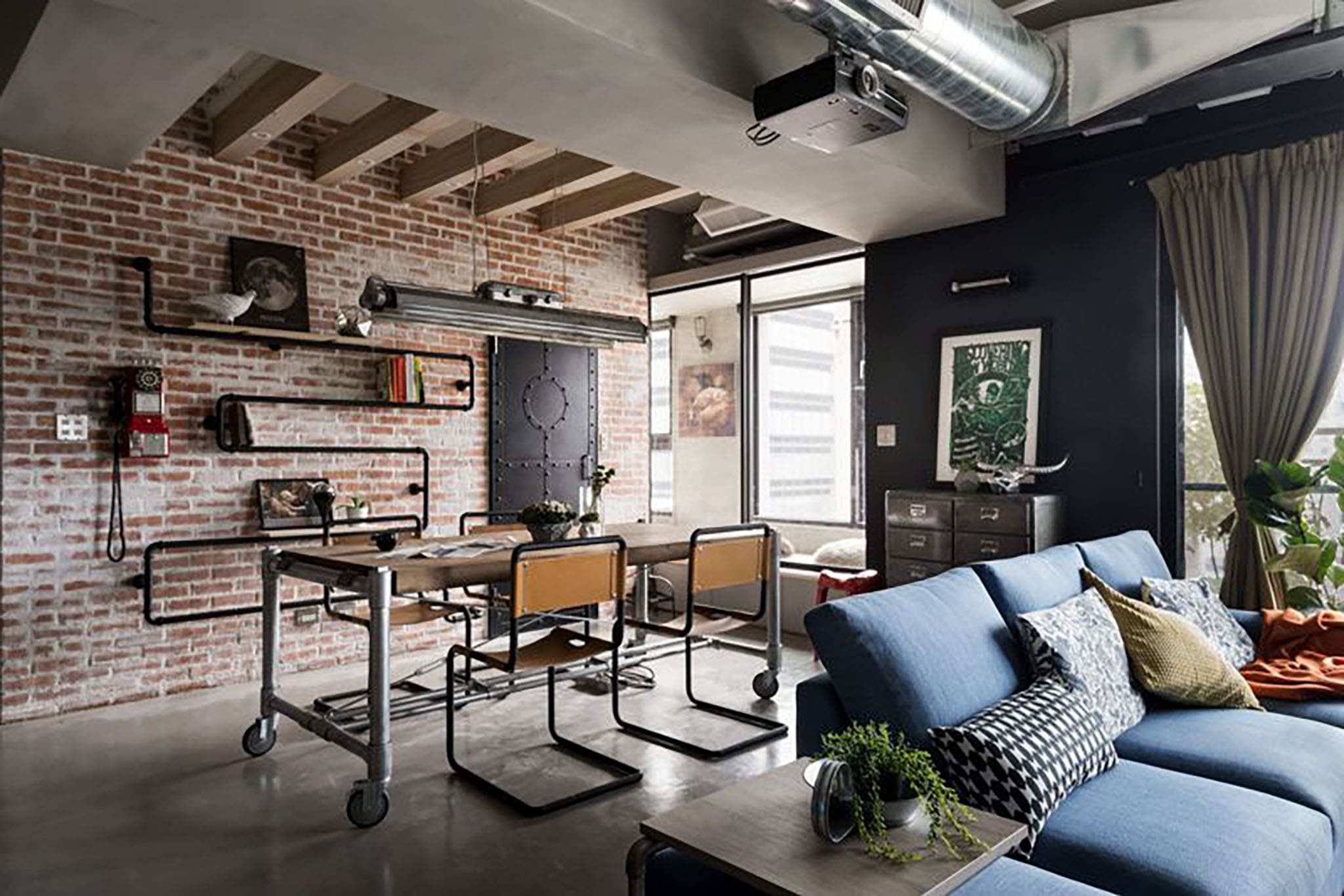
Industrial - honest and hardworking
Characteristic features: bas-relief, exhibition of industrial stuffing (open pipes, ventilation shafts), minimal decoration, furniture made of tools and containers.
Materials - concrete, brick, boards, metal.
The quarters are equipped with metal shelves and plywood cabinets, laboratory stands, ladders; the workbench is set up as a table and the drawers are used as stools.
The colors are urban (shades of cement, brick, lime, rust), with monochromaticity, fragility and roughness being the priority.
Raw shelves, framed clock on a pole, road signs, graffiti, and preferably industrial posters encouraging to work.

Italian - wealthy and friendly
Features: reference to antiquity (frescoes, stuccoes, stained glass windows), precise symmetry, fragment decoration.
Materials are in harmony with the surrounding nature: stone, wood, matte tiles, plaster.
The palette also resonates with the surroundings: white, azure, emerald, gold, beige, brown and blue colors were used.
Iconic features include a coffee table by the sofa, a kitchen table with a marble top, deep armchairs and several wicker chairs.
However, the Italian style is not homogeneous, it can be urban or rustic, depending on regional customs. An example is the Tuscan style, which is a variation of the Italian style.
Tuscan style – a cross between Italian, French and Spanish patterns. It is characterized by open sockets, textured plaster, cotto tiles, painted furniture and vibrant green interiors.
Accessories and decorations include carpets, wrought iron candlesticks, fruit vases and white figurines.

Jazz – eccentric and improvised
It is characterized by contrasting colors, monotonous prints and African ornaments, dark wood furniture, varnish and varnish.
Materials - concrete, brick, glass, metals, high-gloss paint.
The colors are a combination of black and white, black and red, turquoise, purple, emerald.
The decor is international: imitations of exotic leathers, Egyptian papyri, Japanese fans and other ethnoexotics mixed with posters and photographic portraits of jazz performers.

Japanese - gentle and thoughtful
The Japanese way to interiors is lightness, sensuality and simplicity. This style inspires us to reflect, meditate and self-improve.
Materials are dark wood, stone, bamboo, paper.
The furniture is light and low, shelves and cabinets are hidden in the walls.
The palette is simple and uncluttered: shades of wood, bits of white, muted cherry and charcoal black.
There are not many accessories and ornaments, the Japanese mentality considers it indecent to display relics and regalia. A lamp under the eaves made of calligraphically painted silk, a pair of light mats, an engraving with a fragile sakura branch or an outline of Fuji, bonsai ... There is probably nothing else.now-white, cobalt and cornflower blue colors.
Materials include light wood, ceramic tiles, tiles, linen and chintz. The textures are high-gloss, reminiscent of clay vessels.
The abundance of blue and white tableware, which is a symbol of style, is diluted with wrought-iron candlesticks, embroidered towels and great-grandmother's utensils - spinners, grills and cast iron irons.
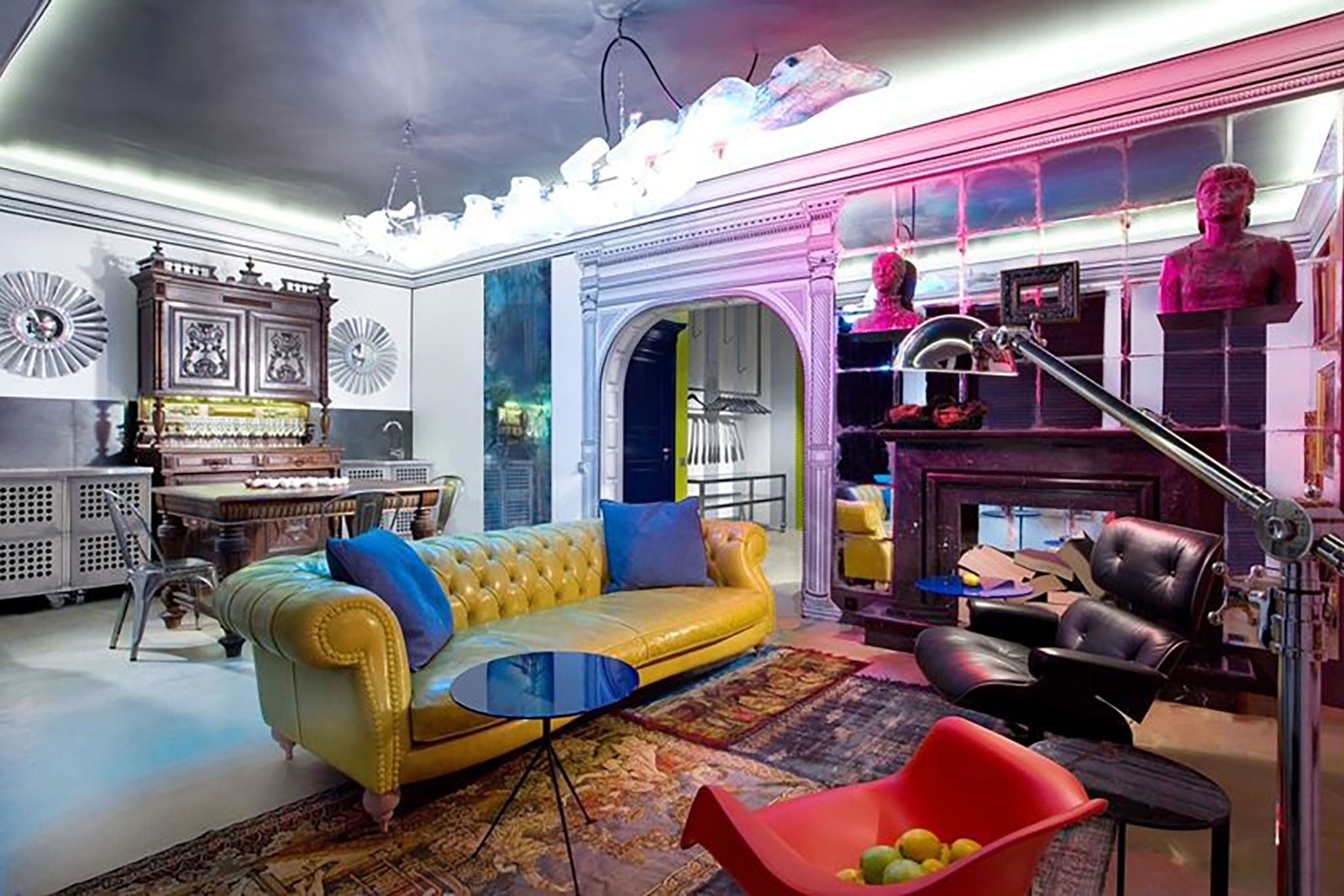
Kitsch - sarcastic and absurd
The look is an ironic imitation of historical interiors, striking trinkets, a deliberately inept imitation of luxury, fairground trinkets as decoration.
The materials are cheap and synthetic; the furniture is a parody of luxury; the colors are piercing.
Accessories include plaster bas-reliefs painted "like marble", false fireplaces, plush deer curtains and rugs, reproductions of the infamous bears in the woods, chests of drawers, embossed antlers.
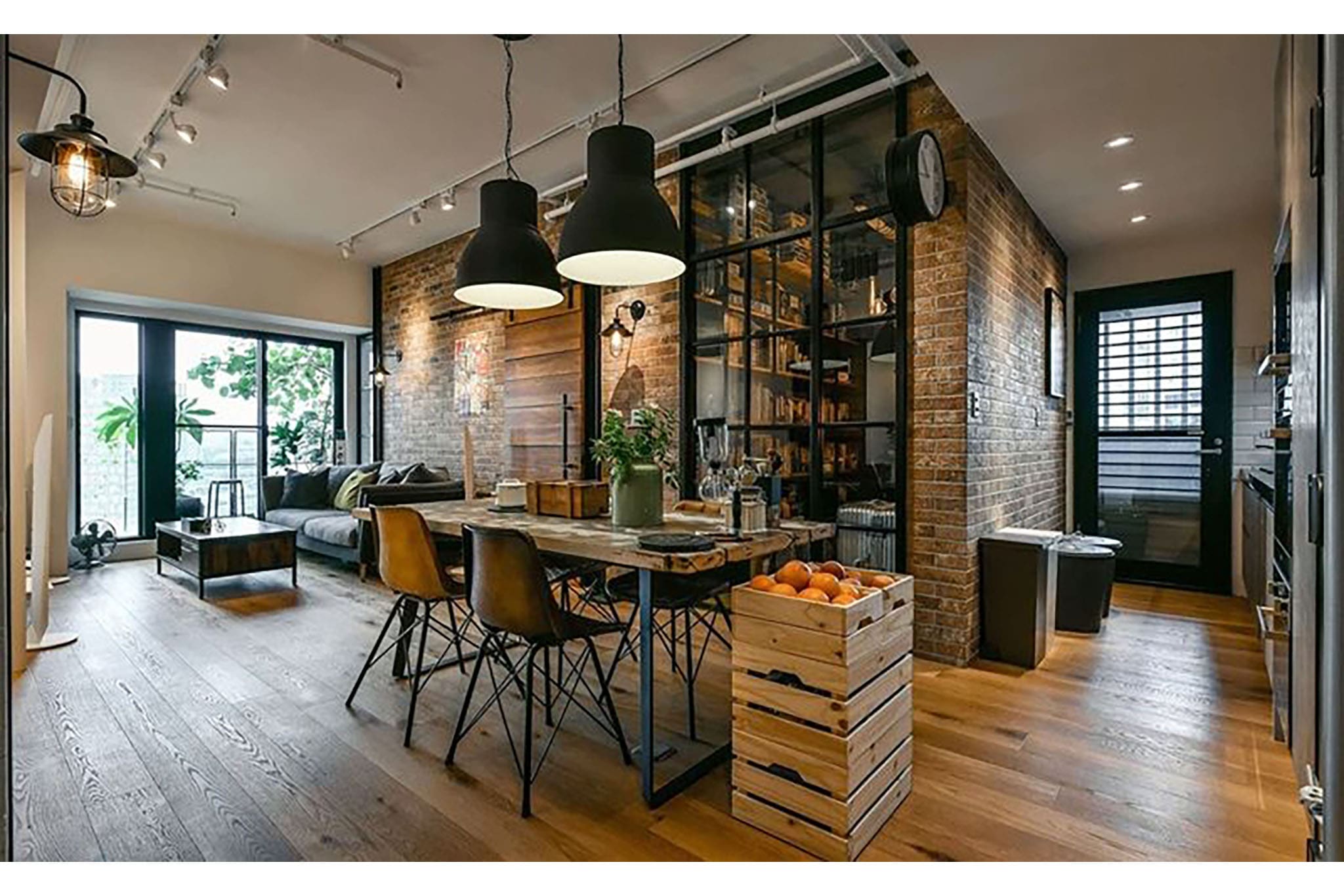
Loft - urban and creative
Special features: industrial scale, no internal walls, doors, partitions, moldings under the ceilings, open pipes and channels, a spectacular combination of brutal textures with examples of modern art.
The materials are concrete, brick, metal, glass, unpainted and unpolished wood.
The equipment consists of necessary things, large and massive, so as not to get lost against the background of the building.
The monuments include plywood shelves, anatomical chairs, stools on wheels and ladders. Leather-covered sofas and tables are arranged to zone the room.
The moody gray-brown scheme is enlivened by unexpected splashes of color: a bright carpet, a stencil on the plaster, several thick pillows.
Luminaires on handles, tripods or long lines are used to ensure the appropriate level of light.
Finally, contemporary alternative art objects are integrated with interior furnishings, and paintings are usually not hung, but leaned against them or placed on tripods.
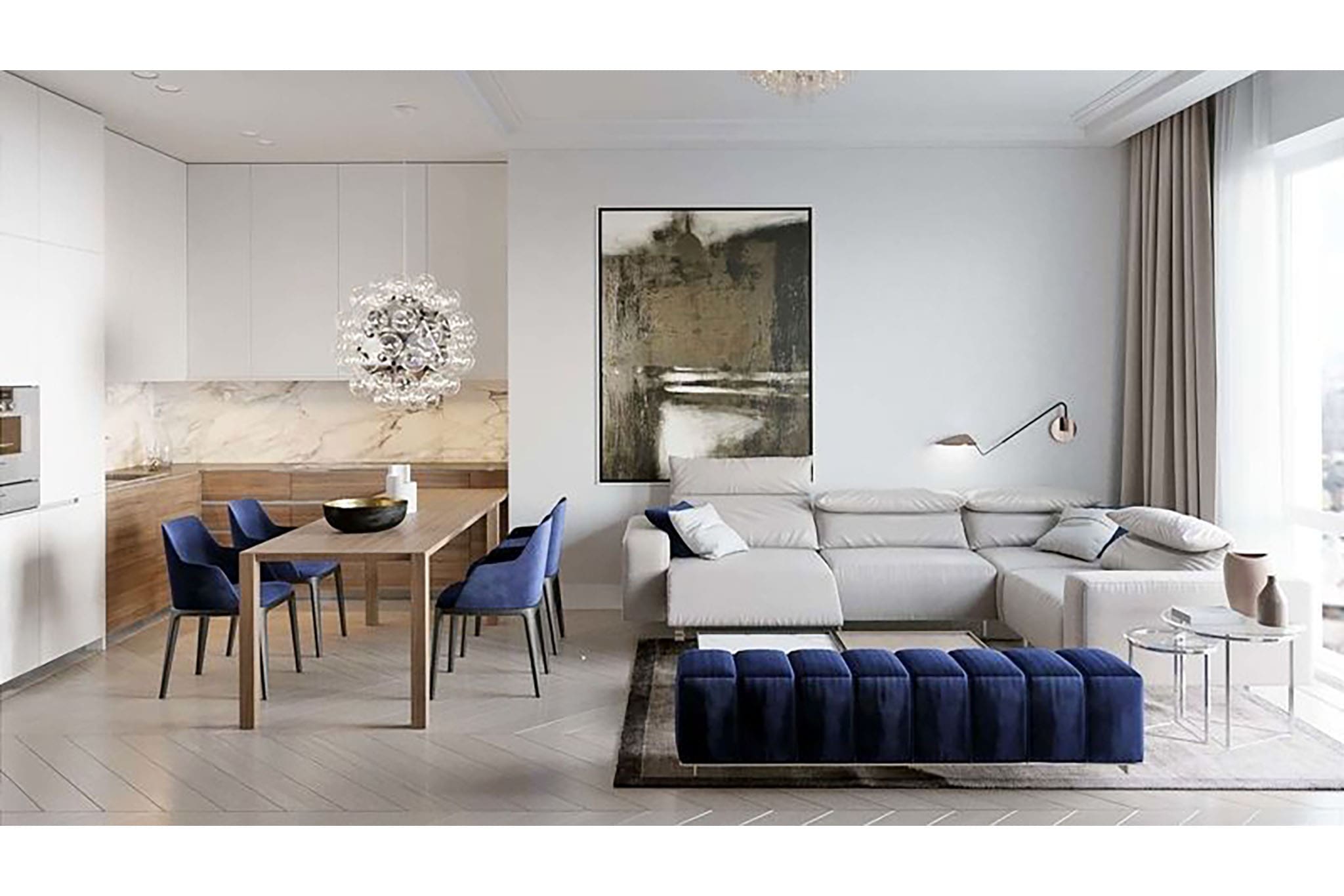
Lounge - calm and soothing
Special features: streamlined, physiological shapes, pleasant to the touch, generous textiles.
The colors are psychologically comfortable, dominated by natural, slightly dusty shades of white, blue, green, lilac and brown.
The equipment of the living room consists of frameless, the softest sofas or mattresses that adapt to the resting position, Bean Bag armchairs, chaise longues, hammocks, rocking chairs, pouffes and footstools.
The devices are intelligent, remotely controlled; the lighting is intimate, not disturbing during a nap. There are rugs (for laying on the floor), pillows and braids everywhere.
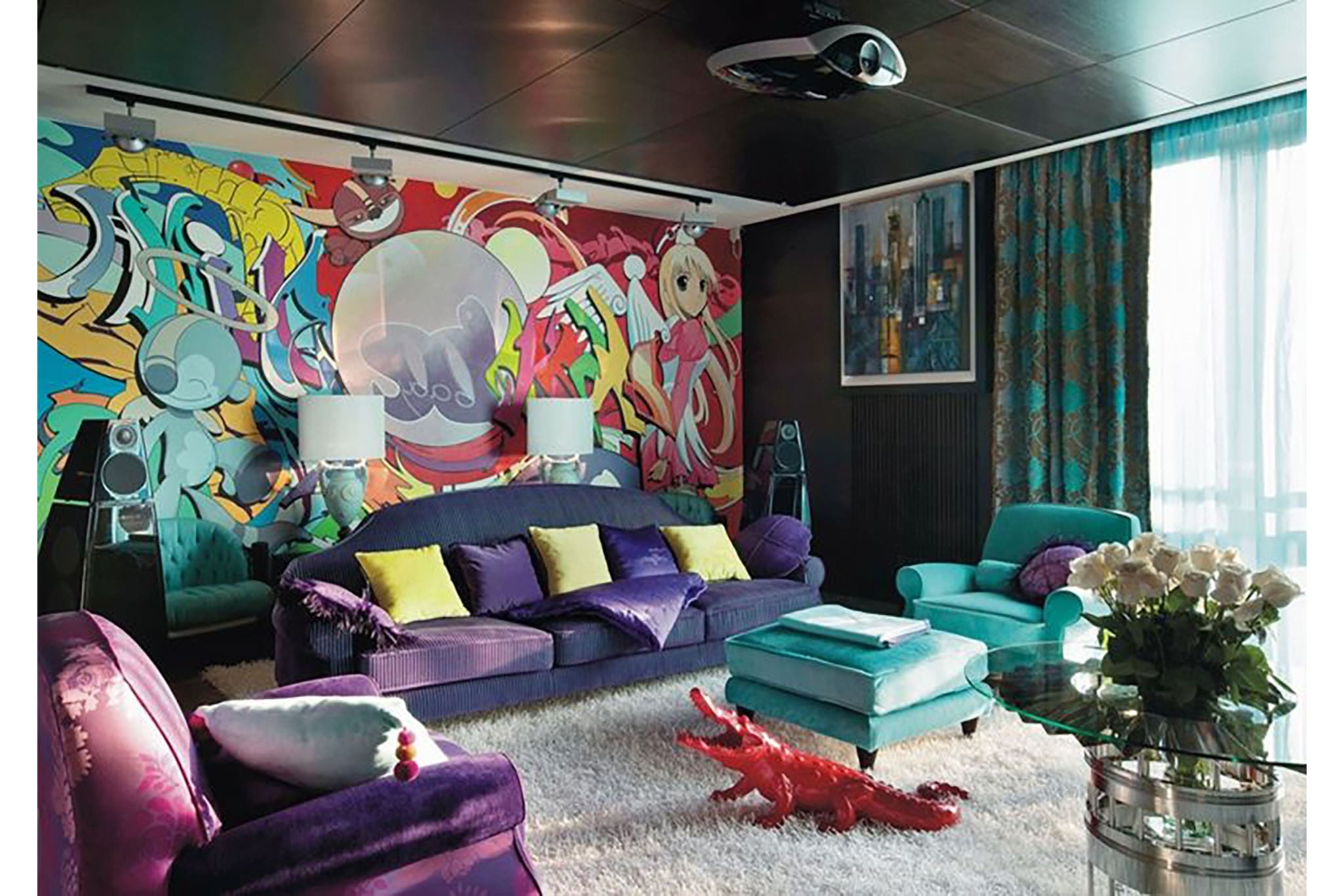
Manga - funny and intriguing
Features: Housemates' dedication to easily recognizable, beloved TV characters.
Since manga are very different, the materials, palette and additions are selected based on the specific genre, plot. And the interior is embodied by posters, photo wallpapers, moulages, figures of anime characters, graphics, hieroglyphs, pillows, Pokémon ... And huge plasma screens remembering that they are the door to anime series.

Mannerism – refined and impactful
Features: intentional disturbance of compositional coherence and balance, colorfulness, garishness and creating illusions.
We will not talk about the materials, because they are typical of the Baroque, in the womb of which Mannerism matured.
This style overuses intricate images full of hyperbole and allegory, intricate inlays, calligraphy and scrolls.
The deceptiveness and fickleness of being are emphasized by such techniques as false arches, false doors, windows, porters, sculptures, false frescoes and pseudo bas-reliefs. And all because Mannerism puts artifice on a pedestal, honors manner rather than substance.
The arrangement is illogical, the objects are arranged as if improvised. The furniture is patterned with incomprehensible emblems and fantastic characters.
The main colors are: gold, bronze, silver, scarlet, azure, peach and green.

Mediterranean - soothing and warming
Special features: natural, local raw materials, pure expressive colors, national motifs.
Wild stone, white plaster, oil paints, ceramic tiles, tiles and wood make up the "repertoire" of the decorator.
Sofas, loungers, chaise longues, rocking chairs and hammocks are added to the standard range of furniture.
White, linen, aquamarine, turquoise, menthol colors are used. The shutters, a Mediterranean attribute, are painted in a color contrasting with the walls.
The accessories and decor are identical to the local culture. In Tunisia, for example, houses are decorated with birdcages, in Syria with damask ornaments, and in Cyprus with Lefkari lace.
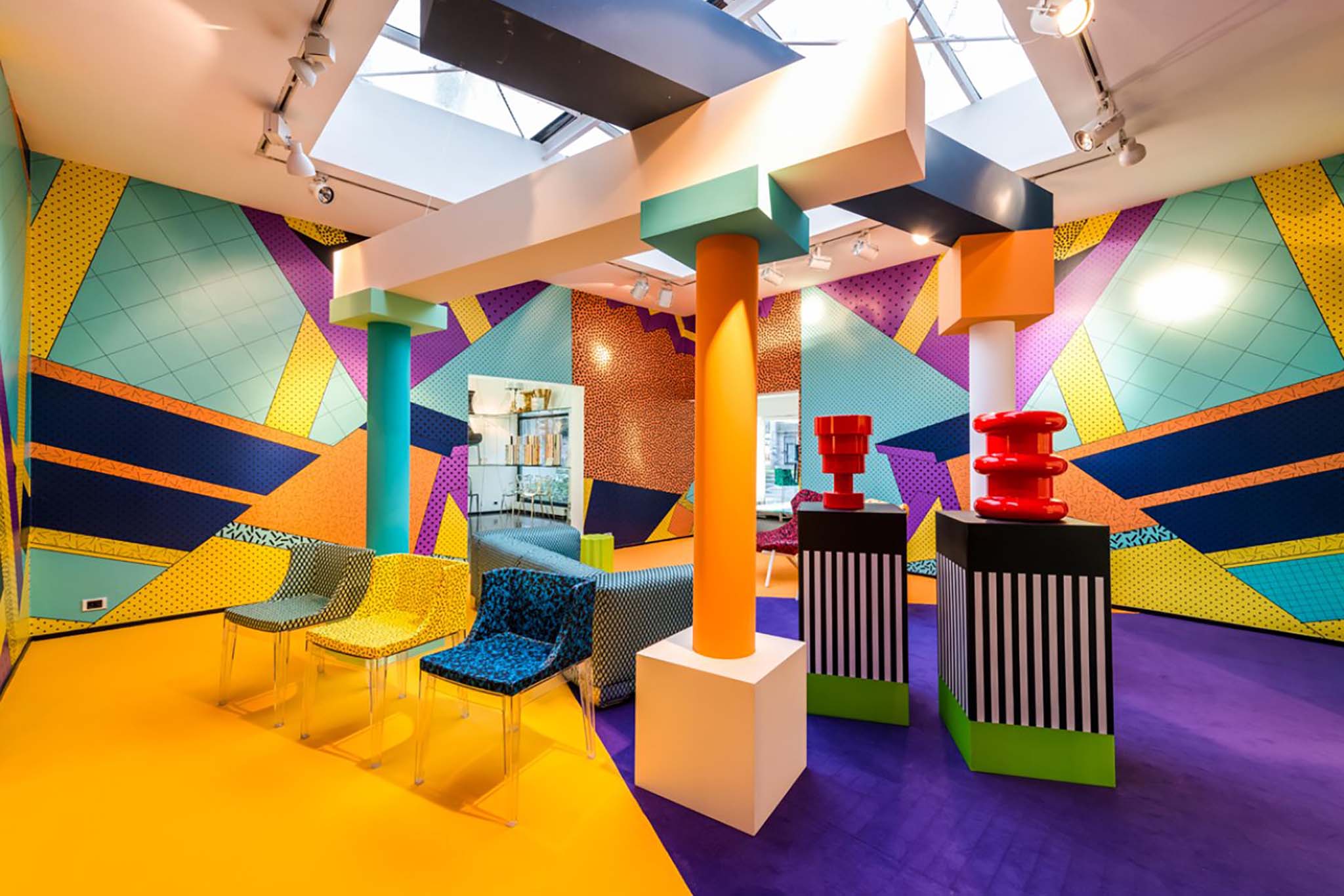
Memphis - bright and ironic
The Memphis group's fresh approach to design, characterized by creativity and humor, became a strong stylistic feature of the 80s.
There is a wide use of geometry and color here. The furniture is created using geometric shapes, combinations of various color combinations based on the "color block" principle, all kinds of ornaments and prints. Geometric shapes are preferred, but streamlined and smooth shapes are also often seen to create complex spaces.
The Memphis décor features unconventional shapes and a vibrant color palette. Ettore Sottsass was inspired by totems and created fascinating sculptures that catch the eye, and today the Memphis luminaire fulfills its basic function and looks like a work of art at the same time.
The color scheme of the style is cheerful, lush. If you complement any color and shade with black geometry, the details will gain clarity and contrast, so you can freely experiment with color in interior design.
Thanks to the Memphis style, you can easily create a space that is not boring, which is why this style is so popular today. Attractive colors, unusual shapes, ornaments, collages and bold combinations make it a comfortable space where you want to be and a positive atmosphere.
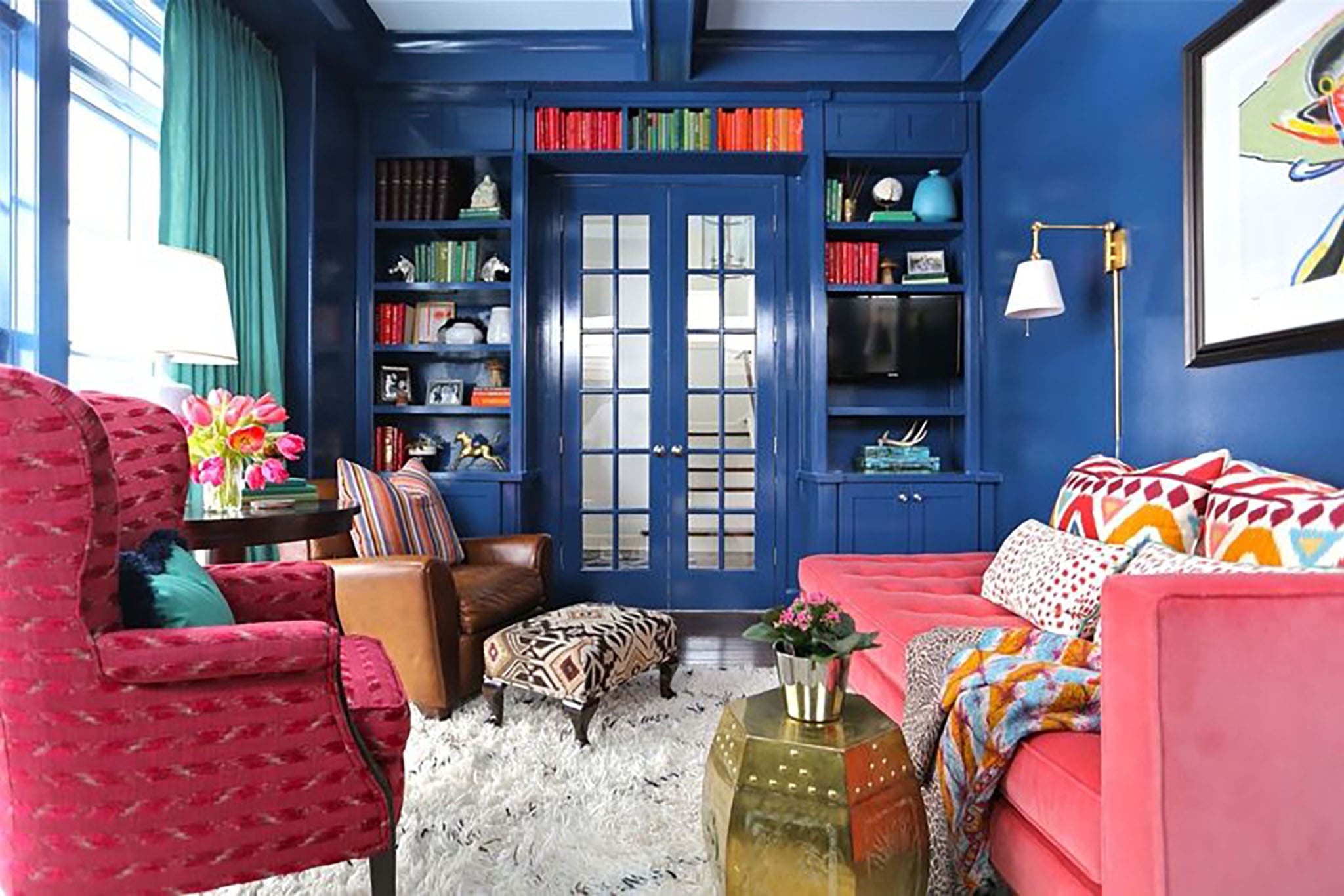
Mexican - magical and full of temperament
The characteristic features are niches, openings, Indian ornaments, juicy, melt-in-your-mouth colors and contrasts.
Materials - stone, wood on the ceiling, structural plaster on the walls, ceramic panels on the floor.
The furniture is low, stable: colonial sofas, chests, armchairs with light striped upholstery, chairs with carved backs.
The palette is carnival: shades of lime, indigo and hot pepper, blue, orange, intense green, pink ... And in one room you can combine three or more colors.
Accessories and decor - chain chandeliers, Indian rugs, palm leaf mats, pillows, unglazed clay pots, primitive paintings, cacti.

Mid-century modern - nostalgic and harmonious
The features of the design are sophistication, simplification of forms, geometric and abstract prints and the use of plastics.
Materials available, with mass demand: inexpensive wood, plywood, paper wallpapers, tiles, composites, practical textiles.
The furnishings are average. There are long sofas, desks made of polished dark wood, armchairs and holders on elongated, slender, straight or spread legs.
Floor lamps, aeroplanes and satellite lamps, round wall mirrors and short-pile carpets add a sense of wholeness and coziness. The decor is vintage: photo albums, artificial flowers, copies of classic paintings.
The range breathes peace, combining sandy, smoky grays and milky shades with inserts of olive, muted blue, mint and burgundy.
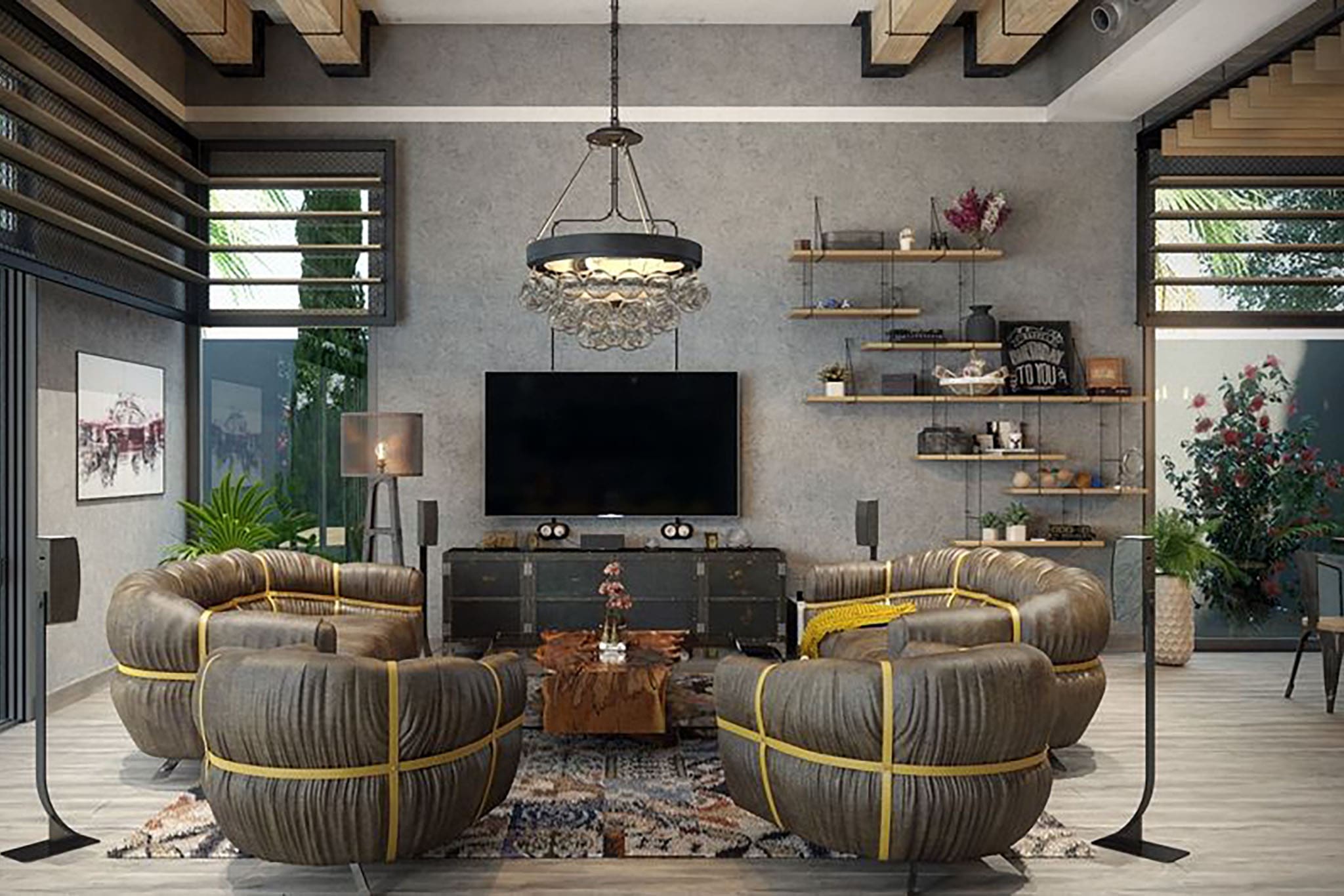
Military - tough and determined
Characteristic features: barracks simplicity, utilitarian furniture, "military" palette and military paraphernalia.
The materials are simple, matte: plaster, concrete, brick, wooden panels, sailcloth, amber.
The furniture is laconic and pragmatic, but not devoid of comfort: beds on pallets, springy leather sofas, large armchairs worthy of warlords, rectangular tables and bookcases.
Smooth lines, rounded curves, delicate shapes and "diapers" such as consoles, benches and fluffy rugs should be avoided.
The assortment combines shades of camouflage, grey, brown, mustard and navy blue.
A special role is assigned to accessories and decorations. In fact, only with their help is it possible to create a "combat" interior. Portraits of commanders, strategic maps, helmets and hats, and shell casings as pencil holders would work very well.
However, this style is plastic. It can be easily adapted to a teenager's room, as well as for a man who cares about his own status and prestige. In the first case, the interior is filled with figures of soldiers, micromodels of military equipment ... And in the second - there are crimson draperies, busts of marshals, binoculars, compasses, models of ships.

Minimalism - ascetic and self-sufficient
Features: principled rejection of furniture that is used occasionally, maximum open space, emphasis on quality, not quantity, narrow color range, uniformity of textures. The situation should therefore not look miserable, because the concept of minimalism is not a glorification of poverty, but a conscious self-limitation.
Materials can be chosen both natural, based on the Japanese model, and industrial, as suggested by Mies van der Rohe.
Furnishings account for less than 25% of the living space. All objects are simple, with clean lines and shapes, not bulky. Built-in wardrobes and shelves, pull-out sofas or futons, baggy and hanging armchairs are preferred.
The palette can go beyond the neutral spectrum and carry muted blue, burgundy, green colors.
The lighting scenario is complex, with light sources at different levels and hidden in the ceiling.
Only those things that are really dear to the heart have been left in the decor, and the style avoids objects that "catch the eye".

Modern - decadent and mythological
It emerged from museum halls in the 90s, and survived inside until the beginning of the XXth century.
Features: appeal to folk arts and crafts, curved lines, idealization of the past and mysticism.
Natural materials, natural “gray” colors and soft, rounded lines dominate the furnishing and decor. Design solutions in this direction are characterized by expressive floral motifs.
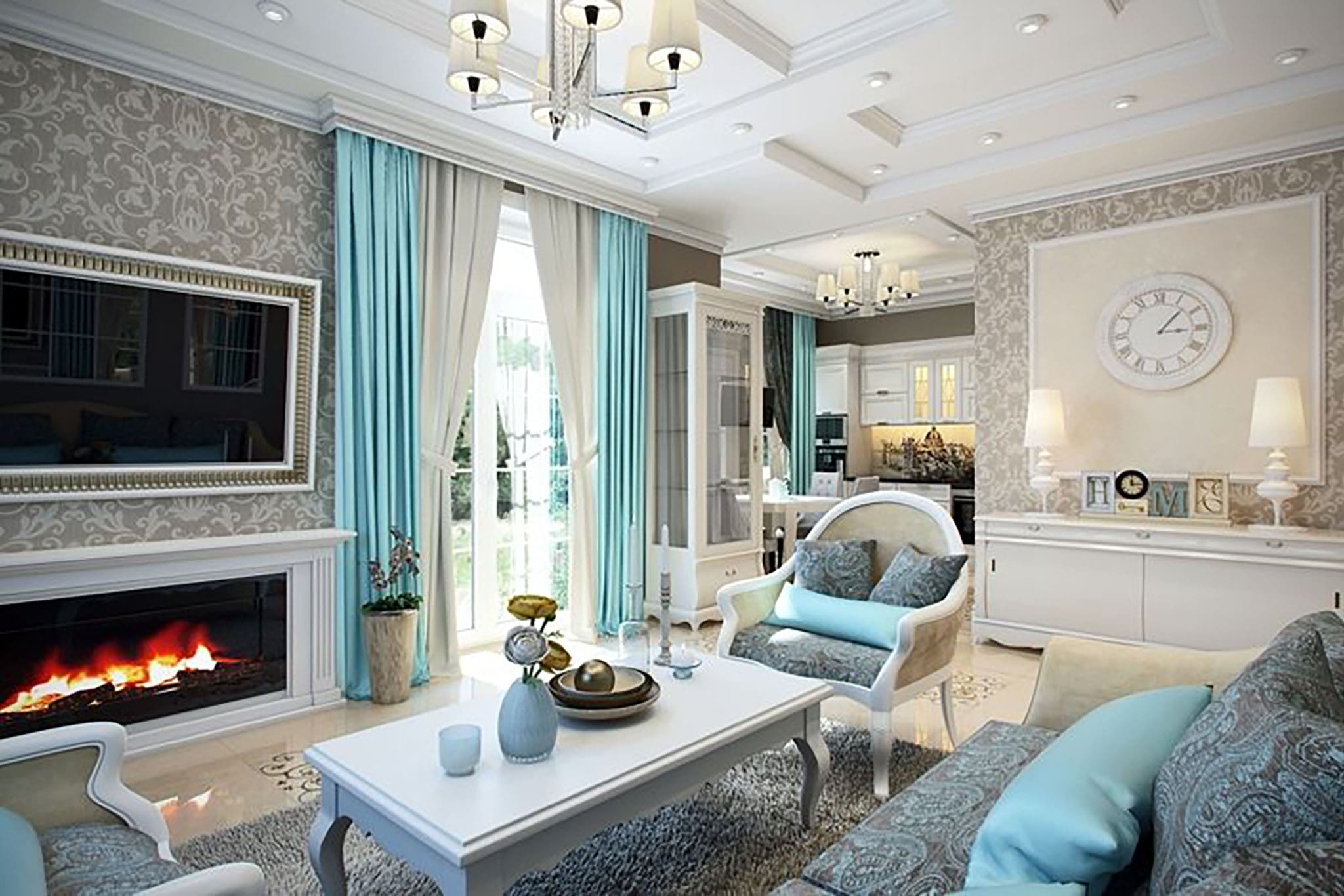
Neoclassical - noble and modern
Features of neoclassicism as an interior style - retrospective, symmetrical layout, simple but elegant forms, high-quality materials, non-irritating tones, moderate use of antique elements.
It's basically a classic with a modern interpretation. In the neoclassical interior, flowing lines organically combine with straight lines, antique furniture with fashionable furniture, and art objects with plasma screens.
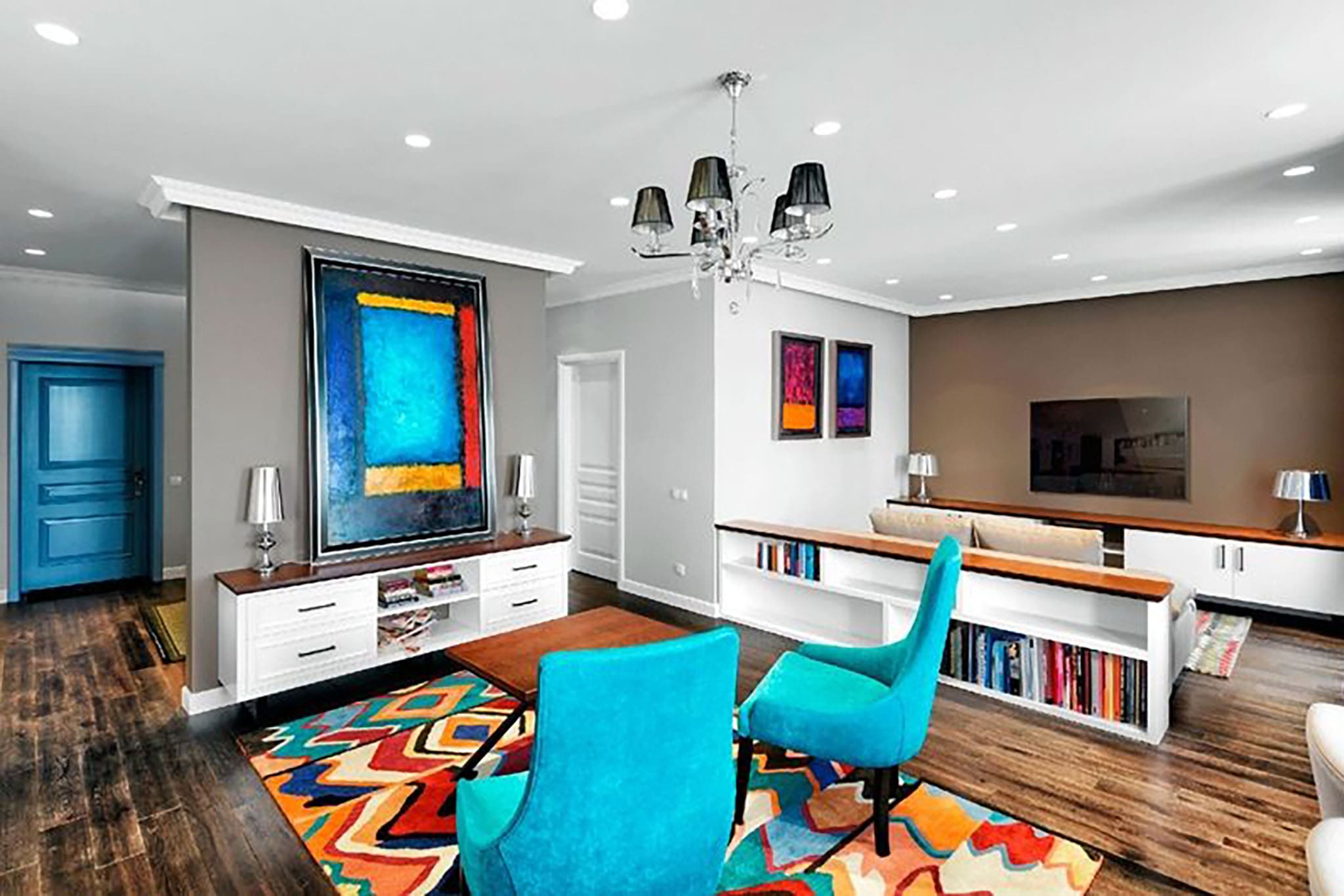
Onto-art - psychedelic and creative
Meneghetti believed that the human psyche is based on the same laws as art. The interior of onto-art became the materialization of this idea. Her goals are to help people understand and express themselves, to rise above the problems of the world.
Its main features are functionality, eco-friendliness, aesthetics ... And the most important thing is the involvement of art, the embodiment of its objects, the transformation of houses into a single artistic object.
Decorating tools are minimalist: brick, stone, plaster, wood, ceramics.
The furniture is eclectic, standard, everyday items are combined with bright, designer elements.
Inconspicuous colors alternate with vivid patches of pink, black, turquoise and fuchsia.
Accessories and decor are modern paintings.
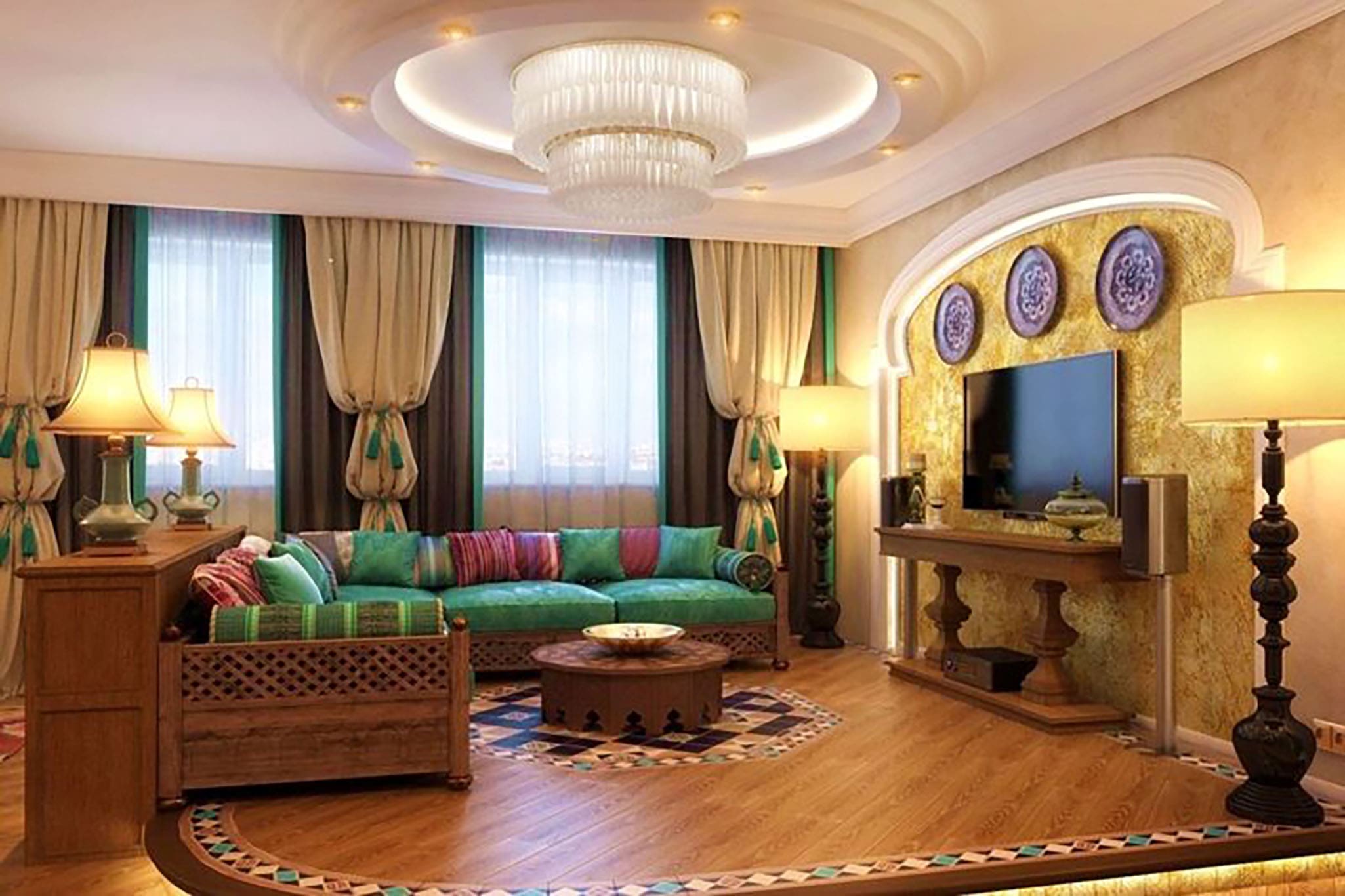
Oriental - captivating and sensual
Special features: shapely niches, "hot" colors, canopies, associations with eastern abundance, southern bliss, fairy-tale luxury ... And of course, arabesques on the walls and carpets.
The Arabic style is distinguished by a pattern called “girih“. It is made up of squares, circles and polygons, divided into parts by zigzags and stars. The ornamentation is dense, without breaks.
The Moorish (aka Moorish-Spanish) style manipulates a more ornate pattern where geometry is combined with flowers and leaves. It is dominated by shades of blue, turquoise, gold, brown and mustard.
Persian or Iranian ornaments contain elements of Arabic script, white, blue and yellow colors. And on Persian carpets, significant for the interior, there is a shoe pattern (oriental cucumber).
Turkish ornaments are less strict, in addition to blue and white combinations, green, red and purple colors flash.
The Moroccan style is different because it brings echoes of Berber and African culture. Her decorations are the most exuberant and multi-colored.
The oriental house does not have wardrobes, instead of them, niches are closed with stained glass windows or a lattice. Sofas, kilims and palases occupy almost the entire space.
Jugs, lamps, figurative chessboards and fruit vases adorn low carved tables. But paintings and statuettes of creatures are not allowed as "haram".

Ottoman - palace and harem
Its peculiarities are the synthesis of Arab, Byzantine, Indian and African cultures, laxity, traction, niches and openings in the form of lancet arches, fabrics pleasant to the touch, oriental patterns.
Materials include latticework, "lace" panelling, painted plaster, embossed velvet, screen printing, glaze.
The furniture is low, ottomans and footstools are carved and upholstered in brocade and satin.
The colors are fruity and noble: shades of pomegranate, peach, fig, gold, sapphire and crimson.
Accessories and decorations: Moroccan lanterns, damask blades, copper jugs, hookahs, "Aladdin's lamps".

Parisian - intelligent and lyrical
Features of the interior of Parisian apartments: careful preservation of history (capitals, pilasters, medallions), vintage "taste", unity of classics and modern trends.
Materials include plaster, herringbone brick, wood, patinated metals.
The furniture is light, with elegant silhouettes. Cult pieces such as bistro chairs, a painted chest of drawers, a console table, a table on wheels, open shelves or neat bookcases.
There is a lot of light in the palette, instead of a heavy chandelier there are lamps on strings of different lengths.
Parisian style doesn't have to be big. Entourage is created by combining something old, like a table with slightly used suitcases, black and white photographs, retro postcards ... and something new: conceptual sculpture or colorful abstraction.
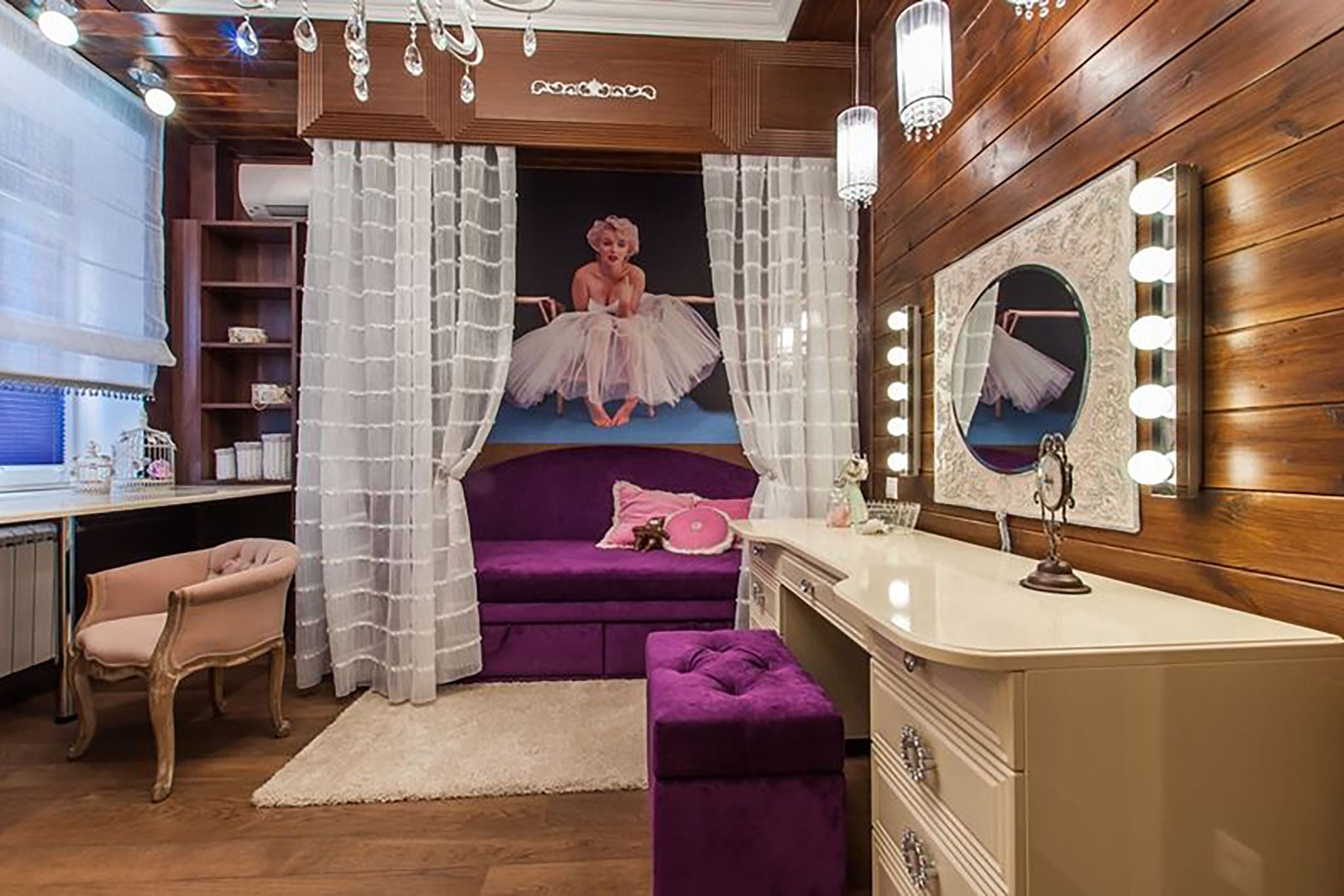
Pin-up: naughty and spicy
This style is characterized by an emphasis on American retro and pin-up graphics.
Furniture - sofas, armchairs, tables, truffles design 40-50 years.
The palette is pastel, with a mix of intense, ultra pink, lollipop and even acid colors.
Accessories and decor - Tiffany lamps, bright poufs, old dishes, soft toys. An indispensable element is also an illustration in the pin-up style.

Pop art - carefree and fun
This style is characterized by optimistic colors, gloss, pop culture icons and objects identifying with pop and movie icons.
The advantage is sliding furniture, couches, sofas, built-in wardrobes, serving tables on wheels.
The calm wood theme is cheered up by neon lights, bright pink, flashy yellow and bright green.
Accessories include Warhol-inspired comics and collages, autographed posters, Monroe and Mickey Mouse pillowcases and curtains, and spotlights.

Postmodernism - glamorous and extravagant
Features: free lines, expressive colors, contrasting textures, combinations of symmetry and asymmetry, simple and unusual constructions, the presence of stylistically unexpected objects - columns, a pseudo fireplace or a room fountain.
The materials are varied. The furniture is eccentric, its forms hyperbolic, sometimes grotesque, sometimes futuristic.
In the range of colors gold and silver, metallic, pearl and fluorescent are a must. The lighting is combined, with different types of lamps.
Accessories include vases, sculptures and paintings in sur.

Provençal - seductive and charming
Features: unity with the natural environment. The Alps provide a rustic feel, lavender fields and vineyards are reflected in the accessories, and the Côte d'Azur sparkles with colors. Overall, the style has an inherent balance of rustic simplicity and French elegance, flirtatiousness and practicality.
Materials include wild stone, stucco, glazed brick, wood and ceramic panels.
The furniture is wooden, with forged inserts and carved legs. Iconic elements are painted in light shades - an open cupboard and chest of drawers, a wide bed with an openwork headboard, wicker armchairs.
The textiles are light so as not to disturb the sea breeze. There are homemade mats and patchwork rugs on the floor.
The color range is delicate, tactile: shades of cream, lavender, mint, caramel, milk. The prints are small and modest flowers.
Accessories - a massive chandelier and sconces, bunches of marjoram and rosemary hanging from the beams in the kitchen, a panna-herbarium, slightly used cups and saucers on display to admire.

Ranch - simple and soulful
Style features: dull, bold textures, cowboy austerity, kitchen combined with a hall and dining room, zoning with large objects.
Sofas and chests of drawers are conventional partitions. The furniture is strong, squat, as if hammered into place by hand.
Accessories and decor: rocking chairs, clay dishes on primitive shelves, copper lamps, forged candlesticks.

Renaissance - sublimity and sublimity
The Renaissance, which lasted from the first decades of the XIVth century to the beginning of the XVIIth century, could not but affect the design of the rooms.
The characteristic features include a return to symmetry, tectonics, friezes, pilasters, columns, ordered arcades and decorated cornices.
The materials were polished stone, frescoed plaster and durable, mirror-smooth wood.
Craftsmanship reached its peak during the Renaissance, so the furniture is decorated with patterns, inlays, gilding, crosspieces, mosaics, rosettes, lion's feet and carved ram heads.
The furnishings include chests of drawers, brooches, armchairs upholstered in leather, velvet or brocade, beds with pillars and canopies.
Cassone and cassapañca, which served as chests, cabinets and benches.
Globes and manuscripts (Renaissance, Enlightenment), secular paintings and sculptures, crystal chandeliers and candelabra with many details complete the scenography.

Retro - cordial and romantic
Today, retro style is a personal "time machine" with which we can move to happier times.
Features: materials, furniture and accessories typical of the selected era. Not necessarily antique or vintage, just an imitation of vintage.
The range is friendly and close to natural colors. The decor is black and white photos in old-fashioned fold-out panels, books, cuckoo clocks and weights, and oil lamps.
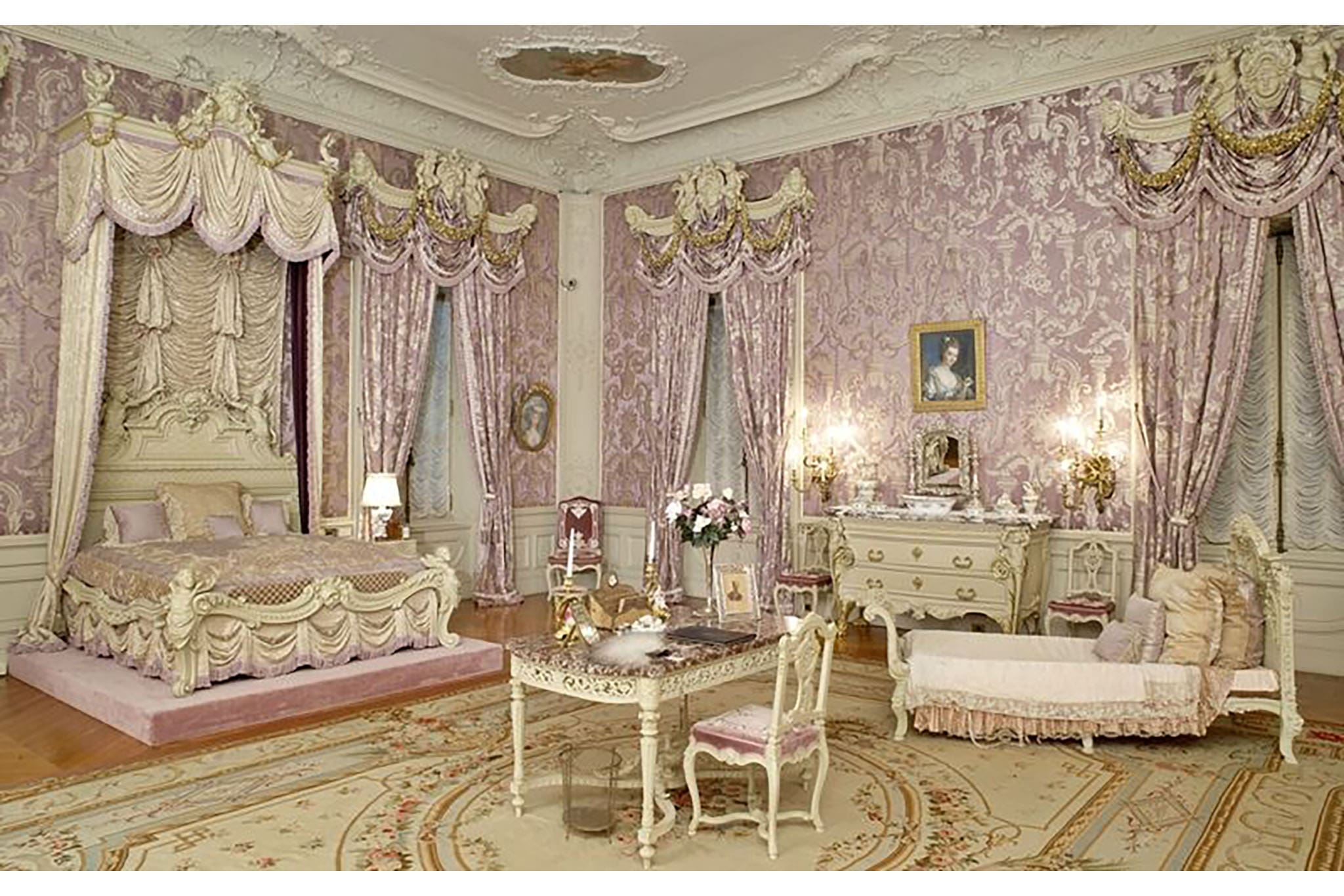
Rococo - intricate and careful
Its special features: bizarre, chimerical lines, ornaments of shells, cartouches and scrolls, abundance of nymphs, cupids, newts, dolphins, croissants, playfulness and frivolity.
The materials are the same as in the Baroque period, i.e. wooden panels on the walls, parquet and carpets on the floor.
The furniture is intricate with intricate carvings, inlays and gilding.
The palette is aquarelle and radiant: peach, pearl blue, smoky shades of green with the addition of silver and gold.
Accessories and decor - huge chandeliers, full-size mirrors, elegant statuettes.
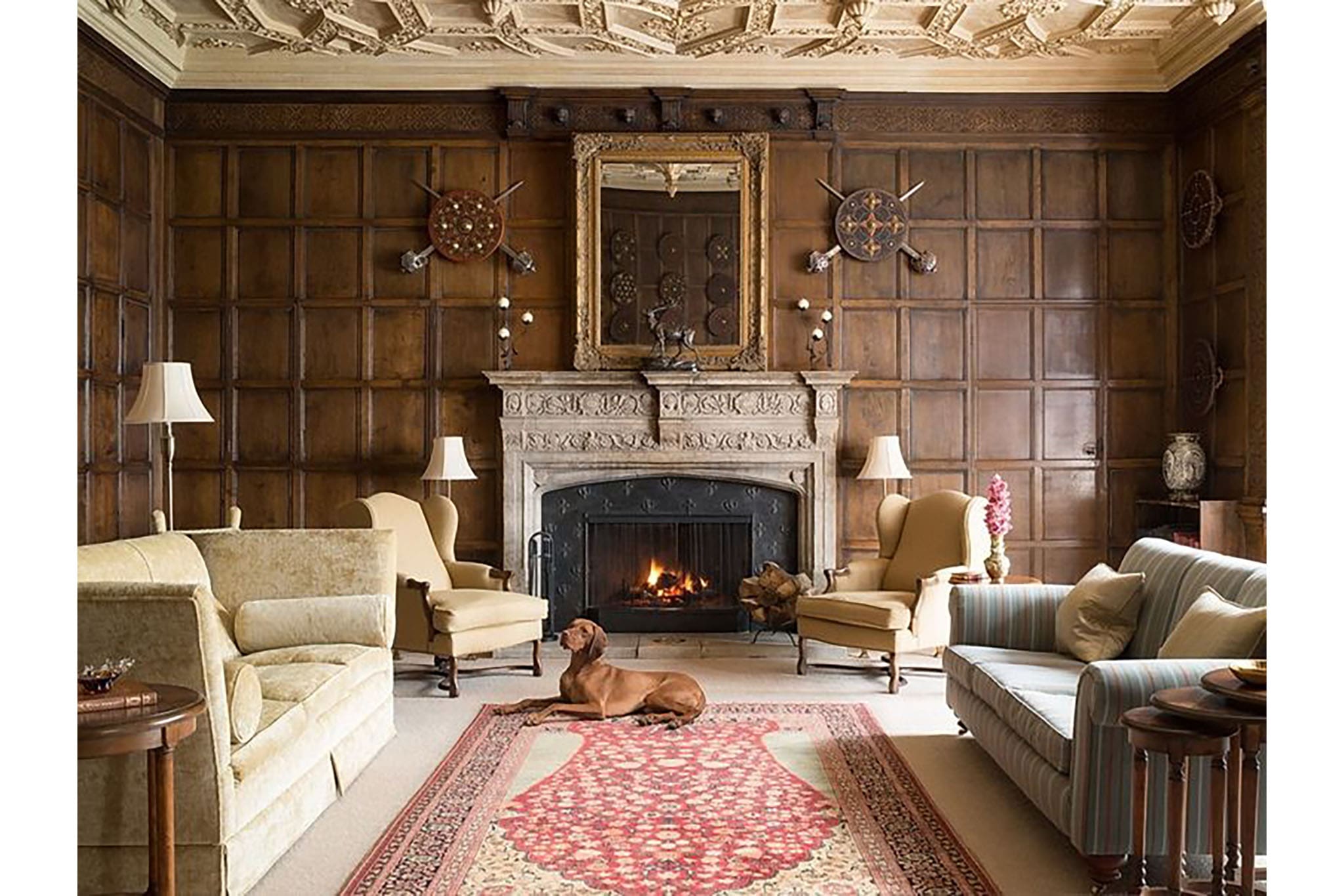
Roman - pressed and spectacular
Features: opulence imitating ancient Rome, composition, antique elements.
This idea is implemented through glossy plaster, polished stone, gypsum and ceramic tiles.
Furniture in ancient Rome was made of thuja, maple, ash, combining Etruscan primitivism with Greek nobility and Egyptian decor.
Tables on three legs, celium chairs, benches, wicker armchairs, stools and sofas are suitable.
Marquetry, engraving, figures of eagles, peacocks, winged lions and bronze inlays abound.
The palette includes alabasters, beiges and grays, shaded by blues, scarlet, violet and green.
Don't forget the burgundy curtains that resemble patrician cloaks, hidden lamps that diffuse the light, and busts of orators.

Romanesque - solid and shapely
Characteristic features are: fundamentality, seductiveness, conciseness, semi-circular arches, sparse finish, fireplace.
Materials: natural stone, solid wood, mosaic tiles.
The furniture is heavy and “forever”, square, rectangular and cylindrical predominate. The characteristic elements include benches, chests, monastery chests and rigid chairs with high throne backrests. Textiles are rare.
The palette is cloudy, as it should be in a tower, citadel or monk's cell.
Accessories and decor include a wooden or forged chandelier, bronze chandeliers, stained glass windows, porous clay jars and knight paraphernalia.

Romanticism - cozy and enthusiastic
The interior is characterized by plastic lines, arches, folkloric and floral prints and an atmosphere of haberdashery.
Materials - processed stone, light wood, white plaster, wallpaper with small floral patterns, simple fabrics.
The furniture has smooth contours and does not look massive. Two- and three-seater sofas, gramophones and sandwiches are covered with caressing leather velvet or silk.
The colors are "candy", "marshmallow", sometimes a bit juicy (the inserts are light pink).
Accessories and decorations include candelabras and lampshades, intimate musical instruments, lush curtains, fringed pillows and white statuettes.
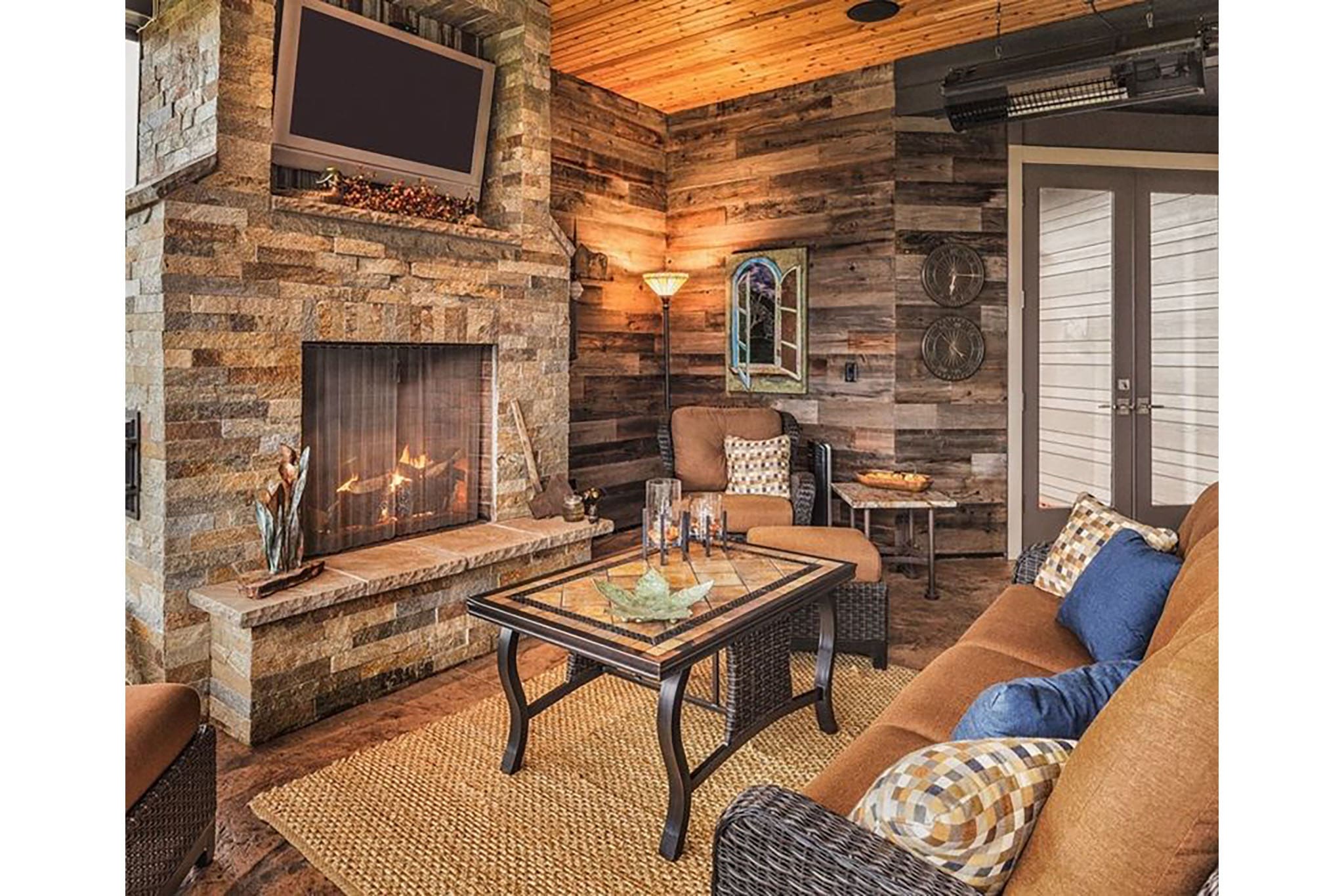
Rustic - uninhibited and immaculate
It is made of natural materials, accentuated roughness, reliefs and forms close to nature.
The rustic effect is created by rough-hewn stone, logs, unglazed clay and dark iron.
The furniture is handmade and large format. Tables, stools and even sofas look as if the owner made them himself.
Colors are dictated by nature, shades of wood, stone and terracotta.
Accessories and decorations include a wheel-chandelier on chains, wool braids, leather, examples of pottery and blacksmithing.

Scandinavian - democratic and friendly
Its peculiarity is ecology, naturalness, accessibility, minimalism, hand-made items.
Materials are light wood, plaster, paints, varnishes, cotton, linen.
The furniture is resistant to pressure, universal, mobile, and can be easily folded and unfolded.
The colors are clear, natural, without flashy accents.
There are plenty of light sources, and there are also windows that are not covered, but used if necessary, roller blinds or blinds.
Accessories and decor represent love for nature: straw baskets, bottles wrapped in wine, ceramic figurines, dried flowers and vibrant greenery. A typical Scandinavian “twist” is a picture of pets and a seascape.
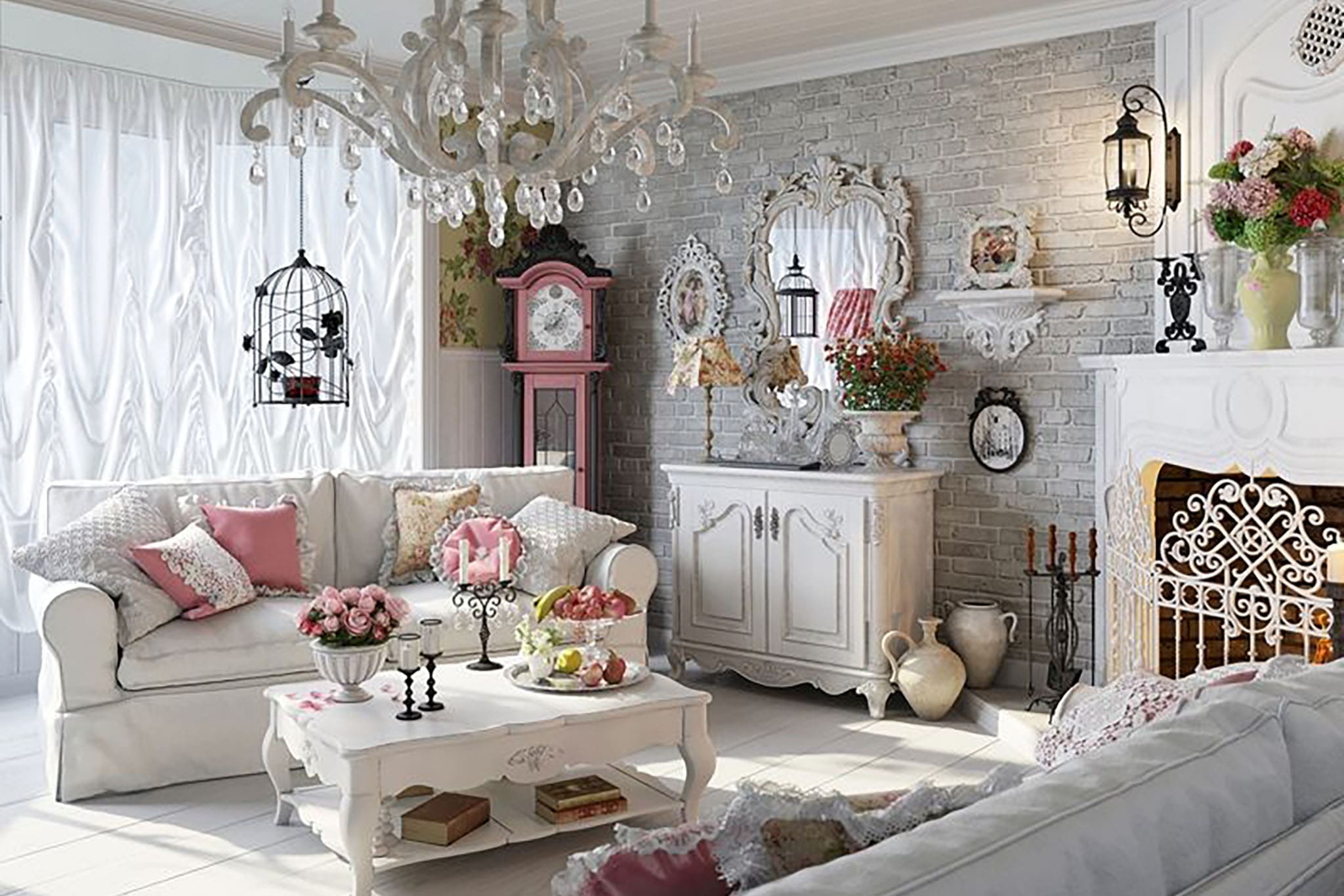
Shabby chic - charming and feminine
The interior is characterized by a vibrant spring palette, vintage floral decorations and old-fashioned decor.
The colors used are white, cream, pale pink, cream, mint, lilac and beige.
Furniture – plywood tables, decoupaged drawers or shabby suitcases, carved or painted chests of drawers, wicker armchairs, beds with headboards, forged elements, matted mirrors.
Accessories and decorations - textiles with embroidery, twill, faded lace, furniture covers with bows and frills, lampshades, artificial fireplaces with scented candles or dried flowers, birdcages, author's dolls.
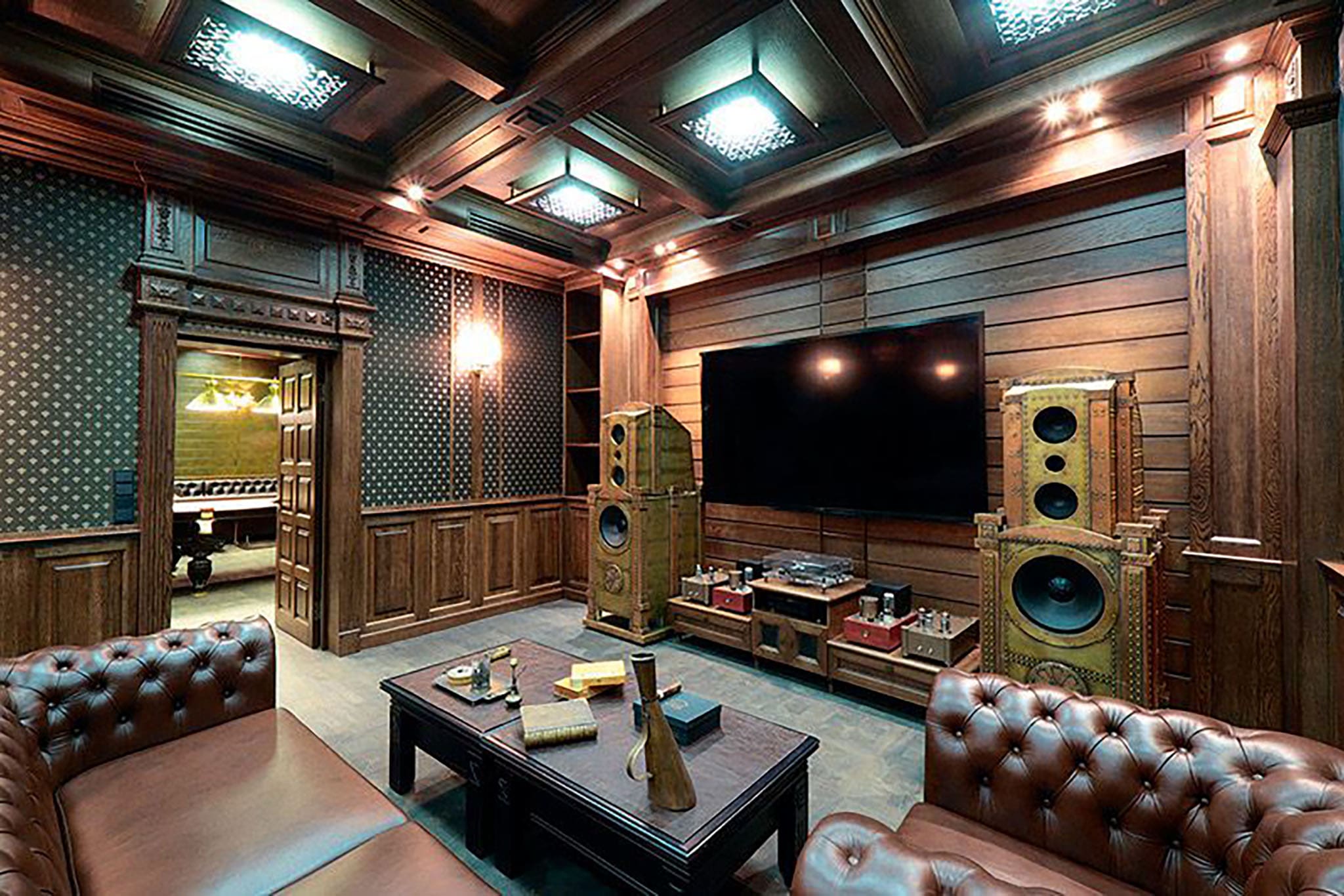
Steampunk - alternative and quirky
Features: retro-futurism, reference to the Victorian past, elements of fantasy, thriller and detective, dramatic, atmospheric colors.
The leading materials are a tandem of wood and metal, alloys and glass.
The furniture is a mix of industrial and Victorian styles. There are small sofas upholstered in leather, decorated with copper, brass nails, Viennese chairs, beds with metal studs, pipe racks, laboratory tables and workbenches. Analogues of songs created by cabinetmaker George Hunzinger are cult for this style. He made wooden furniture with mechanical elements, thanks to which they could move, fold and transform.
Steampunk interiors are dominated by the colors of brown, browns, muted reds, browns, nickel and copper.
Aerostats are suspended from the ceiling, and wall lamps in the form of gas horns hang on the walls. The benches and cabinets are decorated as telegraph and computer machines, communications as steam engines, and complete with anchors and pistons. Black and white portraits of fictional characters such as Sherlock Holmes, Captain Nemo and Frankenstein also fit into this intricate chaos.

Street - open and rhythmic
Features: urban planning, multidimensionality, energy, use of urban aesthetics.
The materials are ordinary - plaster, boards, wallpaper and paint. Palette to choose from - neutral or with fragments of bright color.
The furniture is modern and functional, yet simple. The standard set can be supplemented with an arched "boulevard" bench, a plastic table on a single support, a garden chair with a forged backrest.
Accessories and decorations - wall murals with city landscapes, areas of exposed wall or concrete, cabinets stylized as telephone booths, street lamps and floodlights, round "station" clocks, graffiti, neon signs, navigation signs.

Suprematism – active and eloquent
Characteristics. In the interior, Suprematism manifests itself as in art, through straight lines, squares, rectangles and triangles, circles. Their juxtapositions are contrasting not only in form but also in colour, which creates dynamism and passion.
The materials are secondary, using wood, plaster, cladding boards, laminate.
The furniture tends to have a primitive geometry; tables, armchairs, shelves, platform beds in the form of squares and rectangles, “one-legged” stools with perfectly round seats. The equipment strives for minimalism, because suprematic forms need space.
The colors were taken from Malevich's paintings: white, grey, graphite, concentrated blue, red and yellow.
Accessories and decorations include lamps with clear lines, black and white photos and objects of contemporary conceptual art.

Techno - rational and categorical
This trend is characterized by metal and metallised surfaces, geometric shapes, an open plan without partitions, reminiscent of bunkers and hangars, and unmasked communication lines.
The raw materials are concrete, brick, raw plaster, perforated and corrugated sheet, stone tiles.
Furniture includes metal safes and containers instead of cabinets, spiral stools, tables on wheels, chairs with metal frames and sofas with synthetic covers with pockets for dimmers and consoles.
The colors are cool and understated: grey, steel, brown, burgundy, camel and khaki.
The lighting is versatile, with hanging, built-in and floor lamps featuring tripods, clothes pegs, timers and variable intensity modes.
Accessories and decor - fans, motorcycle models, glass flasks and some colored plastic: a pen holder, for example.
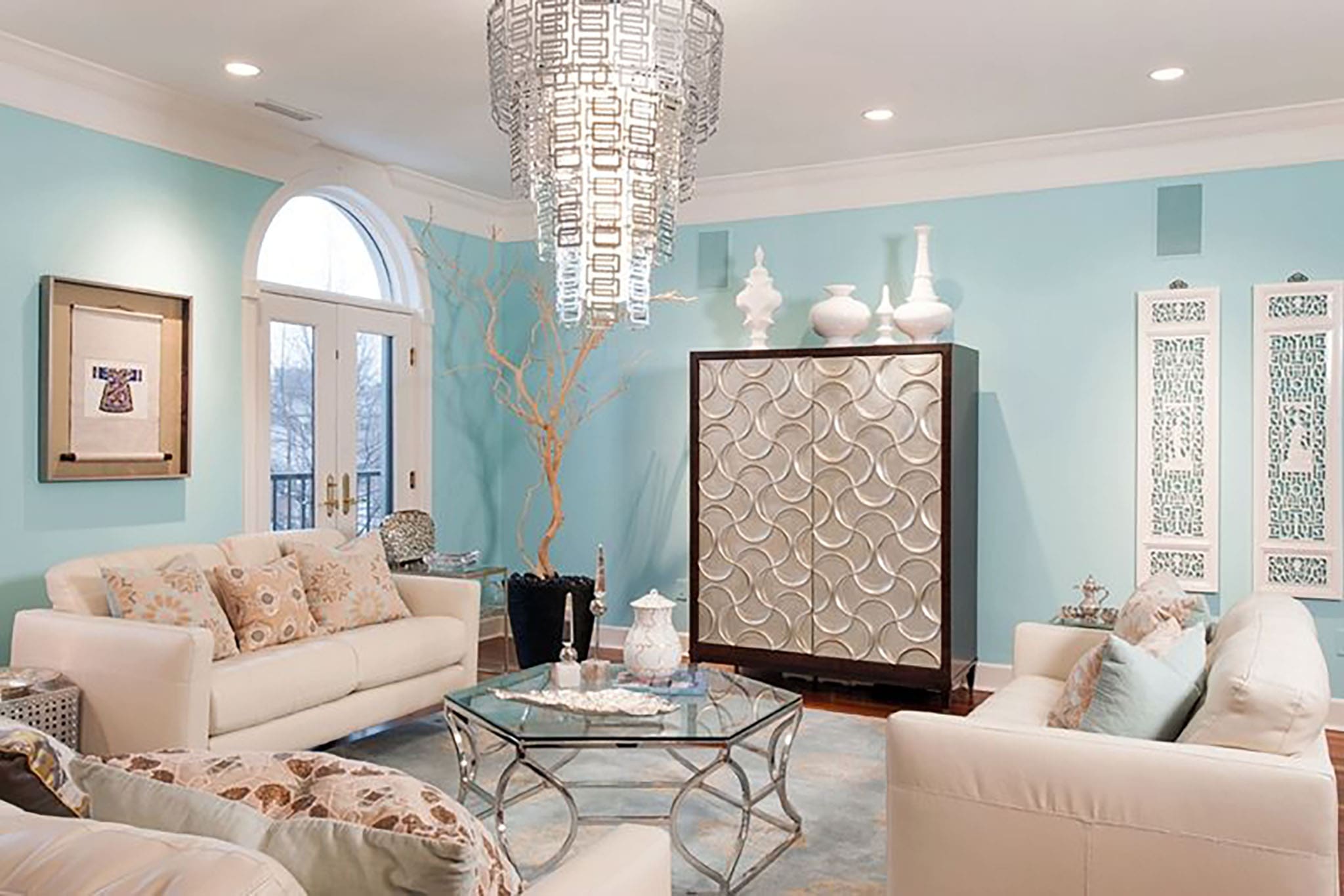
Tiffany - sophisticated and sociable
It has Art Nouveau echoes, Art Deco influences, a palette and decor associated with Tiffany jewellery.
The materials are both natural and synthetic, but of high quality and uniformly smooth in texture.
The furnishings are classic.
The color range includes white, silver, beige and coffee shades with broad strokes of turquoise, Tiffany's signature color.
Accessories and decorations include lamps with stained glass shades, discreet striped textiles, mirrors and vintage bottles.
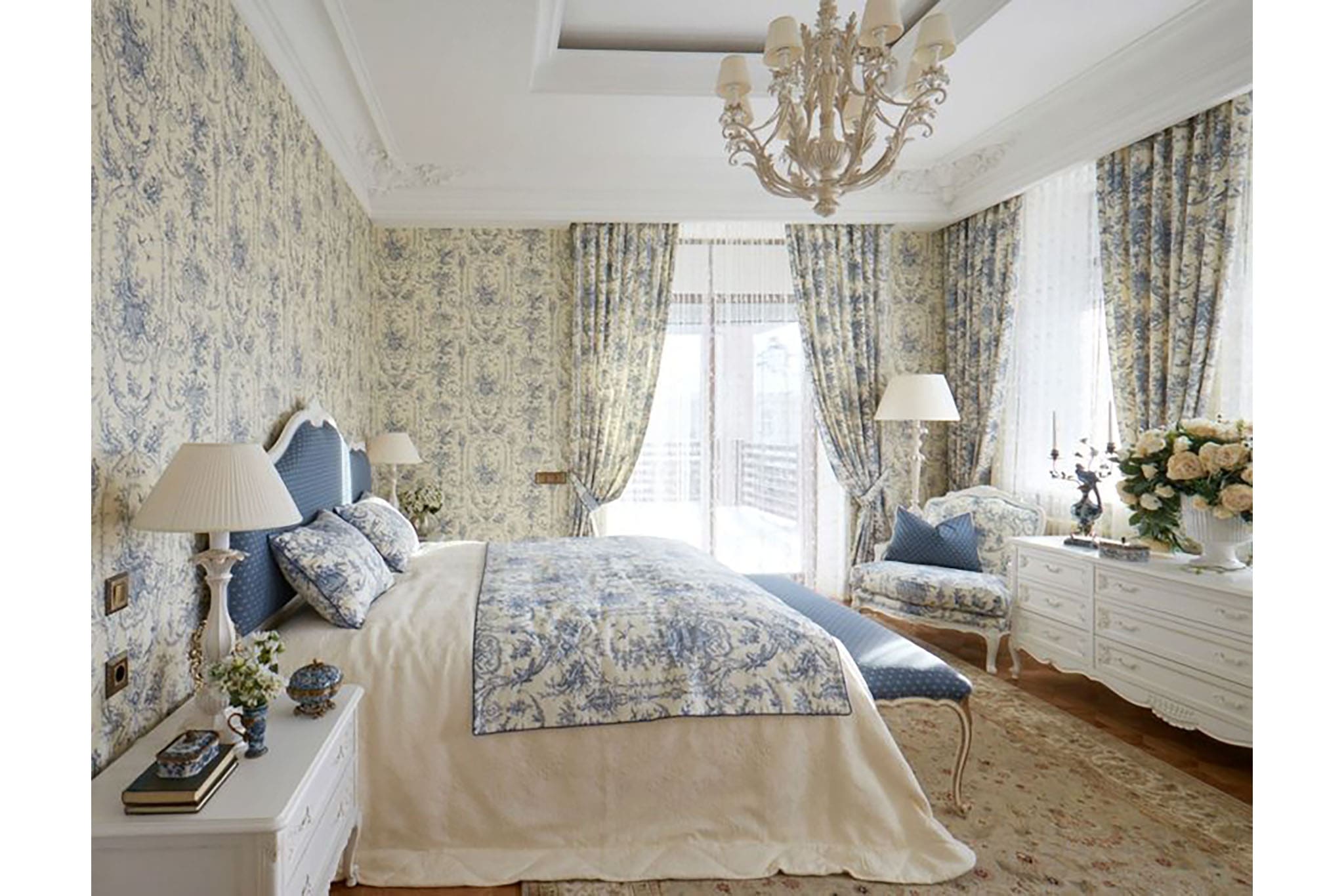
Toal de Jouy - colorful and resistant
Peculiarities of the Jouy style: extensive use of natural printed and painted fabrics.
Materials include stone, brick, stucco, wood, cotton, linen, chintz, jacquard.
The furnishings can be classic, baroque, or orientate towards rustic country and provincial styles.
The palette is summery and moderately colourful, with dominant shades of rose, lavender, buttercup and forget-me-nots.
Accessories and decor elevate and continue the floral theme. Curtains, lampshades, tablecloths, covers finely painted in bouquets, vignettes, shepherd and hunting scenes.

Venetian - refined and artistic
It is characterized by volume, sophistication, columns, arches, niches, Renaissance reflections on each object.
The floors are patterned marble, the walls decorated with plaster, the ceilings painted.
The colors are complex, with neutral, pastel, saturated colors - violet, deep green, blue.
The furniture is wooden with plastic silhouettes, the backrests of the chairs and sofas are semi-circular, with forged elements and Murano glass.
A chandelier in the form of a crystal waterfall illuminates the specific decor: antique maps, telescopes, globes, Venetian masks.

Versailles - arrogant and vain
Features: the principles of classicism, the spirit of the Renaissance, Baroque techniques; artistry, historical value of the main objects.
Sophisticated, aristocratic colors: gold, pearl, turquoise, mauve, azure.
Materials: hardwood, decorative plaster, parquet, stucco plaster, silk, satin, organza.
The furniture is sybaritic: opulent sofas, swans-shaped cofts, camp sofas, Voltaire armchairs.
Lamps of luxurious baroque shapes and sizes, jewelry chests, snuffboxes, music boxes, writing instruments made of jade, onyx and ivory add courtly atmosphere and charm.

Victorian - ambitious and enlightened
The features are an imitation of earlier historical styles from Gothic to Rococo, seasoned with ethnic influences from the colonies.
Victorian houses are salons decorated according to classicist theses, gothic libraries, neo-baroque bedrooms, Chinese, Indian and Moorish offices.
The industrial boom and machine production displaced expensive timber; paper wallpapers and plywood boards appeared in the finishes. But the value of materials was increased by ornamentation: embossed and gilded fern leaves, exotic birds and flowers. The fireplace with a forged grille is also important.
The colors are a range of browns, delicate shades of cherry and green.
The furnishings are lavish, with an emphasis on British-loved armchairs and sofas. The decor is diverse: mirrors, paintings, gilded sconces, family silver, native handicrafts.
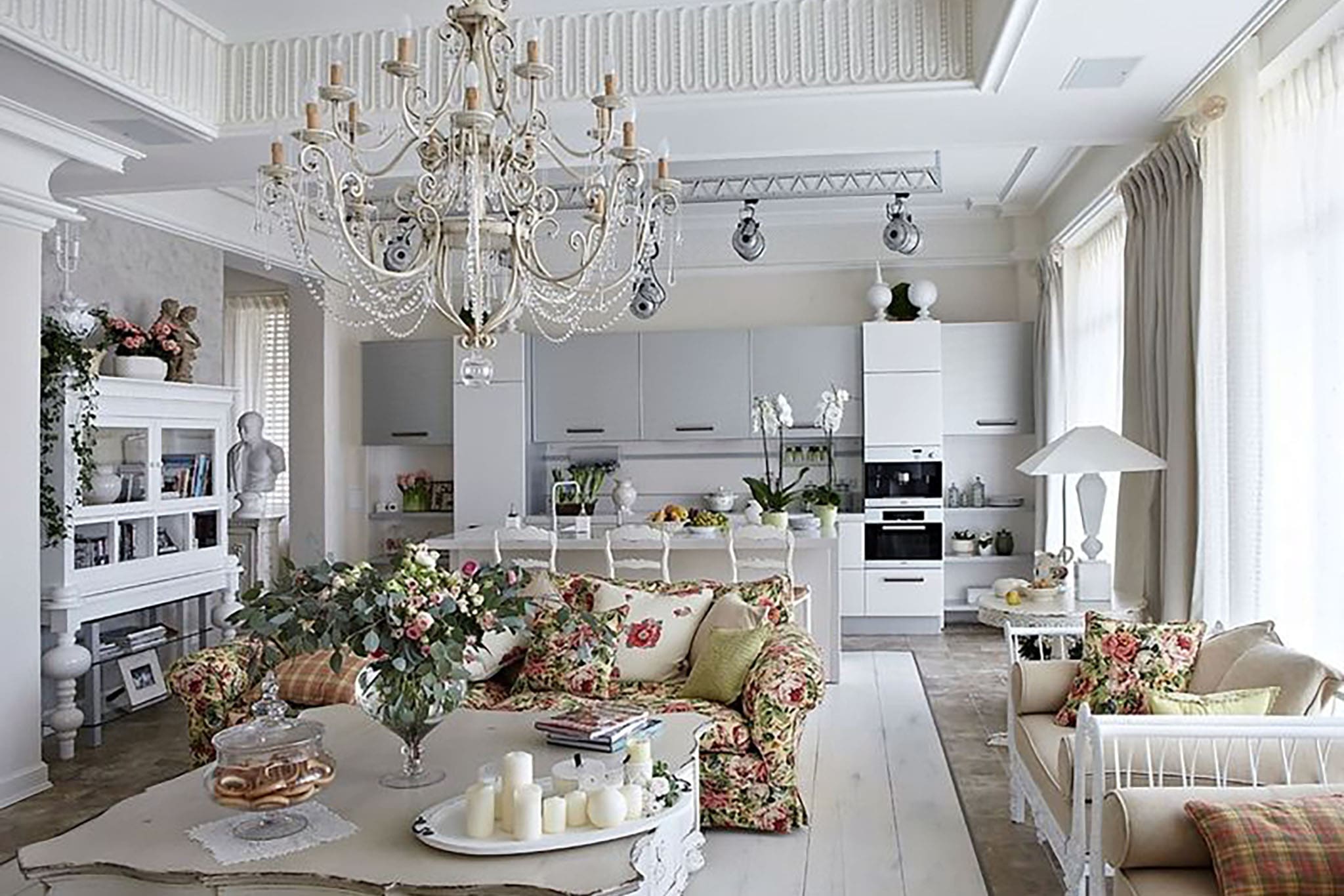
Vintage - dreamy and elegant
Characteristic features: materials characteristic of the selected era, carefully restored furniture and accessories that fit into the spirit of bygone years and evoke nostalgia.
The furnishings are carefully and lovingly completed with typewriters and telephones, battered books, porcelain dolls and yellowed photographs.




